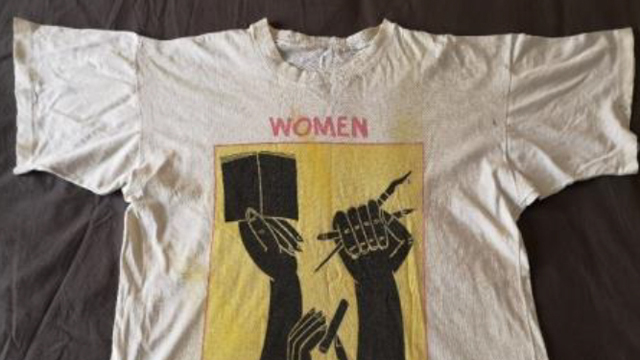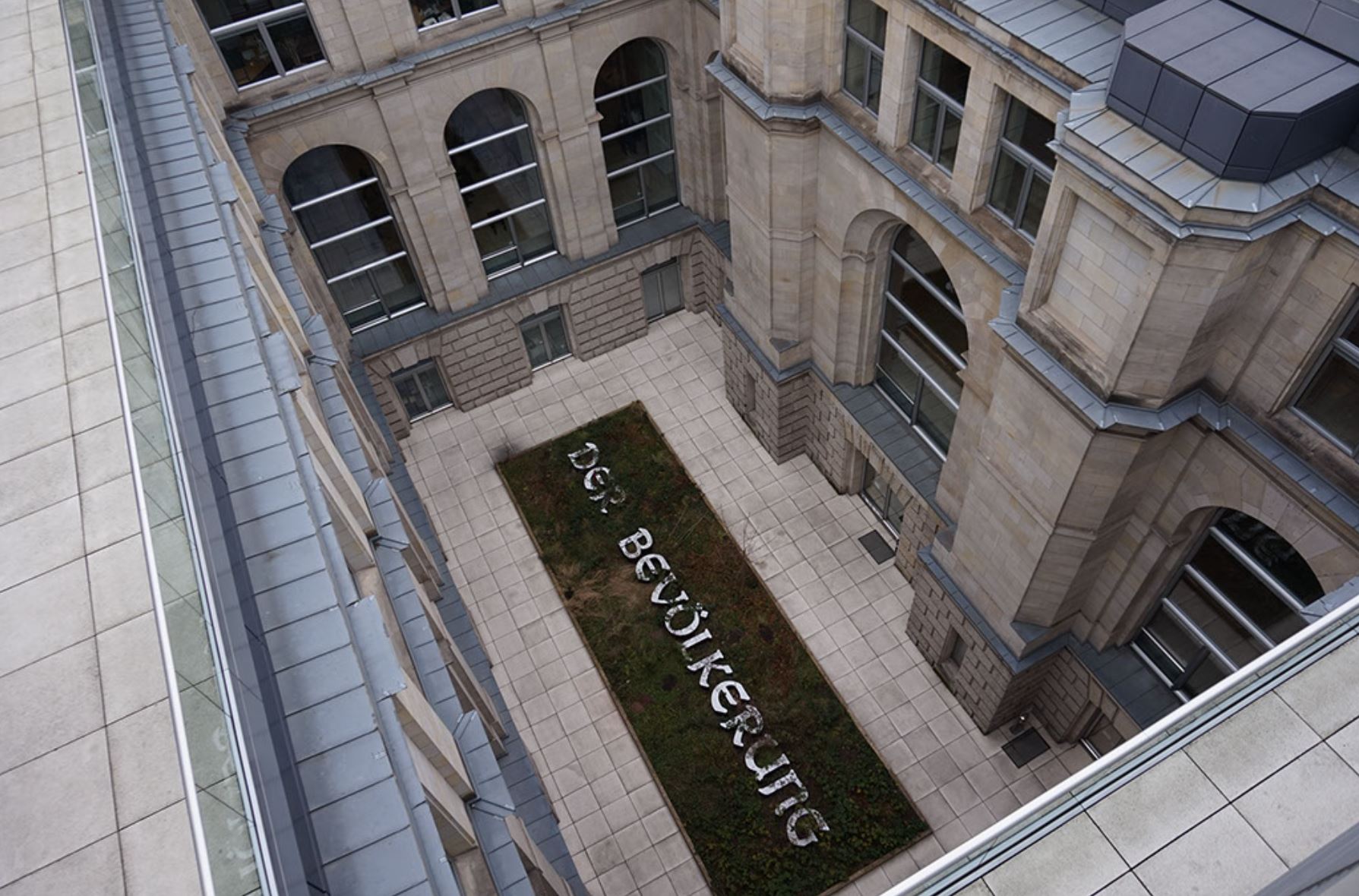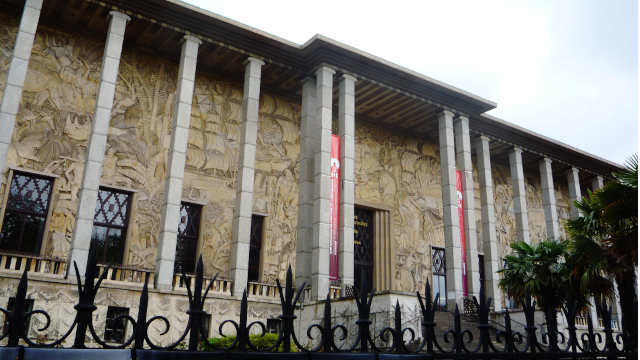Dear user,
This section of our website forms the heart of the EVC project. Here you find a collection of images of objects from different ‘visual cultures’. Our contributors selected and interpreted them in their respective contexts believing that these objects are particularly important for intercultural understanding across boundaries. Each time a user opens this page, the order in which the objects appear changes. In this way we hope to avoid a hierarchical understanding of the collected objects as their entries continue to be accessed in the long run. The constant changing face of the page also reflects the continuous expansion of the collection. As there are already over more than a hundred entries, users may want to form an overview, or to navigate through the growing collection according to their interests. For this purpose, we offer the following search options:

Filter: This enables you to search for objects according to time, place, keywords, etc. / Free title search: If you know the title of an object, you can find it in the free search field. / Lab: In the lab section, objects from the database are grouped under overarching themes. This is an ongoing project and about to be expanded extensively.
Enjoy exploring our database!

-
 Dong Xiaoling
Dong Xiaoling"Father” is a huge portrait created by Luo Zhongli (born 1948) in 1980. The picture shows an elderly man with dark skin and fine wrinkles on his face wearing a white headscarf. He is holding an old bowl containing tea in both hands. The old man’s fingers are rough, there is still dirt embedded in his nails and there is dirty gauze wrapped round his fingers. He has only one tooth left in his mouth. In the wrinkles on his forehead, on his brows and on the end of his nose there are glittering beads of sweat. This is the typical image of industrious peasants in China.
The importance of farmers was of great significance in China in the 20th century. Mao Zedong's assessment of issues concerning Chinese farmers commenced with the establishment of the People's Republic of China in 1949. Before the founding of the People's Republic of China, the peasants were liberated through a political revolution centered on the Agrarian Revolution; after the founding of the People's Republic, the common prosperity of farmers was achieved through the modernization of rural socialism. The role of the farmer changed from a participant in the revolution to a builder of modernization. Farmers were an important political foundation in the Mao Zedong era. Even today, there are still about 600 million farmers in China.
As a result, most of the works depicting farmers were created after 1949. Regarding the painting “Father”, the portrayal basically conforms to the definition of ordinary farmers. With the change of context during history, the visual interpretation of identity is very much influenced by the opinions of the post-modern.
Farmers are considered to be the people society relies on for a living – that is the reason why the artist named his work "Father". The model for this work was a farmer in the Daba Mountains in Sichuan province of China. The Cultural Revolution began in 1966. Mao Zedong advocated that young people from the cities should go to the countryside to receive re-education through hard labor. In 1968, Luo Zhongli, who was studying at the High School attached to the Sichuan Academy of Fine Arts, went to the Daba Mountains and stayed there for nearly 10 years. One Chinese New Year's Eve he saw an old man squatting outside a public toilet, guarding a pile of faeces as if he were guarding something of great value.[1] This image of a peasant bearing the burden of humiliation made a deep impression on the artist's mind. In 1980, when the artist was a student[2] at the Sichuan Academy of Fine Arts, he created his work “Father” by combining the image of Deng Kaixuan[3], an old man who was the artist’s landlord in the Daba Mountains , with the memory of the old man who had been guarding the pile of faeces. In 1981, Luo Zhongli was awarded the gold medal in the Second Chinese Youth Art Exhibition held in Beijing.
Controversy caused by "Father"
Today, the people viewing this large-size portrait may not be able to imagine what the people felt 40 years before when they stood in front of the large-size portrait “Father” for the first time. Those people experienced a visual shock and an impact to their values when they first saw this over 2-meter high portrait of a farmer. At that time, people were used to seeing the huge portraits of Mao Zedong or Marx only, and the monotonous idealized paintings of workers, farmers and soldiers.
During the Cultural Revolution, works of art were of the "revolutionary romanticism" style that is red, light, bright, tall, large, and full. A picture was required to contain brightness and sunshine as well as strong colors, especially red, and even shadows were not allowed to be painted in cool colors. The characteristics of such a picture is vividness and fine detail, and there are almost no traces of the brush. The themes of the works are mainly revolutionary idols and the history of the revolution. In this artistic style the happiness and prosperity of the country and the people are praised. This form of painting depicts a paradise full of sunshine and no pain, a utopian world of social optimism and revolutionary idealism. The depiction of Mao Zedong was always as an extremely tall well-built man in the center of the picture, in fact completely the image of a supernatural god. Mao Zedong was worshipped as an idol.
As an intellectual, Luo Zhongli had his own interpretation of this. "True and benevolent farmers and the like make me feel that there are people whose nature is unpolluted. The people are simple, honest, rustic. ‘Men of the earth’ with soil permanently under their fingernails. This kind of simple, down-to-earth nature often makes me feel ashamed".[4] The artist makes use of a huge portrait, a method traditionally used in nation leaders' portraits to express their sympathy, empathy and respect for ordinary farmers. At the same time, the artist tried to use painting to explain two kind of "truths", the moral truth and the artistic truth. This method is to use the truth of art to criticize the hypocrisy of morality. At the time this was however dangerous and controversial.
In fact, even for a long time after the smashing of the “Gang of Four” in October 1976, the “Mind Emancipation" had not really begun. At the Third Plenary Session of the Eleventh Central Committee of the Communist Party of China held in December 1978, the Communist Party of China clearly showed that the core of their work would be shifted from class struggle to the economic construction of modern socialism. However, at this time people's minds had still not been completely liberated from the shackles of the Cultural Revolution. Regarding the standard of artistic "authenticity", artistic creation at this time was still following the logic of the Cultural Revolution.
Shao Yangde (Chinese art theorist at this time) wrote an article in 1981 titled "Creation. Appreciate, comment, read "Father" and discuss with relevant reviewers"[5]. The article triggered a wide-ranging, long-lasting and intense academic debate on the field of Chinese art theory. Shao Yangde believed that "Father" showed the image of a farmer of the old society: numb, passive, sluggish. Therefore the painting gave the impression that farmers were submissive and pessimistic. He accused the artist of not injecting "noble revolutionary ideals" into "Father". "The image vilifies the peasant”. In fact, the living standards of Chinese farmers had nearly reached rock bottom during the Cultural Revolution while the political theorists were trying to convince the farmers that they were the masters of society and lived in paradise. This view also proved that between 1976 and 1980, many people in China were still living in utopian dreams and were unwilling to recognize reality. Luo Zhongli's "Father" shows a strong critical realism opposite to the rigid thinking at that time.
A dramatic irony is that before the work was sent to Beijing to join the Section 2 National Youth Art Exhibition, at the insistence of Li Shaoyanchairman of the Artists Association of Sichuan Province, Luo Zhongli replaced the cigarette that was originally behind the left ear of the farmer with a ballpoint pen (image below). In this way he showed that the man was an educated farmer with noble ideas in the new era. The artist's compromise was in the hope that his work would pass the intensive political investigation before a work of art was accepted, and thus been sent to Beijing. However, this modification shows the great irony of utopian fantasy.
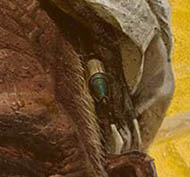
Luo Zhongli, 1980, detail © Luo Zhongli
When the works were successfully exhibited in the National Art Museum of China in Beijing in 1981, “Father”, the image of a farmer who endures the suffering and never complains, deeply moved hundreds of millions of people. The huge size and the hyperrealism of the picture were extremely fresh but tacit to those Chinese people who saw the work at the museum. Li Xianting, the editor of the official media "Fine Arts" magazine at that time, was also moved by the human compassion shown in the work. For this reason, in 1981 he used "Father" as the cover of the magazine. Only through the undisguised expression of reality can art find the truth it has lost.
Changes in social thinking after "Father"
In terms of artistic language itself, China originally had its own context of development and its own system of language. However, Chinese art since 1949 has been mainly influenced by the realistic art of the former Soviet Union, coupled with the Cultural Revolution’s censoring of the traditional Chinese context and the ban on Western contemporary art. Under the influence of this aesthetic inertia, representational realism has become the most acceptable visual narrative method for the public.
Luo Zhongli was inevitably influenced by the American photorealist Chuck Close at that time. However, instead of deliberately hiding traces of personality, emotion, and attitude to create a flat and indifferent picture as Chuck Close did, Zhongli added these feelings to his picture. "I feel that this form is most conducive to powerfully conveying all my feelings and thoughts. The arts of the East and the West have always absorbed and been influenced by each other. Forms, techniques, etc. are just the language that conveys my emotions and thoughts. If this particular language can say what I want to say, then I will learn from it.”[6] The artist seems to have used a more calm and objective approach, but made the most subjective elucidate of a farmer in the work "Father".
To the general public at that time in China, Chuck Close and modern art in Europe and America were unfamiliar and so far away. Even at the Sichuan Academy of Fine Arts, the school had bought a Japanese-published "Complete Works of the World" but it was locked in a cabinet. The students had to press their faces against the window, brush the condensation from their breath off the glass, and view the book as they would a cultural relic in a museum. Such a book would take 1-2 months to read and absorb –but only under such conditions it was possible to read about Western modern art.
For a period of time after this work, a group of artists who were contemporaries of Luo Zhongli returned to their innermost selves in pursuit of their own spirits and emotions. They became more willing to pay attention to people's daily life, and wanted to explore and express the beauty of human nature in ordinary life. The spiritual essence of their paintings was the continuation of the humanitarian sentiment.
It is precisely because of the success of “Father” that the artist was sent by the government to study at the Royal Academy of Fine Arts in Antwerp, Belgium at the end of 1983. He developed a comprehensive and deep understanding of European art and phenomena. Later, he held a personal exhibition at Harvard University in the United States, and thus gained a wide international reputation. Since then, his use of different techniques to express the language of painting has become more pioneering and expressive.
In addition to reflecting on and breaking through the constraints of the political dogma on art, Chinese artists are eager for artistic change. Art theorists have begun to introduce and translate a large number of works on the history of Western modern art, for example Herbert Read‘s: A Concise History of Modern Painting (1979), H. H. Arnason’s History of Western Modern Art (1986) and many more. In the 1980’s, influential art newspapers such as "Art" (reissued in 1976), "Art Translation Collection" (founded in1980), and "World Art" (founded in 1979) began to publish articles on a large number of Western modern art genres and artists. Faced with the influence of foreign culture as well as domestic social pressure to achieve modernization, the ruling party has adopted a more accepting attitude.
Precisely at that time, Western modern art and post-modern ideas came together and quickly merged in China. There is 1985 Art Trend[7] movement, the 89 Art Exhibition[8] etc. So far, Chinese modern art has entered the experimental stage on a large scale and has been continuously reconstructed.
However, what is significant is that the village in the Daba Mountains where the artist once lived has now lost its former prosperity. As villagers have started to go to work in cities across the country, the village has become very glum and mediocre, in sharp contrast to the prosperity of the cities. And those farmers who have moved to the city are also working hard to transform themselves into a part of the city. Farmers, who once held an important position in China's social structure, are now gradually being urbanized under the drive of the market economy, and are being marginalized in the city.
References
- Michael Sullivan, Art and artists of Twentieth-Century China, Shanghai, 2012
- Gao Minglu, Chinese Avant-Garde Art, Jiangsu Fine Arts Press, 1997
- LvPeng YiDan, The Art History of China Since 1979, Beijing, 2011
- WangYong, A History of Art Exchange between China and Abroad, Beijing, 2013
Footnotes
[1] During the Cultural Revolution, China's economy was extremely weak and faeces was the most important source of fertilizer in rural areas at that time.
[2] During the 1966-1976 Cultural Revolution, universities stopped accepting students, and the college entrance examination did not begin again until 1977. Luo Zhongli was admitted to the Sichuan Academy of Fine Arts in 1977.
[3] Deng Kaixuan was a farmer in the Daba Mountains. Luo Zhongli lived in the farmer’s home when he was in the Daba Mountains. Deng Kaixuan was also the model for the painting "Father". He has passed away now.
[4] Gao Minglu, Chinese Avant-Garde Art , ( Jiangsu Fine Arts Press,1997)P70
[5] “Fine Arts" Magazine, (Beijing,1981)Issue 9, P57
[6] "Fine Arts" Magazine, (Beijing,1981)Issue 2, Page 4
[7] The 85 Art Trend refers to an art movement towards modernism that emerged in mainland China in the mid-1980ies. The young artists at that time were dissatisfied with the line of leaning to the left of the art world at the time, and with the Soviet socialist realism art stereotypes as well as some values in traditional culture. They tried to find new blood from Western modern art, which triggered a nationwide art trend.
[8] 89 Art Exhibition, "Chinese Modern Art Exhibition" held at the National Art Museum of China in Beijing in February 1989. This is the first exhibition of concentrated Chinese avant-garde art including performance art and installation art. The artist Xiao Lu shot her installation "Dialogue" and the exhibition was forced to terminate. The shooting incident of "Dialogue" has therefore become a symbol of the 89 Art Exhibition and has an important position in the history of modern Chinese art.
published September 2020
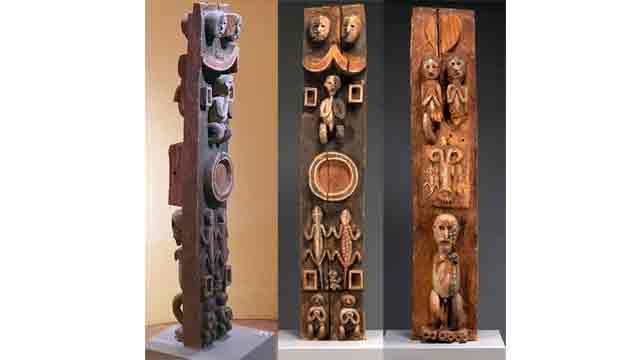
-
 ELVIS NKOME NGOME
ELVIS NKOME NGOMEThe selection of informants was randomly done as we were only interested in identifying the most relevant resource persons within the research areas like members of defunct and existing regulatory societies, traditional rulers, herbalists, and other village notables with measurable experience in material culture and their symbolisms which is the interest of the author in this paper. The paper consists of three parts: an introduction, the background issues or the historical antecedence, and the core, which deals with interpretation of the motifs on the objects, significance and ends with a summary.
African arts and cultures predates the colonial and missionary encounter in Africa. Some of the works provide useful information about indigenous craft industries such as pottery, carvings, iron metallurgy, weaving and much more. This article made use of works of earlier scholars who discussed aspects linked to the current paper. I also exploited some archival records, for example, file No. E.P.4929, entitled “Assessment Report [on] Bali, Bamenda Division- Cameroon Province (1925) by W.E.Hunt, District Officer, National Archives Buea, NAB. The works are framed into three broad thematic: objects made out of clay; objects made out of iron, and those produced out of wood and forest fiber materials.
Wooden Carvings and Clay Objects
Traditionally, the Bamenda grass fields and the Western Grassland regions of Cameroon are known for their mastery in the production and commercialization of various art works. In this region, craftsmanship is believed to be handed down from one generation to the next; from father to son. Grassland traditional architecture, objects, and symbols were unique from the point of view of their aesthetics, decorations and uses. In the 19th Century, a German Military Officer, Hans Glauning’s Official Report of 1906 on the Pre-colonial Nso (Banso) described grasslands houses in the following words:
The Banso houses, some 5-6 meters high to the roof, are [were] roomy and neatly built in Grassland style. The floors are paved with small pebbles. Each village has at least one meeting and drinking hall with carved door posts. Both frontages of the meeting house in Kumba were hung with about 900 skulls of Bamum and Nsungle warriors…[1]
The above extract clearly describes the pre-existing cultural and social institutions the European came across in the Bamenda grassland in early phase of the 19th century. The people were talented carvers, weavers and painters. The most remarkable designs were and are still royal stools, bangles, and door / window frames on houses that helped to show various layers or classes in society. On the door or window frames for example, were carefully carved motifs of animals and other selected creatures. The motifs were interpreted and symbolized cultural and political differenceswhich the society was aptly stratified.
According to Knopfli (1995a, 2000b) the carved posts were sometimes awards from the Fon, Kwifo as gifts to some notables, cult members, or other great men. These sculptures on wooden frames sometimes depicted great societal achievements of fons and great men and women in society. Also, in royal circles, such sculptures bore symbolic representations of warriors, heroes, and royal animals such as buffalo, lion, python, elephant and leopard appeared conspicuously carved on the chosen object. Other creatures like lizards, tortoise, and scorpions were widely engraved on Grass field arts. Besides, inanimate objects like iron gongs and cowries were represented on objects.
The zoomorphic and anthropomorphic Ethno-historical Dimensions of Cameroonian Carvings
To better appreciate the origins and meaning of some of the animal motifs on artistic objects, it would be important to understand the cultural and philosophical dynamics of some of the zoomorphic motifs on the objects and what they represent. There are different animals reproduced in aesthetic designs by the carvers like lion, scorpions, tigers, toads, various species of lizards and a host of other non-living things. However, for the purpose of this paper, we shall focus more on the lizards depicted on the wooden board (the ‘Blue Rider Post’). As far as lizards are concern, Hans Knopfli (1990), studied various kinds of lizards which were/are common in the Western Grasslands of Cameroon. The stylistic motif of lizard is one of the most common designs in wood sculpture in the region, but also in many forest areas of Cameroon such as in Kribi in the South Region, amongst the Ejagham group in Manyu and Meme Divisions in the South-West Region of Cameroon. Generally, lizard motifs, or appear on various works of arts such as royal stools, masks, doorframes, drums, clay pots, title cups, and on embroidered robes and caps.[2]
However, the actual meaning of the lizard symbol is not quite clear. Knopfli noted that lizards are treated with maximum respect in the grassland. The belief about lizards include the idea that twins, chiefs and ancestors can transform themselves into lizards and that lizards have the spiritual ability to drive away witches. These however, does not close the page on their relevance in the cultural settings of different communities. In Africa, different groups perceive lizards differently according to their customs and traditions which have of course redefined their outlook as a people. There are three main types of lizards common to the grassland groups: the rainbow lizard (known in Bafut as kwifongu).[3] Another type of lizard is called the majuku lizard in Bafut language. This lizard is used by witch doctors to send and direct lightning in cases of theft, adultery, land stealing etc. Apart from the majuku, there is also the kukub (Mungaka language) lizard. This is a smooth skinned lizard with a long tail and it is very swift running lizard.
In Mungaka language it is called kukub, in Bafut language it is called akongse and in the Babanki language it is called fekeke, while Bakossi called it ebote-ngule. Worthy to note is the fact that most of the grassland sculptures carried this and other kinds of lizard motifs on door and window frames as well as traditional stools. Such insignia symbolized authority and deity, and life (Knopfli, 1990:58) In recognition of the above notion, one is tempted to argue alongside Knopfli that lizards therefore symbolizes life. He further states that any design of two or three rows of lizards round a stool with interlocking fore and back legs expresses the fullness of life.
Interpretation of the Motifs on the ‘Blue Rider Post’: New Perspectives
The information that follows herein is a fair, reliable and verifiable opinions of our informants who after careful examination of the photographed images gave their interpretations of the motifs on the ‘Blue Rider Post’ in its entirety. It is important to point out that the motifs are zoomorphic (animal), anthropomorphic (human-made) and inanimate gestures in the form of dots and circular/square indications.
The object has two sides which are embellished with similar motifs. The motifs include: dark patches, white dots, red marks, two human-like heads at the top, lizards, squared shape, circular shape in the middle of the object, and at the bottom, two human figures or deities. It is important to look closely at the object in order to have a clear interpretation of its motifs. According to recently collected data, the various marks like red, white and black confer or indicate various meanings according to the customs of the resource persons and sampled communities in Anglophone Cameroon. In this connection, the white colours stands for purification, membership, fertility, peace, prosperity, life, and an ‘eye’ like in the liengu female society.
Similarly, informants in Buea hold that the red colour represents danger, defence, and blood of sacrificed animals, authority and bravery. While, the black colour on the other hand, also represent prestige, authority, danger, and power. All these colours are still used by members of some cult agencies and cultural dance associations in most parts of South-Western Cameroon and the Cameroon-Nigeria Cross River Region. The red colour was extracted from either clay or camwood, while the white dot came from certain milky plants in forest. Existing cultural associations in Meme, Manyu and Kupe Muanenguba make use of these colours. The use of these colours as painting or decorations by associations like the Monikem and Oroko dances depicts closer similarities of the embellished colours used by the originators of the so-called ‘Blaue Reiter Pfosten’.
The upper/top layer with heads represents ancestors who watched over or protected the chief or king on the throne. Lizards on the carved object too represents many aspects or dimensions of community life as messengers, bravery, fertility, protection, and courageousness. On the hand, the square ark and the circular parts depict various things. While the square ark symbolizes the village’s sacred house such as etana, njeb, mbwog, the circle on the contrary represents the village, environment or community. The environment or the village is governed by the king or chief, who derived his authority and spiritual wisdom from the environment which was guided by ancestors.
Lastly, at the bottom side of the object there is a human-like figure, which assumes the status of a village ‘god’ or deity. The two figures at the bottom of the other side are depicted to pay allegiance to their superior king or the hegemonic ruler and played the role of mediator between the spiritual (dead) and the living in society. This is what the two little human-like at the bottom represent. They also played the role of messengers, mediators, seers, defenders, source of fertility and councillors to the reigning kings.
In terms of name, the object was recognized by various informants in areas where the tradition of either its use or production was common like amongst the Bakundu, and Ejaghams of Anglophone – South-West Cameroon. As a spiritual object, some informants called it ndo’obe while others called it nsibiri. According to Ayuk Divine Ndifon and Ernest Effim Lahluh, the object was likely the cult object of the Epke society in Ejagham, and the carvings on its represent a cult writing called nsibiri which could only be read and interpreted by those initiated into the inner core of the secret agency. The nsibiri depiction is used by members of the Epke cult, who opined that the object was probably dismantled from its original structure in a violent context.
By situating the object within the forest regions of Cameroon especially amongst the Ngolo, Bakundu of Ndian and Meme Division, and also the fact that there is cultural legacies that identifies with certain features of the so-called Blaue Reiter Pfosten, convinces the researcher to claim this region and its constituent villages as the likely source communities of the object whose biodata lacks comprehensive information to reconstruct its origins and provenance in recent years in spite of its popularity in the global North than in the Global South where it came from.
Summary
The paper has attempted to deconstruct the so-called Blaue Reiter Pfosten by tracing its seemingly obscured origin, its possible source societies and the meanings attached to its assorted motifs and much more. Based on current data it seems probable that the object was a religious medium of one of the cult agencies or a ritual symbol of some cultural associations or cult that flourished in villages that straddle the Cameroon-Nigerian Cross-River Region, including Ejagham, and Ekoi ethnicities in Manyu and Ndian Divisions of Cameroon. Other possible source villages of origin include Ngolo, Ikiliwindi, Bombe-Bakundu and Ngolo-Bolo. One of the likely reasons for arguing in favour of this assertion is because the above named villages share the same traditional religious, political and cultural beliefs that made used of similar posts for their initiation, divination, protection and other important rituals. It is believed that such an imposing object with impressive characteristics and diverse colorations: red, white and black dots had other uses which only core members of the cult agencies could analyse. This is because the secrets of any cult are kept jealously by its members and non-members are not allowed to know its real meaning. This is another difficulty realized in deconstructing the object.
As earlier mentioned, the object depicts the life of a true traditional African society where there is an inseparable bond between the dead and the living on the one hand, the community leader and his courtiers and deities on the other. However, because of lack sufficient information about this object because failing memories our informants, it seems difficult to ascertain the exact period when the object was made. It is however, true in my humble view that the object was customarily used by the peoples of the originating villages prior to the arrival of European missionaries and German colonial authorities in Cameroon by 1884.
References
Chem-Langhee, Bongfen and Fanso, V.G., eds, “Nso and the Germans: The First Encounters in Contemporary Documents and in Oral Tradition”, 1996,
H, Knopfli. Sculpture and Symbolism. Limbe: Presbook Publication, 1998.
Ngitir,V.B. “Bamenda Grassfields royal collections and museums from ancient times to the beginning of the 21st century: The symbolisms and Conservation of Palace Art,” Yaoundé: thesis, Department of History, Yaoundé I, 2014.
Interviews
Name of Informants
Profession
Age
Date & Place
Language
Interviewer (s)
Ethnic Group
Prince Remigius L. Endeley*
Teaching/Museum manager
47 years old
27/07/2020, Buea.
English
Ngome Elvis N.
Bakweri (SW)
Dr.Venantius Ngwoh Kum
University Lecturer
55 years old
5/08/2020, Buea.
English
Ngome Elvis N.
Esu (Wum) – (SW)
Ekema M. Ahone
Teaching
65 years old
Tombel, 25/07/2020
English Language
Ngome Elvis N.
Bakossi (SW)
Michael Emeh
Retired state Agent
84 years old
17/07/2020, Ngob-Baseng, Tombel
English Language
Ngome Elvis N.
Bakossi (SW)
Prince Nzum’etoe
Researcher/Farming
45 years old
Bakweri-Town-Buea,17/07/2020
English Language
Ngome Elvis N.
Bakossi (SW)
Richard Tarkang
Retired State-Agent
64 years old
Kumba, 1/08/2020
English Lang.
J.B. Ebune
Banyang (Mamfe) –(SW)
Mosses Ebollo
Retired state-agent
84 years old
27/07/2020, at Kumba
English
Lang.
J.B. Ebune
Bakundu –Ibemi (SW)
Pa Esseme
Retired farmer
84 years old
Kumba, 13/07/2020
English Lang.
J.B.
Ebune
Kokobuma-Bafaw (SW)
Moka Williams M.
Farming
40 years old
06/07/2020, Wolikawo-Small Soppo, Buea
English Lang
Ngome Elvis N.
Bakweri (SW)
Prince Kombe David Monono*
Farming/security guard
46 years old
13 October, 2020, Great-Soppo-Buea
English Lang.
Ngome Elvis N.
Bakweri (SW)
Ikome Kingue
Traditional healer
70+ years old
Bonduma, Buea, October 28, 2020
English Lang.
Ngome Elvis N.
Bakweri (SW)
Mathias Nyoki
Retired soldier
55 years old
Great-Soppo, Buea, 2020
English Lang.
Ngome Elvis N.
Bakweri (SW)
Nteh Roland
Teaching
46 years old
28/09/2020, Limbe
English Lang.
Ngome Elvis N.
Bakossi (SW)
Joss Clinton
Security Guard
46 years old
Limbe, 13/09/2020
English Lang./Pidgin
Ngome Elvis N.
Menchum (NW)
Chief Ekumbe Thomson*
Traditional Ruler
74 years old
Bakweri-Town Buea, 16/10/2020
English Lang.
Ngome Elvis N.
Mbonge-Bakundu (SW)
Tita Oliver T.*
Teaching
54 years old
22/09/2020, Limbe
English Lang.
Ngome Elvis N.
Misaje-(Dongamantong) –NW.
Paul Mukete
Retired state-agent
80+
Great-Soppo-Buea, 23/10/2020
English Lang.
Ngome Elvis N.
Bakossi (SW)
Simon Buma*
Church Worker/PCC
61 years old
Great Soppo, 17/10/2020
English Lang.
Ngome Elvis N.
Bali-Nyonga
(NW)
Allen Maimbo B.
Building
58 years old
15/09/2020, Limbe
English Lang.
Ngome Elvis N.
Basum- (NW)
Footnotes
[1] “Nso and the Germans: The First Encounters in contemporary Documents and in Oral Tradition” in Chem-Langhee, Bongfen and V.G.Fanso (eds.), 1996, 123. Quoted in Ngitir (2013): 169. See the entrance to the second Courtyard of the Fon’s Palace, Bali-Nyonga in 1907.
[2] Knopfli (1990), 55.
[3] The word is a combination of the kwifon, the name of the much feared secret society and ngu fowl. Kwifongu then means ‘danger to fowls’.
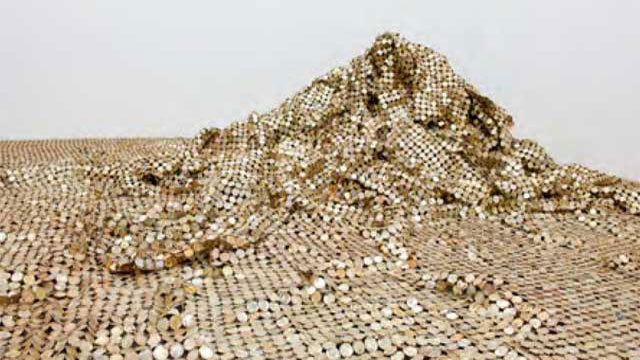
-
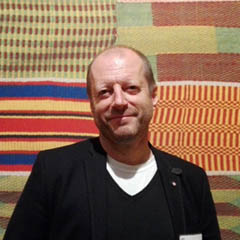 Stefan Eisenhofer
Stefan EisenhoferThe philosophy of borrowing materials and tools, as well as visual motifs, from the local environment goes back to his student days at Kwame Nkrumah University of Science and Technology in Kumasi in the late 1960s. It was the creative efforts of local artisans there that inspired him to become interested in the philosophy of "Natural Synthesis" from 1975 onwards at the University of Nigeria, Nsukka, where he is now Professor of Sculpture. This manifesto of the so-called "Zaria Rebels", whose members included Uche Okeke, at that time also a lecturer in Nsukka, postulated that local traditions should be interpreted using modern materials and techniques. This idea was to have a lasting influence on El Anatsui.
A striking example of its expression in his work is the metal "tapestries" he has made since the late 1990s, which are actually sculptures rather than wall hangings. They consist of thousands of aluminium bottle caps discarded by Nigerian distilleries. Sorted by colour and prepared by El Anatsui's many assistants, they are stitched together with copper wire into "tapestries" several square metres in size. The tiny pieces of aluminium are arranged in patterns that evoke the narrow-band kente textiles made by Asante and Ewe weavers. However, this classical form of West African cloth is subjected by El Anatsui to a radical transformation in these works, which undermine the idea of metal as a rigid material. He transforms into something pliable and almost sensuous. Closely linked to this is the concept of a "nomadic aesthetic" involving fluidity of ideas, impermanence of form and indeterminacy. For El Anatsui this especially includes encouraging and even forcing the curators of his exhibitions to hang his works in accordance with their own ideas. He himself sees his wall hangings as physically unfixed and insists that there is no final and mandatory way of hanging them.
In addition, El Anatsui creates connections with the aesthetic, political and economic roles of textiles – as an important component of global trade and consumer history, and as a significant vehicle for the transfer of ideas and creative ingenuity across cultures. Furthermore, he refers repeatedly to the function of kente cloths as a way of memorializing something, for they are often linked to events, people and historical or current issues: "You can memorialize a lot of things in cloth instead of having a statue in bronze," says El Anatsui and takes this up not only by naming some of his works after kente cloths, but also through the fact that the bottle tops he uses to create his "cloths" come from brands of liquor with names that refer to historical events.
El Anatsui's wall hangings directly continue his idea of creating "transformations" of regional West African phenomena, and experimenting with materials that are important in the local cultural context. His artistic career began with wooden food trays from local markets which he decorated with burned or carved versions of adinkra symbols. The next phase was characterized by a series of broken and partially mended clay pots which served as a reflection on the current political situation in many African countries, and at the same time as an optimistic reference to the fact that clay pots are repairable and new uses can always be found for them: "When a pot breaks it's not the end of its useful life," says El Anatsui. Even breakage can lead to something new.
In the 1980s he again turned to wood as a material, and discovered the chainsaw as a particularly suitable instrument for working African hardwoods. The chainsaw became for him a metaphor of the long history of violence to which the cultural traditions of Africa were, and still are, exposed. "Each process has its own peculiarities or language. [The chainsaw´s] language [is] of violence, of tearing, of clawing, of dividing," says El Anatsui.
In the abstract wood sculptures of this phase the seed is already sown for something that runs through his work to this day: aesthetic comments on globalization and consumer culture, on the wastage of goods – and human lives. It is this aspect that has led to the great popularity of some of his works, for instance "Visa Queue" (1992), and in particular "Akua´s Surviving Children" (1996), which was made in Denmark while he was grappling with the theme of the slave trade. The stylized human figures made of driftwood show the damaging effects of water, wind and weather, the chosen material in itself a symbol of unprotected exposure: "The wood having (like the slaves) been torn from its land source and exposed to the hostile elements of water and wind."
Linking aesthetic creations with political and economic issues is also a characteristic of those works in which he takes up the world's growing ecological challenges. This applies to his "Peak Project", created in 1999, which consists of numerous freestanding "peaks" made from thousands of glittering milk tin lids. Once again, the unfixed nature of the work is a prominent feature, the "peaks" taking on a different shape at each exhibition site. The open-endedness of his works can be seen in "Coal Pot", a work exhibited in the sculpture garden of the University of Kentucky Art Museum. It consists of a 15-feet iron cauldron filled with large pieces of Kentucky coal. In the course of time, the coal will disappear, gradually changing the appearance of the sculpture.
El Anatsui has always been concerned with West African traditions facing the Global North under conditions of modernity, and in his special way he strives to give them new life and meanings that are of relevance today.
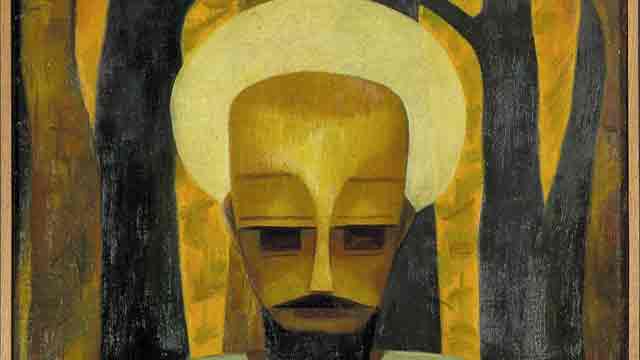
-
 Osuanyi Quaicoo Essel
Osuanyi Quaicoo EsselThe seated human-like figure is centrally placed with the head occupying almost the centre of the entire composition while the hands rest gently on the laps. The head and the face of the human figure is rendered in planes and cubistic orientation, a style reminiscent in precolonial African wooden sculptures. Hands of the figure received similar cubistic treatment with less details as in realistic depiction. Interestingly, there is a deliberate subtle emphasis on the head size of the figure. In African sculptural renditions, the human head is considered as seat of wisdom and, therefore, presented bigger to defile the realistic canonic proportions and connote its Afrocentric symbolic essence. This concept of head re(presentation) is termed as African proportions (Amenuke et al, 1991).
To create a harmonious contrast of colour and shape, tints of yellow forms an arc-shaped design around the head. This treatment possibly suggests a halo effect characteristic of saintly figural paintings in Western art traditions. It also mimics a turbaned human figure. As an artist who hailed from a predominately Muslim community, this stylistic treatment, perhaps, pays tribute to his religious cultural background. The eyes are presented with dark brown rectangular dabs, with the forehead gently highlighted with bright yellows, a treatment that puts the human figure in a meditative mood and sanctimonious character. Though Uche Okeke presented the work in a portrait orientation, the skilful placement of the human figure, and the peculiar colouration of the head regions creates a triangular effect when imaginary diagonal lines are projected from the bottom corners of the composition to the halo-shaped found on the head. Similarly, the haloed effect on the head and the elongated pharaonic beard creates an imaginary inverted triangle resonating a visual excitement.
Symbolically, yellow depicts riches and royalty in African colour scheme. With this schematic colouration, Okeke gave a clue to the kingly characteristics of the human figure. The white looking garment of the figure also adds to the sanctimonious conjecture of the figure as in African colour symbolism. The artist’s use of luminous chromatic reflection of the tint of yellow and dark shades helped in achieving the sense of depth in the garment. Complementing the overall kingly posture of the human figure is its elongated pharaonic beard and bodily language as found in sculptures of ancient Egyptian kings.
Okeke skilfully deceived viewers of this composition into believing that it is symmetrical per its stylistic tendency, yet an intense observation reveals a psychedelic mutation of the placement of the fingers, padding of the background with tree-shaped figures in rich application of tints and shades of black, yellow and brown to create contrast of colours and shapes. Placement of the trees in colour variations and the sprouting of the branches forms a psychedelic cross and contribute to breaking monotony. The patchy effects of the intense yellow forming the negative spaces adds to creating a perceptual believability that the human figure wears a contemplative mood per the facial looks. There seem to be gentle highlights of the yellow from the shoulders to the halo-shaped object.
Per the compositional portrayal, Okeke showed a kingly and majestic posture of, perhaps, the Christian religious icon in Africanised bodily posture and cultural praxis. This compositional contextualisation feeds into his personal manifesto that he did not subscribe to borrowing Western artistic accent hook, line and sinker. Neither was he comfortable with resorting his Nigerian indigenous artistic traditions without modification. He emphasised in his manifesto that it is ‘… futile copying our old art heritages, for they stand for our old order. Culture lives by change. Today's social problems are different from yesterday's, and we shall be doing grave disservice to Africa and mankind by living in our fathers' achievements’ (Okeke, n.d). For that reason, he appropriated western artistic accents and fused them with Afrocentric artistic concepts and perspectives to achieve a hybrid artistic language which is not purely African nor Western, but yet circumvent the boundaries of artistic cultural traditions in general. The fusion lends itself to exploring the familiar and the unfamiliar to create a renewed breed of art. He called this effect ‘natural synthesis’. Emanating from Nigerian non-conformist artist group named Zaria Rebels, Okeke sought to reinterpret the Western artistic style of realistic depiction, perspectival detailing, accurate proportions and tonal gradation he was exposed to by the Eurocentric-inspired faculty in the so-called formal education setup in art in Ahmadu Bello University, Zaria. As part of the pioneering post-independence artists in Nigeria, Uche Okeke was experimenting for a renewed artistic accent for his creations through the assessment of his Nigerian cultural values and the new artistic training he had been exposed to in order to arrive at the boundary of these two traditions.
Using this painting in teaching and learning in the context of collective memory could inspire relevant competencies in the learners. Gathering inspiration from the artistic pursuit of Okeke, learners could fuse multiple artistic traditions of the artworld to arrive at their individualised artistic accents. Teachers could engage learners in this manner by asking them to borrow and appropriate a foreign artistic style and fuse it with their nationalistic art making techniques to develop a new breed of art or concept. Teachers could also discuss with learners about the fact that gathering artistic inspiration is multicultural with no boundaries. Furnishing learners with links to the biographical account of the artist for them to understand his cultural nuances remains key in the process. It would also be beneficial to guide learners to explore with their own interpretation of the artwork (figure 1). Teachers could also provide learners with printed copy of the painting and ask them to redraw this religious-centred figure to suit their own religious understanding and cultures. This approach addresses the competencies of critical thinking and problem solving; creativity and innovation; cultural identity and global citizenship; and personal development.
References- Amenuke, S. K., Dogbe, B. K., Asare, S. K., Ayiku, F. D. & Bafoe, A. General knowledge in Art for
- senior secondary schools. Evans Brothers Limited.
- Okeke, U. (n.d.). Natural synthesis. final okeke natural synthesis manifesto 1960.doc (live.com)
 Mahmoud Malik Saako
Mahmoud Malik SaakoThe image is presented in a form of a male figure in a seated position with long beard, white turban, white robe, long sleeves and a probably waist band. The painting represents fairly the complexion of a male, black bearded and wearing a face mask, with hands resting on the laps possibly in a meditation mood. The Background is probably a wooded environment or garden with tall trees of two colours (black and yellow). The figure seated probably on a staircase or an amphitheater. The sun ray penetrating through the tree created shaded patches reflected on the image.
An Islamic perspective: I base my interpretation of the painting on Islamic perspective as one of the foreign region that had an early contact in northern Nigeria as early as 15th century long before Christianity and eventual colonization of Nigeria by European power (the British) and its possible independence in the 1960. The emir is mostly male usually dressed with a white robe, long sleeves and a white turban tied around his head to signify his authority. The painting perhaps represents an Emir of the Zaria state at that time sitting in a garden relaxing.
Using an African mask: The use of an African mask to represent the figure was done deliberately or perhaps to avoid revolution from the Muslim community of disrespecting their leader which the author was much familiar in this volatile society especially, the intolerance nature between Muslims and Christians at this era in the Zaria state. The mask as a tradition signature that ubiquitous across many cultures that can be used to represent the religious discourses by appropriating and manipulating them to produce art forms of the past to produce a mythology for the present.
Lessons
- The image portrays the power of the emir in the Zaria state with a possibly palace and vineyard or gardens where he retires to relax. The seat or staircase/amphitheatre is constructed within the park for relaxation.
- It also shows the importance of trees because the natural air and shade provided. It reflects the symbiotic relationship between man and the natural environment or biosphere.
- The long beard is a reflection of the age of the figure, combined with the white turban tied around the head which is a symbol of power and authority of the emir within the context of an Islamic state. Again, the white long robe coupled with black beard and the white turban is a reflection of the dress code of the emir within the states dominated by Muslims. The waist band (blue sea colour) is used to tie the robe for easy movement.
- The facial representation of the figure doesn’t conform with normal human head based on the eyes, nose and mouth. It is probably a mask of an Egyptian pharaoh to imbibe the spirit of the Pharaoh as a kingly figure that wielded much power. A story that is synonymous in both Islam and Christian doctrines except the West Africa Indigenous Religions that do ascribe this myth. The use of the mask also simmer the tension of using identifiable imagery that would have rise tension in this probably consecutive Muslim state. The use of masks within the Africa context show the spiritual powers embedded in them that the wearer or user is mostly possessed and transfigured a situation that can only be explained by adherences to that particular belief system.
- The black and yellow tall trees depict the diverse nature of the ecosystem and the symbiotic relationship mostly exhibited in the environment. This shows the complex nature of the human society with diverse cultural and different colours complexion that need a person with wisdom and patience to rule, like the emir who assumes the position of an Egyptian Pharaoh.
- Uche Okeke, was a revolutionary artist who tried to break away from normal art presentation handed to Africa by the white colonial powers. This diversion was to Africanize the art industry in West Africa and Africa at large. This where Okeke decided to use the Pharaoh mask from Egypt that was considered even among Europeans of the cradle of human civilization in the world.
 Ernst Wagner
Ernst WagnerI argue in the following text from a special position. Firstly, I was present in Bayreuth on 26.4.2022 when the two co-authors, Osuanyi Quaicoo Essel and Mahmoud Malik Saako, discussed the painting in a larger circle. The representatives of the Iwalewa House clearly expressed their doubts about the (traditional) title of the painting "Christ".[1] Perhaps this brought the question of who was depicted in the painting, Christ or another person, to the fore. This question also shapes my discussion of the painting presented here. It became the guiding theme behind which other topics disappeared, such as the question of the painting's function (what was it created for?), its biography (how did it come to Bayreuth?) the role of oil painting (is it a European import), the context of the debates on modern art during the independence movements in Africa (does the painting belong to a global modernism after the Second World War or does it mark a Nigerian path? [2]) - to name just a few.
My own interpretation is therefore less an independent approach to the work than a response to the positions presented with the intention of building bridges between the approaches by introducing a meta-level. Whether this is convincing, whether the bridge is sustainable, is for the reader to decide. But more on that below.
Traps through aesthetic stereotypes that lead to false classifications / interpretations
And a second preliminary remark: I didn't like this picture at the beginning. It reminded me too much of the religious pictures of the 1950/60s of my childhood. They were popular for death pictures back then: A mixture of a bit of Pre-Raphaelite and icon-inspired imagery, soaked in the formal world of a moderate and esoterically inclined modernism (Franz Marc). The intention was easy to see through: To somehow keep alive that which, in my view, was no longer contemporary at all, and to do so through a bland, unconvincing and even less convincing adaptation (a kind of "modern facing"). This is also why, when I saw the picture hanging at the entrance to the Iwalewa House from the corner of my eye, I immediately saw a Christ.
Iconography - inclusion of other perspectives

Detail
In the discussion mentioned at the beginning, the intervention of Mahmoud Malik Saako was really surprising for me - against the background of this perception, which was shaped by my own stereotypes. The halo (which I saw - see detail) was a turban (which Malik saw). But I could not counter his view. There was no argument for the interpretation as a halo. This is also true now when I read Malik's text (like Osuanyi's). So I first had to recognise my stereotype in perception, which had lured me onto a perhaps (?) wrong track, I had to get rid of this, unlearn something, in order to be able to open up to the other perspective.
Why I - retrospectively - still speak of "perhaps wrong", a research on Okeke's work has confirmed as meaningful. After all, there are obviously works in his oeuvre that iconographically quite certainly represent Christ or St Mary, as an internet search reveals (see fig. below). The auction house Bonhams (Abb.1) states - even if for 1963, two years after our work: "in 1963 ... the Passion of Christ was a recurring theme for the artist. He had produced the stained-glass designs of the Fourteen Stations of the Cross in Munich earlier in the year." (www.bonhams.com/auctions/25800/lot/28 accessed 14 Sept 2024)
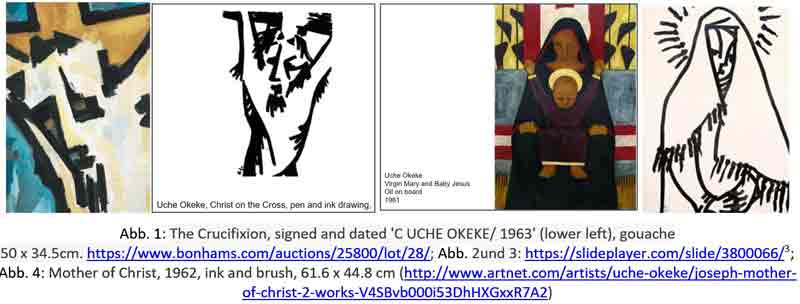
Christian motifs in Uche Okeke's Ouevre between 1962 and 1963 found by the author on the internet (May 22, 2022)
Perhaps this is why the discussion about whether Christ or a Muslim is depicted makes me feel uneasy. In my mind, the question is connected with the attributions or depreciations: To whom / which faith does the work of art belong? Does it belong to the Christians, the Muslims, or the traditional believers in northern Nigeria, if, as Philipp Schramm or Mahmoud Malik Saako suggest, one also discovers a traditional wooden mask?
New approach and reflection on its anchoring
Hence my attempt to think of the painting in a different way, i.e. not from the artist's point of view and what he or she wanted to represent. In doing so, it is clear to me that I am taking a specifically Western approach to a modernist work (where I now place Okeke's painting) with my new approach. This approach is based on the loss of a binding iconography and a fundamental openness / never-quite-unambiguity of 'autonomous' works of art for a Western-oriented, middle-class audience. In addition, my proposal for interpretation is based on a specific position in the interpretation of images, from production theory to reception theory (in the context of constructivist epistemology). The loss of a binding iconography is accompanied by a greater significance of form (which is now itself charged with content to compensate for the loss). In a next step, I therefore try to examine the image - beyond a positioning in the question of whether it is an "Islamic" or a "Christian image" or a "traditional image" - form-analytically.
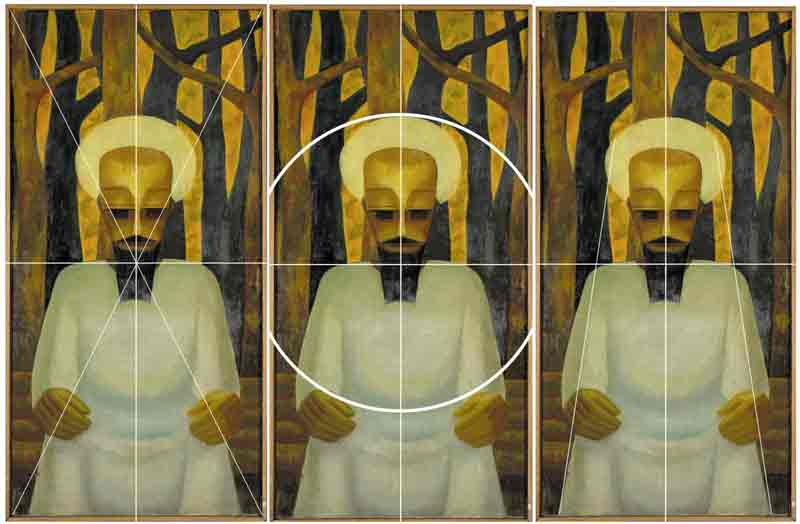
Analytical composition with auxiliary lines. (c) the author
Form analysis
The dominant, almost penetrating axial symmetry in a very high longitudinal format speaks of high order; the pyramidal structure of the figure also speaks of calm and stability, indeed of sublimity and dignity, of quiet, immovable power. And this dignity is not fed by external insignia or theatrical staging, but by a calm that radiates from within. It is a picture in front of which one can become calm if one trusts the order as a viewer.
The striking human figure contributes to this effect. Although clearly figurative, it does not represent - to the degree of abstraction - a concrete portrait or a human being that can be grasped by the senses. This is most obvious in the geometricised eye area, which is shaded in various dark zones. This makes the gaze ambiguous: is the figure looking at the viewer, is it looking forward, is it looking inwards (contemplatively, with closed eyes)? Together with the geometric rhythm of the picture's surface (the symmetry, but of course above all the parallels that can denote eyelid, tear sac, eyebrow - or not) support the depiction of a human being in an abstracted ideal form that remains open to itself, as in a mask. The latter is also characterised by the fact that the viewer immediately sees what has been made, what has been assembled, as in the case of the moustache, for example.
The figure sits quite classically in front of a middle and a background: at the bottom the zone (again - between two-dimensional and spatial effect - strongly abstracted) is divided into horizontal stripes, which become slightly narrower towards the top. They again suggest something familiar (a wooden bench), but this remains ambiguous. In the upper zones, the tree trunks (without leaves) form the liveliest, least symmetrical, most restless element in the painting, even if the alternation of light and dark again shows the abstracting hand of the artist.
With this spatial layering in clear zones (background, trees, seat, figure), but also the geometric reduction of the forms, the picture looks like a carved relief. The colouring also fits in with this, for example when the "sky" behind the trees as well as the lighter trees have the same colouring as the face, while the beard, eyes and the dark trees form a second colour zone. The lightest zones are formed by the robe and the shape around the head. Despite the large spectrum in the area of light-dark contrast, the picture does not appear colourful, rather like a natural wood relief. An effect that is again particularly evident in one detail: the way the hands are shaped is reminiscent of hands carved out of a piece of wood.
This character is supported by the way Okeke uses oil painting. He clearly outlines the contours of the surfaces. The objects are each assigned a main colour, applied impasto with broad brushstrokes. The modelling creates plasticity, lightly set with internal structures enliven the colour surfaces.
Conclusion
The degree of abstraction, the modelling construction of the figurative out of a colourfulness, the strict symmetry of the composition, the tectonics of the pictorial space unfold a tableau that nevertheless - and this is now decisive - creates zones of ambiguity in the figurative. The viewer must fill these with his or her own ideas. The viewer's gaze is directed towards the picture, but the eyes do not look back. In this respect, the painting is suitable for contemplation, meditation, spiritual experience. In seeing the painting, one's own can come to rest. And so the distinction between the Christian halo, the Muslim turban and the ritual mask can also come to rest in the contemplation of the painting.
This consideration is based on an 'ideal viewer' of the work, i.e. it is reception-aesthetically oriented. If one finally turns it once again to production aesthetics, one could interpret the work as an attempt by the artist in which it experimentally unfolds what a spirituality beyond the distinction traditional - Christian - Muslim could look like.
Footnotes
[1] Philipp Schramm's position becomes clear in his text (https://www.bayfink.uni-bayreuth.de/de/Sommerausstellung-2021_-Not-yet/audio-not-yet---welcome/index.html).
[2] Perrin Lathrop, "Uche Okeke," in Smarthistory, August 9, 2015, accessed May 21, 2022, https://smarthistory.org/uche-okeke/.
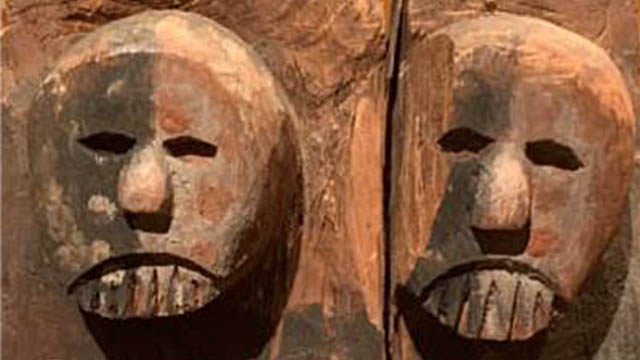
-
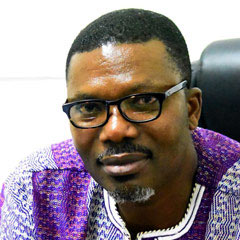 Patrique deGraft-Yankson
Patrique deGraft-YanksonExploring an Enigmatic Piece of Traditional Cameroonian Sculptur
The Veranda Post found in Museum Fünf Kontinente is an exemplification of the extent to which indigenous Africans mutually reinforced socio-religio-cultural existence and expressiveness of form through sculpture. Various examples of these artefacts abound in the collections of African plastic artforms found in many museums across the globe. The beauty in experiencing, analysing and speaking about this artwork (as well as many of its kind), lies within the absence of authenticated historical and analytical literature on them. This makes it possible for the observer to exert complete authority of personal perception and interpretation devoid of any fixed attitude that dictates, interfere or curtails aesthetic enjoyments, interpretations and judgements, as attempted in this presentation.
With the dimensions of 199 x 60 x 50 cm, the Veranda Post found in Museum Fünf Kontinente is one of the numerous examples of the African artistic expressiveness, confirming the artistic prowess of the traditional African. Examples of these artefacts abound in the collections of African plastic artforms which record indigenous religious beliefs, practices and performances that date back from the beginning of African history.
As typical of most indigenous African sculptures, this work is not only uncaptioned, but the artist/creator is not known. What is known, however is that, its peculiar characteristics and style makes it easily identifiable and representative within the milieu of popular African sculptures. According to the Museum Fünf Kontinente records, this work was collected from 'Kamerun'. 'Kamerun' was an African colony of the German Empire between 1884 and 1916, which was located in the region of today's Republic of Cameroon (Wikipedia, 2020). Comparing the characteristic features of this sculpture with similar sculptures described by some art historians as Veranda Posts created as part of ancient African monumental architectures found in the Cameroons Grassland (Willett 1981) therefore, it is not difficult place it within that category. Hence its caption.
As can been seen from similar ‘posts’ and judging from the elaborateness of the images created on them, the major reason for the production of these posts was more to afford the sculptor or sculptors the opportunity to decorate the buildings with stories, rather than serving as supports (see figure 1).
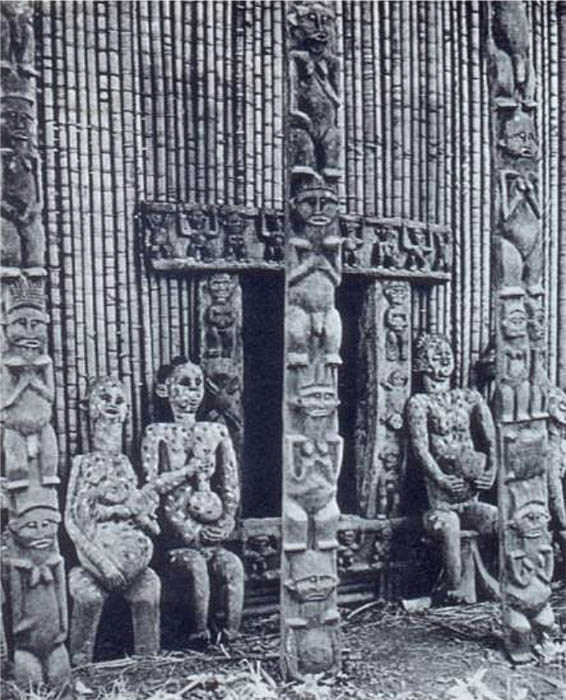
Figure 1: Ancestor statues, carved door-frame and verandah posts (Source: Willett 1981)
As said above, the beauty in analysing and speaking about this artwork (and many of its kind), lies within the absence of historical and analytical literature. The fact that this makes it possible for me (and for that matter any other observer) to exercise personal powers of perception and interpretation without any fixed attitude to direct or curtail their aesthetic interpretations and judgements made it my object of choice for this project at the Museum Fünf Kontinente.
Going by Margaret Trowell’s generalisations about African art, this Veranda Post can be classified under the ‘spirit-regarding’ art. Like many others of its kind, this work, which has front and back views, is flanked with human and other figures, ostensibly those of ancestors and is symmetrically disposed about a vertical axis, rendering it frontal at both sides.
Analyses of the images created on this pole reveal striking similarities between the age old traditional religious practices of the African and the Western religious beliefs and practices brought in by the earlier missionaries.
At the direct look of the object from the front (as it has been positioned at the museum, but actually one of its two sides), a prominent kneeling figure with hands clasped together unto the chest (much like the praying hand) can be seen in a pose that looks very much like the kneeling praying postures at Christian worships. To the African, this posture is not only assumed at prayer sessions as a visual image of submission to God’s authority, but is also exhibited as a sign of respect, humility and total surrender to a superior authority. For the sculptor to present the kneeling man as a central figure and subsequently rendering all other human figures in similar submissive postures therefore makes the theme of prayer, submissiveness and spirituality very strong in the composition.
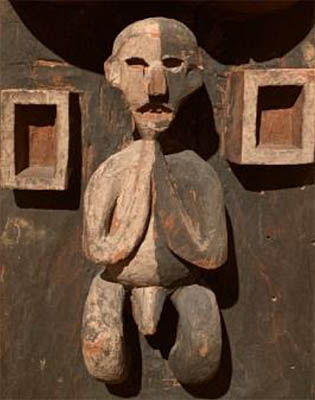
Figure 2: The kneeling or praying figure
The kneeling man is placed right below two human faces whose prominence and positioning easily pass them for elders, superiors, or better still, ancestors. Before the ancestors, all supplications are made, and through them, request are carried through to the supreme God.
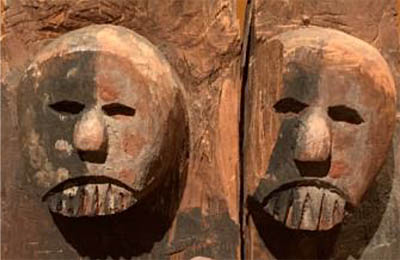
Figure 3: Ancestor figures
The importance of the two faces and emphasis on their superiority is further strengthened by a strong demarcation between them and the kneeling man through a thick rigid contoured line that forms a partition between the elements. This could be interpreted as a spiritual borderline that separate the spiritual world from the physical world. Generally, the African believes in the existence of the physical and the spiritual worlds as separate entities and this demarcation clearly depicts this belief. Also worthy of notice is the orientation of the demarcating border which rhymes with the praying hands of the kneeling figure, thereby visually connecting the figures. This carefully chosen placement of the two faces in the composition alludes to the supremacy of the ancestors and their exclusive existence in the after world as well as their connection with humans.
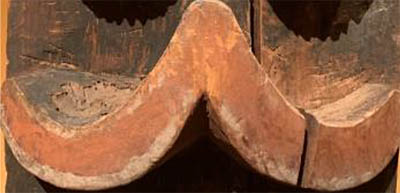
Figure 4: The spiritual borderline
Another striking imagery is created with the placement of a very visible image rendered in concentric circles. Among many African ethnic groups, the circle represents completeness, holiness, perfection and other such attributes ascribed to the supreme being (God). Among the Akan people of Ghana, for instance, the Adinkra symbol called Adinkrahene (king of Adinkra symbols) is presented as concentric circles. This symbol represents authority, leadership and charisma. The sculptor most likely created a bull’s eye of this symbol as an indication of exactly where this particular post belongs. The post could possibly be one of the furnishes for a palace or the abode of a traditional priest. This could also suggest the likelihood of the prominent kneeling figure being the King or the chief priest. Considering the atmosphere created by these symbols, the circle, with the kind of prominence it exudes could also represent the omnipresence of the supreme being, thereby heralding the people’s belief in the iniquitousness of God and His closeness to mankind.
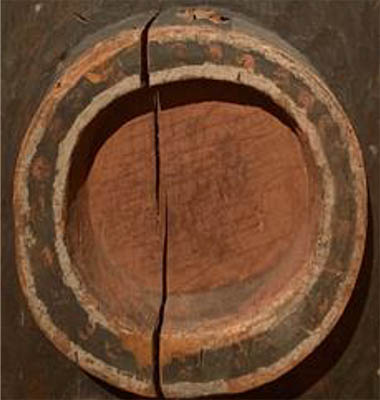
Figure 5: The concentric circles
Other recognizable images of animate and inanimate objects in the work include crocodiles, lizards and geometric shapes. Whilst it is likely that the geometric figures may have been deliberately presented to create balance, simulate a built living environment and arouse aesthetic sensibilities, the images of animals like those of the crocodiles have significant meanings as far as African culture and belief systems are concerned. Among some ethnic groups in Africa, crocodiles are believed to be the souls of ancestors who come back to live with men. Examples are the crocodiles in the Crocodile Pond at Paga in the northern part of Ghana who virtually live peacefully among the people. There are numerous African stories about crocodiles coming to the aid of men to either protect them or lead them to safety. Their inclusion in this particular work therefore is to establish the existence of spirits among men, especially as humans pray to seek their guidance and protection.
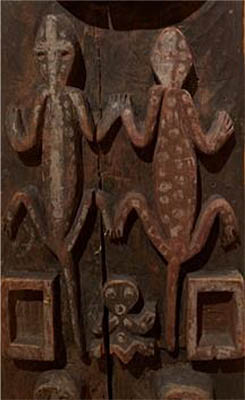
Figure 6: The crocodiles
Considering where it was created and where it is located now, as well as the current effort towards extracting a meaning out of its symbolism, this veranda post and many other such African artefacts in several museums around the globe have demonstrated how images and symbols resonate relationship between cultural practices around the world. The confluence of symbolic interpretations of the icons in the traditional African religions and the Euro-Christian religion, as depicted in this veranda post, gives justification to Africa’s unquestionable acceptance of Euro-Christianity and all the associated visual cultural practices.
For comparison, also read Karin Guggeis' analysis of this object here.
References
- Roy, C. (2019). Signs and Symbols in African Art: Graphic Patterns in Burkina Faso. Signs and Symbols in African Art: Graphic Patterns in Burkina Faso. https://africa.uima.uiowa.edu/topic-essays/show/38?start=13
- Wikipedia. (2020). Kamerun. Kamerun. https://en.wikipedia.org/wiki/Cameroon
- Willett, F. (1981). African Art. London: Thames and Hudson.
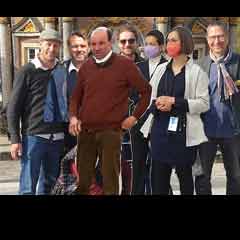 ISB_Team
ISB_TeamThis 'Veranda Post' is variously referred to (mostly in relation to its architectural-functional context) lintel or "te ken dy dye" (in the local Bandjoun language - PHSAA), porch post, house front pillar, post, cult house post (M5K, p. 17), Cameroon post / family crest (Macke at M5K, 13, 24). Post, however, in the sense of sign (post-it) is suggested by PdGY to address the communicative function. Other designations do not address the function, but limit themselves to the given, perhaps to avoid any pre-interpretation: 'sculpted wooden block' (Kecskési 1999 n. 108) or 'large carved square wooden block' (Kecskési 1976, p. 22).
Object biography: The object was taken before 1893 by Max von Stetten during expeditions on the Bamileke Plateau (south-western Cameroon), where it was presumably part of a meeting house of a confederation. Stetten (1860-1925) was German commander of the Kaiserliche Schutztruppe for Cameroon until 1896. Cameroon was a German colony at that time. The exact circumstances of how the object came into Stetten's possession are unknown, as is its original location and context.[2] In 1893, the Royal Ethnographic Collection acquired the pillar as a gift from Stetten.[3] In 1912, a photograph of the pillar was published in the Almanac of the Blaue Reiter. It is currently on display in the permanent exhibition in the Museum Fünf Kontinente Munich in a niche - a mirror allows a view of the second side (see Fig. 2). Along with other objects from the collection, it is currently the subject of a transnational project on their provenance (GI).
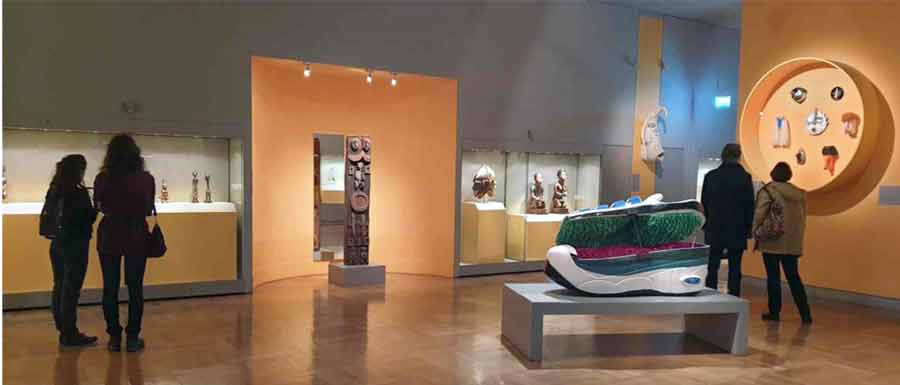
Fig. 2
Status: In comparison with carved mullions on façades of royal residences in the Cameroon grasslands (Fig. 3),[4] other mullions or door frames in the Museum Five Continents (M5K, p. 17, Kecskési 1999 No. 11, 70, 75) or in the Humboldt Forum Berlin, there is a partial similarity of motifs, but a strikingly 'archaic' formal language. Other examples are clearly more 'elaborate'. The multitude suggests that this type of pillar is quite typical of works from this period in this region of West Africa.
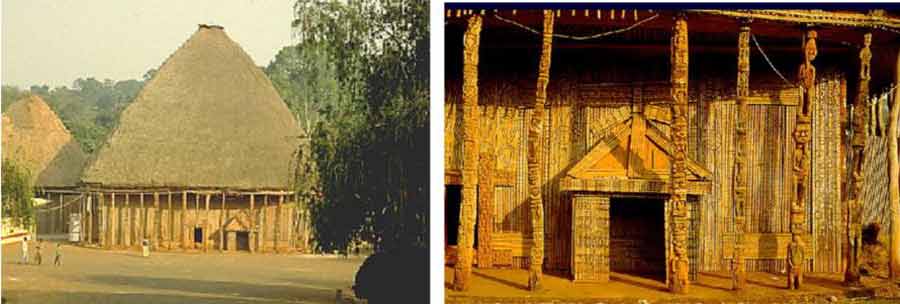
Fig. 3
Interpretation
The current view of the work
For the interpretation, the following questions lend themselves to art lessons: Form, iconography (meaning of the motifs), function, theme (or core idea) of the object, i.e. an interpretation.
With regard to the guiding idea of multi-perspectivity, two positions will be addressed: On the one hand, the view of today on the basis of ascertainable contexts, which seeks to understand the object from its time of origin and its context of origin. On the other hand, the view of the object by the artists of the Blaue Reiter. The comparison of these perspectives seems particularly relevant from an art didactic point of view, even though other perspectives would be conceivable, e.g. from the point of view of museology, provenance research, from the context of current restitution debates, etc. However, these are addressed in the teaching suggestions.
Shape
At first, the pillar develops an immediate physical presence for the visitor: through its sheer size (larger than life, almost square in plan), the materiality of the massive, cracked block of wood (the outline is irregular and probably corresponds to the tree) and the clear, concise, reduced language of form, whose meaning seems inaccessible. The surface treatment is archaic, the wood is more hewn than carved.[5] Thus it appears powerful and at the same time mysterious, which is supported by its presentation in the exhibition on a plinth and without glazing (see Fig. 4).
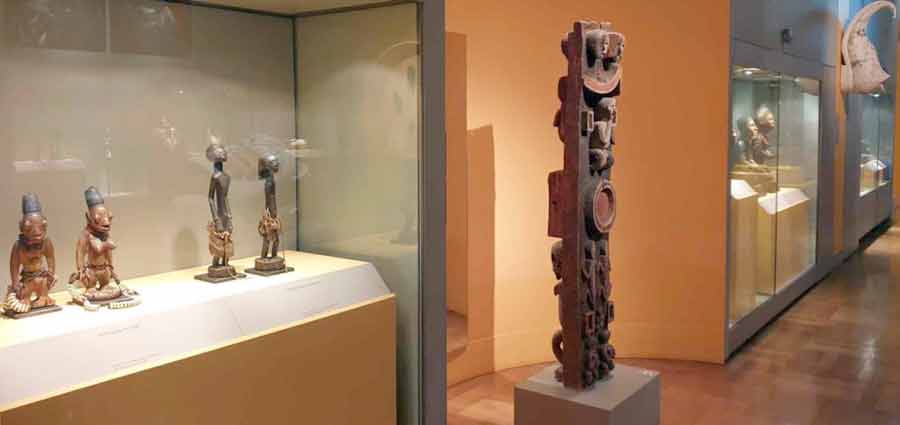
Fig. 4
A closer look reveals how the sculptor interweaves various modes of representation between complete abstraction (circle, rectangle) and representationalism (human figures, animals) in a compositional way[6] , monumentalising the individual motifs through internal symmetry, geometrisation, frontality and statics. This is supported by the painting (see Fig. 5). In this reduction, everything narrative is missing. The representation becomes emblematic, it becomes a symbol.
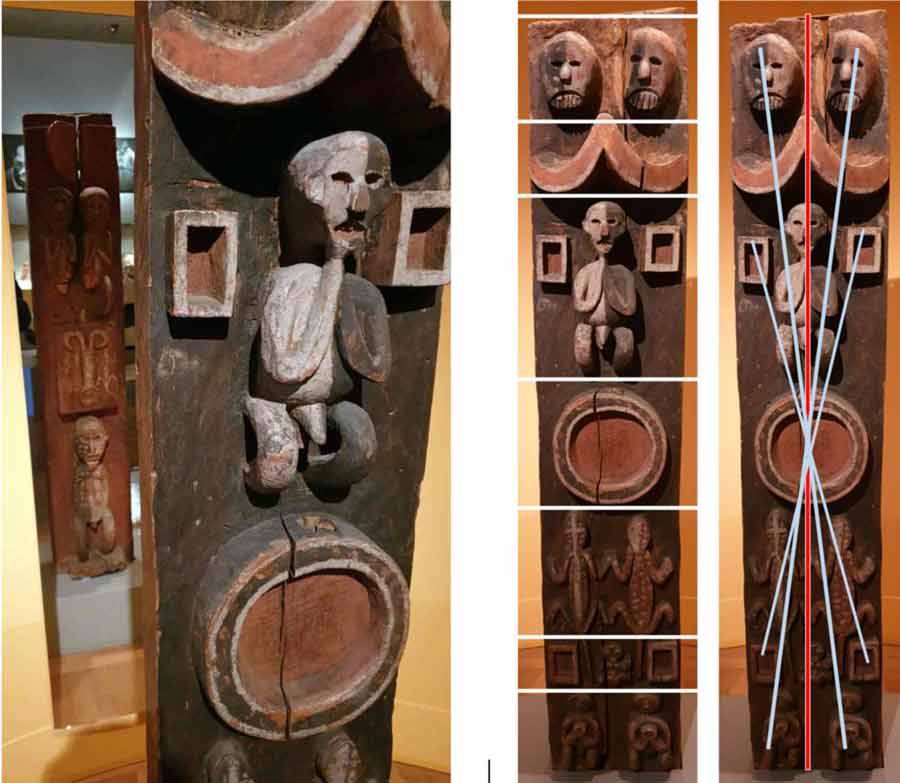
Fig. 5, 6 and 7
This is also supported by the overall composition, which obviously follows a calculated geometric order. It is strictly horizontally divided into individual zones, only once do lizard tails protrude into another zone. However, the separation into individual layers is ingeniously overcome compositionally by the strict axial symmetry in the vertical, but also by the point-symmetrical arrangement around the respective centres. The result is a tension between the contradictory compositional principles (see Figs. 6 and 7) that is decisive for the effect of the pillar.
The lack of any narrative on the one hand and the high creative effort on the other underline once again that it is about a symbolic level. This can perhaps be deciphered, even if its immediate complex order makes it seem above all direct, sensual.
The secure decoding of the iconography (what the individual motifs as well as the arrangement meant in the context of origin) is not possible with today's state of knowledge. Oral culture has left no written sources that could be consulted. Moreover, the oral tradition has been torn down - not least due to colonial destruction. However, since the work obviously has a symbolic language with clear iconography, this level cannot be left out in art lessons. German-language literature and oral experts from West Africa were consulted here. The results contradict each other, but nevertheless yield a court of meaning (see Fig. 8, in which the individual attributions of meaning are named)[7] , which provides a certain direction.
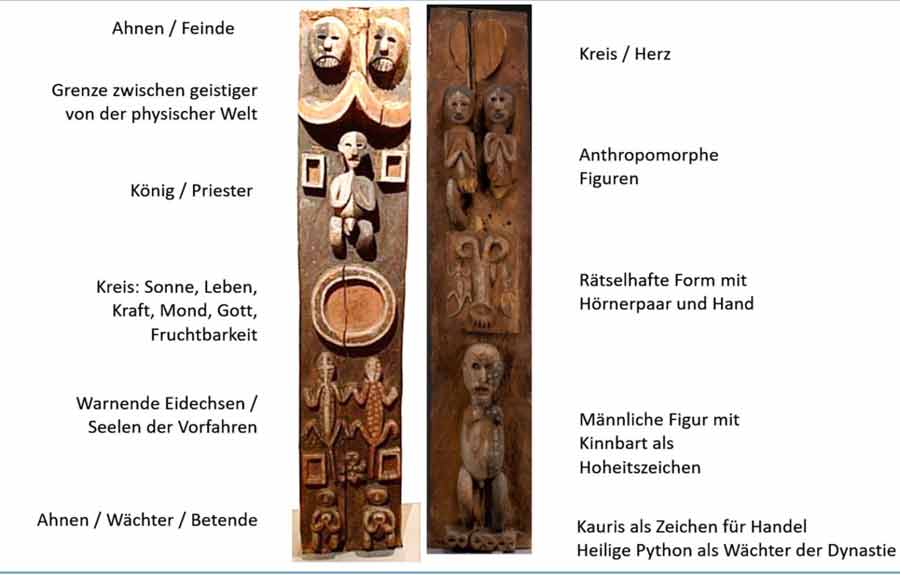
Fig. 8
In addition, the block is painted in three colours. These also carry meanings: Black could symbolise suffering, white could be the colour of the dead and symbolise mystery, red, the colour of blood, symbolises life (PHSAA). The light-dark contrasts themselves symbolise life and death (Kecskési 1999).
Function
PdGY suspects that the pillar - as part of the architecture of the house - stood at the spatial interface with the public (on a path) in order to communicate the significance of the house, presumably a cult house, to the outside. The object could therefore have been part of the façade of a particularly distinguished house[8] , also with a supporting function for the roof. It communicates what happens in the house or who lives or resides there.
Kecskési, on the other hand, considers a free positioning in space (Kecskési 1976, p. 22) and suspects an ancestral tablet. This in turn would fit the following determination by Gouaffo: "The 'Blue Rider Post' is a spiritual object. According to oral traditions, the object was placed in the sacred house like a statue. Caps, chains, bags or skeletons could hang from the object. Secret societies like the 'Losango' used the statue to perform certain rites, for example to cleanse the village of evil spirits." (Albert Gouaffo in GI) KG also suspects the context of a meeting house of such a secret society. Common to all assumptions is that the pillar stood in the context of a house with a sacred or cultic function.
'Theme' of the object: Basically, three different levels can be delimited, some complementary, some contradictory. First, the communication function on the façade or at the entrance to the outside. Then the pictorial formulation of a certain understanding of human being-in-the-world is asserted; man is ultimately embedded cosmologically.[9] At the Humboldtforum Berlin, in turn, such pillars from West Cameroon are also seen as the "architecture of power", power exercised by the rulers or the secret societies through impressing and deterring.[10]
Second perspective
The interpretation provided above can be countered by a second perception of the pillar, as it appears in the almanac "Der Blaue Reiter". This almanac, an artist's book, was published in 1912 by Franz Marc and Wassily Kandinsky. The reception of this book is over a hundred years old, but it is significant for the development of European art, as it is a good example of how artists of this time created a new frame of reference by referring to non-European art. In this respect, the Blaue Reiter clearly differs from Cubism, Expressionism or Dadaism, which were all being developed at the same time.
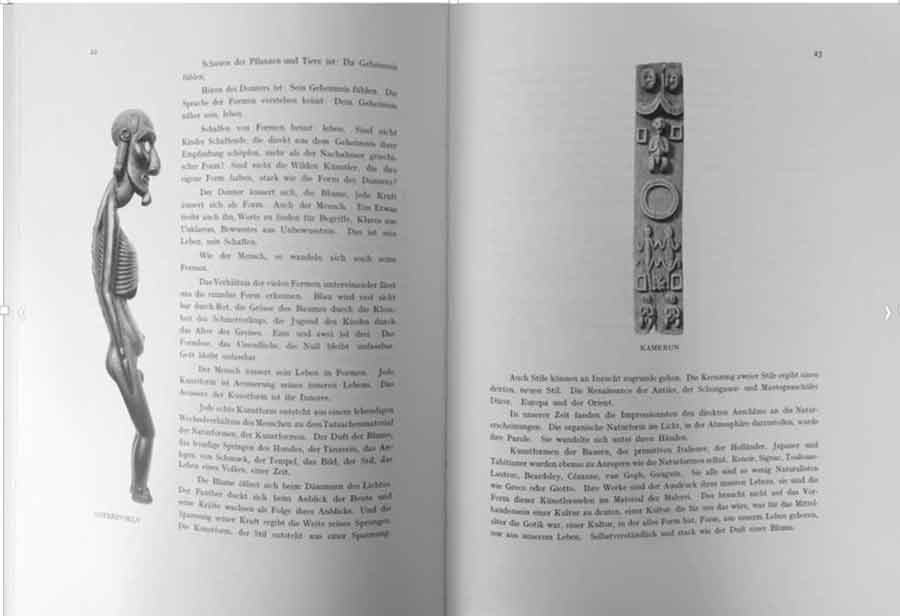
Fig. 9
In the Almanac, on pages 21 to 27, there is an essay by the painter August Macke entitled "Die Masken" (The Masks), in which a relatively small illustration of the pillar in question is embedded (see Fig. 9). Macke's contribution, like all the other texts in the Almanac, was probably written at a joint meeting of Macke, Marc, Münter and Kandinsky in Murnau.[11]
Visits to ethnographic museums are documented above all for Wassily Kandinsky, who was a trained ethnologist, and Franz Marc. Marc had also admired sculptures from Cameroon in particular during his visit to the Berlin Ethnographic Museum in 1911. And it was he who was ultimately responsible for the insertion of the photograph of the post in Macke's article.[12] In his letters to Macke, Marc writes about this. On 14.1.1911 about the objects from Cameroon in the Berlin Ethnological Museum: "I remained amazed and shaken by the carvings of the Cameroonians"; and later that he would furnish Macke's article in the Almanac with "ethnographic wonders" (MW).[13] In the text itself there is a single, very brief reference to "carved and painted pillars in a Negro hut", by which presumably the post was meant.
The text itself represents Macke's conception of art. In it, "intangible ideas", "mysterious forces", an "invisible God" express themselves in the world of appearances and "cultic expressions". The invisible materialises in the visible. This realm of the visible includes not only art, such as that of Giotto or van Gogh, who are classified as 'primitive', but also nature. Children's drawings, the folk art of the 'primitives' and 'savages' or non-European cultural forms are also expressions of the mysteriously invisible. These themselves are - and this is decisive - equal to each other. There is no hierarchy, no distinction between high and low, between high art and popular culture. All forms speak - as Macke characterises it - in "strong language". For Macke, the pillar in the museum is then an example of "the tangible form for an intangible idea, the personification of an abstract concept" (Macke 24). He also calls this the figure of an "idol".
The approach underlying this thinking sounds familiar; we have known it since the Platonic theory of ideas. However, this approach does not justify the selection of this particular post, as other posts from the museum's collection would also have been available.[14] Here one can only assume. I suspect that there are various factors that led to the selection: the archaic power of the forms; the initially wild and carefree-looking, additive combination (or montage) of the various principles of representation in the individual motifs (concrete - abstracted, geometric - organic, symbolising - depicting), which on closer inspection, however, then reveals itself to be consciously composed; or the coarse, physically perceptible materiality of the cracked, thick block of wood in impressive dimensions. PdGY also speaks of "wonderfully composed".
In the work, everything is represented with great sensual power that is the opposite of an "empty" image in European "cultures that have already passed through a thousand-year course, like [...] Italian Renaissance" (Macke 24) and from which Macke renounces: "We must bravely renounce almost everything that has hitherto been dear and indispensable to us as good Central Europeans [...] in order to get out of the fatigue of our European lack of taste". (Macke ibid.)
In art lessons, the question arises to what extent the image that Marc or Macke create of the pillar (as representative of the idea of an idol) goes together with what the object presumably was and is in its original context. Or to put it another way: are they designing a certain, exotic image that does not correspond to the object itself? [15]
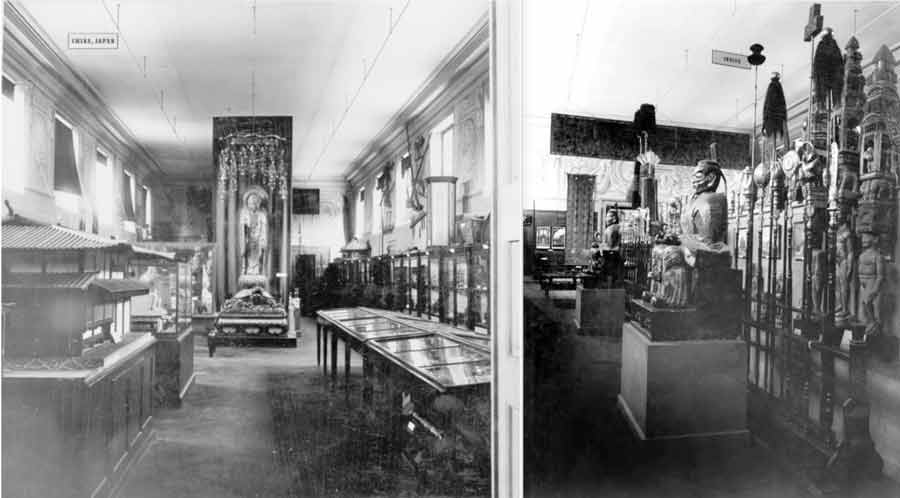
Fig. 10 Historical photos of the exhibition of the India Department in the Munich Museum around 1910 (source M5K)
References
- GI: Juliane Glahn and Marta Krus: CAMERUNS RIGHT TO CULTURAL OBJECTS. https://www.de/prj/zei/de/pos/22656808.html
- Kecskési 1999: Maria Kecskési. Art from Africa - Museum of Ethnology Munich. Munich (Prestel) 1999
- Kecskési 1976: Catalogue for the exhibition African Art. Andreas Lommel (ed.). Munich (Bruckmann) 1976
- M5K: Staatliches Museum für Völkerkunde München (ed.). The Blaue Reiter and the Munich Museum of Ethnology. Munich (Hirmer) 2009
- KG: Karin Guggeis. The Blue Rider Post. (2021): https://www.explore-vc.org/en/objects/expanding-the-canon-of-art-at-the-global-north.html
- PdGY: Patrique deGraft-Yankson. The Veranda Post. (2019) https://www.explore-vc.org/en/objects/the-veranda-post.html and oral interview on 23.4.2022 in Bayreuth, Iwalewahaus.
- PHSAA: Paul-Henri Souvenir Assako Assako. Information by email 20.5.2022
- Wikipedia: Cameroon & Max von Stetten
- MW: Macke Wolfgang (ed.). August Macke - Franz Marc: Briefwechsel, Texte und Perspektiven. 1964. Cologne (DuMont).
- Macke: Macke August. The Masks. In: Almanac "Der Blaue Reiter", 1912, edited by Franz Marc and Wassily Kandinsky, pp. 21-27
Appendix on iconography
- Anthropomorphic figures: ancestral couples / guardians and protectors of the royal residence. These anthropomorphic figures are treated with respect as extraordinary personalities. They are considered ensouled beings, spirits with supernatural powers. (PHSAA) Depiction of all human figures in similar postures: theme of prayer and submission to spirituality. (PdGY)
'Front' side from bottom to top:
- Two people: Ancestral couples / guardians and protectors of the royal residence (PHSAA). People pray for the guidance and protection of the ancestors (PdGY).
- Lizards: The symbol of the lizard warns everyone; it symbolises death. (PHSAA) PdGY sees here two crocodiles (ancestral souls returning to live with humans) instead of lizards.
- Circle: motif of the sun, symbol of life and power; the moon, image of woman and symbol of fertility. (PHSAA) The circle represents completeness, holiness, perfection and other attributes attributed to the supreme being (God). (PdGY)
- Kneeling figure: King or priest (PdGY)
- Line of demarcation between the spiritual and the physical world
- Two heads above: Ancestors (PdGY)
'Back' side from bottom to top:
- Python (geometric frieze at the bottom of the 'back' side): royal totem/sacred python, guardian of the dynasty (PHSAA).
- Male figure with chin beard as emblem of sovereignty (Kecskési 1999)
- Enigmatic form with a pair of horns ending in a hand (?) at the bottom (Kecskési) on a rectangle with two flanking lizards.
- Anthropomorphic figures
- Circular area
Footnotes
[1] The object is variously referred to, mostly in relation to its architectural-functional context: lintel or "te ken dy dye" (in the local Bandjoun language - PHSAA), porch post, house front pillar, post, cult house post (M5K, p. 17), Cameroon post / family crest (Macke at M5K, 13, 24). Post, however, in the sense of sign (post-it) is suggested by PdGY to address the communicative function. Other designations do not address the function, but limit themselves to the given, perhaps to avoid any pre-interpretation: 'sculpted wooden block' (Kecskési 1999 n. 108) or 'large carved square wooden block' (Kecskési 1976, p. 22).
[2] The first German trading posts were established in Cameroon as early as 1868, and in 1891 German military "expeditions" were launched in Cameroon. In 1884, the German Consul General concluded protection treaties with regional rulers and thus proclaimed the protectorate of Cameroon as a German colony. The seizure of the hinterland, which included the grasslands, took place over the course of the following 30 years. (Wikipedia) Even if the provenance is still not clear today, one can certainly share the Humboldt Forum's assessment of such objects that - even if they were not looted through acts of war - they are nevertheless "an expression of unequal power relations and structural, colonial violence". (https://www.smb.museum/nachrichten/detail/ethnologisches-museum-weg-frei-fuer-die-rueckkehr-der-ngonnso-nach-kamerun/)
[3] In the entry book it is noted: "Gr. square block, 1.80 cm high made of heavy wood, carved on both sides with humans and lizards, heavily damaged by termites". (https://onlinedatenbank-museum-fuenf-kontinente.de/) In 1895 Stetten published detailed "Travelogues" in the Deutsches Kolonialblatt.
[4] http://www1.biologie.uni-hamburg.de/b-online/afrika/kamerun/palast.htm; http://www1.biologie.uni-hamburg.de/b-online/afrika/
[5] The block is almost certainly worked with a chisel.
[6] "decorated with geometric, anthropomorphic and zoomorphic forms" (PHSAA)
[7] All performers avoid a complete decoding. They only make suggestions for individual motifs.
[8] It could have been the house of a 'priest' whom one could consult there and through whom or ancestors one could pray to God (PdGY).
[9] "Expression of the cosmogony of the universe of the peoples of the Bamileke plateau; expression of the belief system" (PHSAA).
[10] The assertion of power is also included by PHSAA.
[11] Catalogue: August Macke, Lenbachhaus Munich, 1987, Bruckmann. Munich. S.164
[12] He simply titled the painting "Cameroon", the name of the country of origin (the country whose sculptures he admired).
[13] There are other illustrations in the text: a bird's head from Brazil, a figure from Easter Island (see Fig. 9), one from Mexico, a bird mask from New Caledonia, a cloak from Alaska[13] and a child's drawing entitled "Arabs". Except for the child's drawing, all objects are from the then Royal Ethnographic Collection in Munich (M5K, p.11). They are only titled with the respective country of origin, e.g. Cameroon. Macke was obviously involved in the selection as well as the layout, as his layout sketch shows (M5K 24).
[14] It is not certain what was shown in the presentation at the Royal Ethnographic Collection in Munich at the time, which covered 400 square metres in six rooms in the north wing of the Hofgarten arcades in Munich. The only thing that is certain is that photos of the ten objects depicted, which came from various parts of the world, were lent to the artists for the publication of the Almanac. Photos of the presentation do not exist. "Whether Marc and Macke [actually also] saw the work in the exhibition at that time can be assumed with a high degree of probability, since it is after all very large and thus impressive." (Information Karin Guggeis 26.7.2022)
[15] In this context, it seems of interest that neither Marc nor Macke take up in their own pictorial language the aesthetics of the non-European works they "celebrate" here.
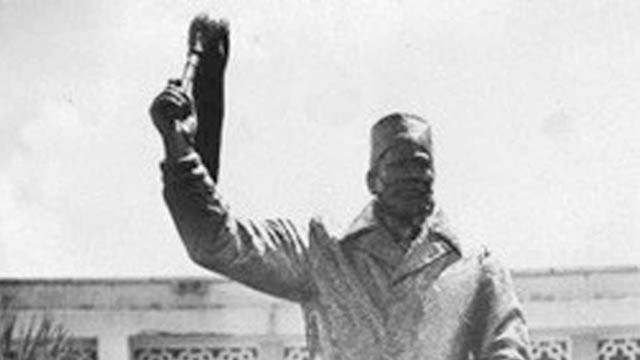
-
 Lydia Waithira Muthuma
Lydia Waithira MuthumaThe two statues
Walking around the rest of Nairobi’s city centre one comes across other statues that have no viewing restrictions. I comment on two of these that resonate, in a particular way, with the narrative of founding postcolonial Kenya: Kenyatta’s 1973 and Kimathi’s 2007 statues.
Kenyatta (c.1894-1978) the first president and founding father of postcolonial Kenya, had a second statue made out of cast iron, by James Butler, a British national. It was finished in 1969, shipped to Kenya and unveiled in 1973. It depicts Kenyatta wearing the robes of a university chancellor –he was the chancellor of University of Nairobi from 1970 to 1978. It stands in City Square.
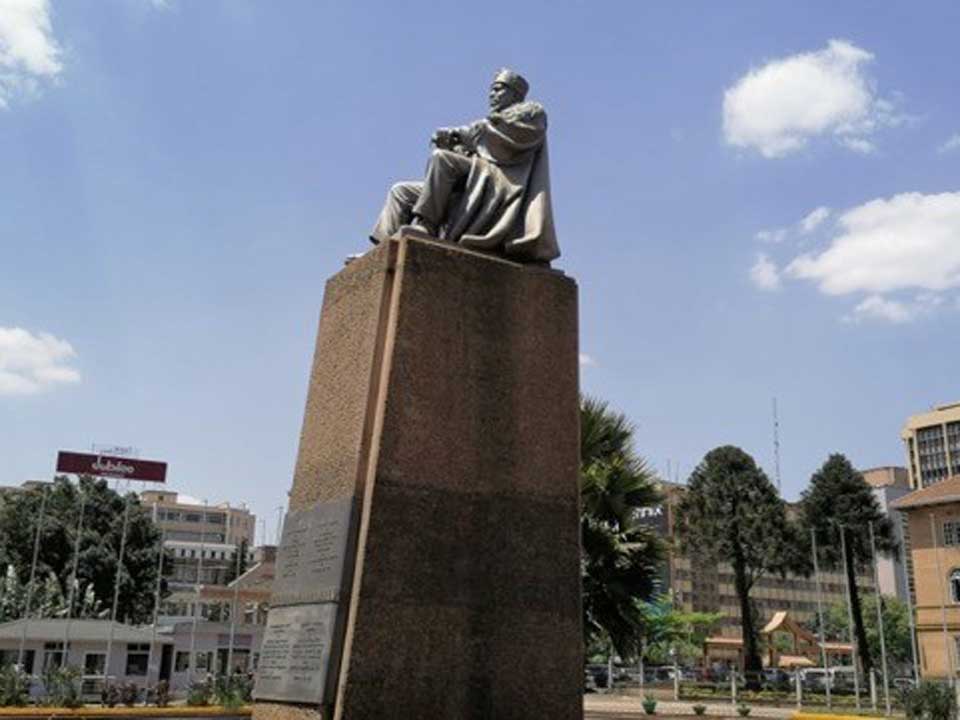
Figure 2. James Butler, Jomo Kenyatta, Nairobi, City Square, 1969 (unveiled in 1973), Bronze, 750 cm © Lydia Muthuma
Kimathi (1920-1957) also has a statue installed along Kimathi Street. He is the self proclaimed Field Marshal of the anti colonial Kenya Land and Freedom Army (KLFA) colloquially known as the Mau Mau. This movement was proscribed in colonial times and during the era of the first and second presidents of Kenya (1952-2003). But in 2003, Kenya’s third president, Mwai Kibaki, eventually unbanned Mau Mau and commisioned a statue in honour of Kimathi. The sculptor, Kevin Oduor, at the invitation of Kenyatta University's Department of Fine Art, made this statue.

Figure 3. Kevin Oduor, Dedan Kimathi, 2006 (unveiled in 2007), Bronze, 450 cm © Lydia Muthuma
The two statues (excluding the 1964 one) have similarities and differences that can be considered within the context of political history or through the artistic lens since they form part of Nairobi’s visual urban landscape. These statues represent two political figures, considered national heroes and therefore meriting public showing. Mass and volume, employed as the basic building blocks, are used to express emotional energy in a bid to engage the viewer’s affects. The chosen site of each statue (the situ) mediates the public’s affects.
Siting the statues
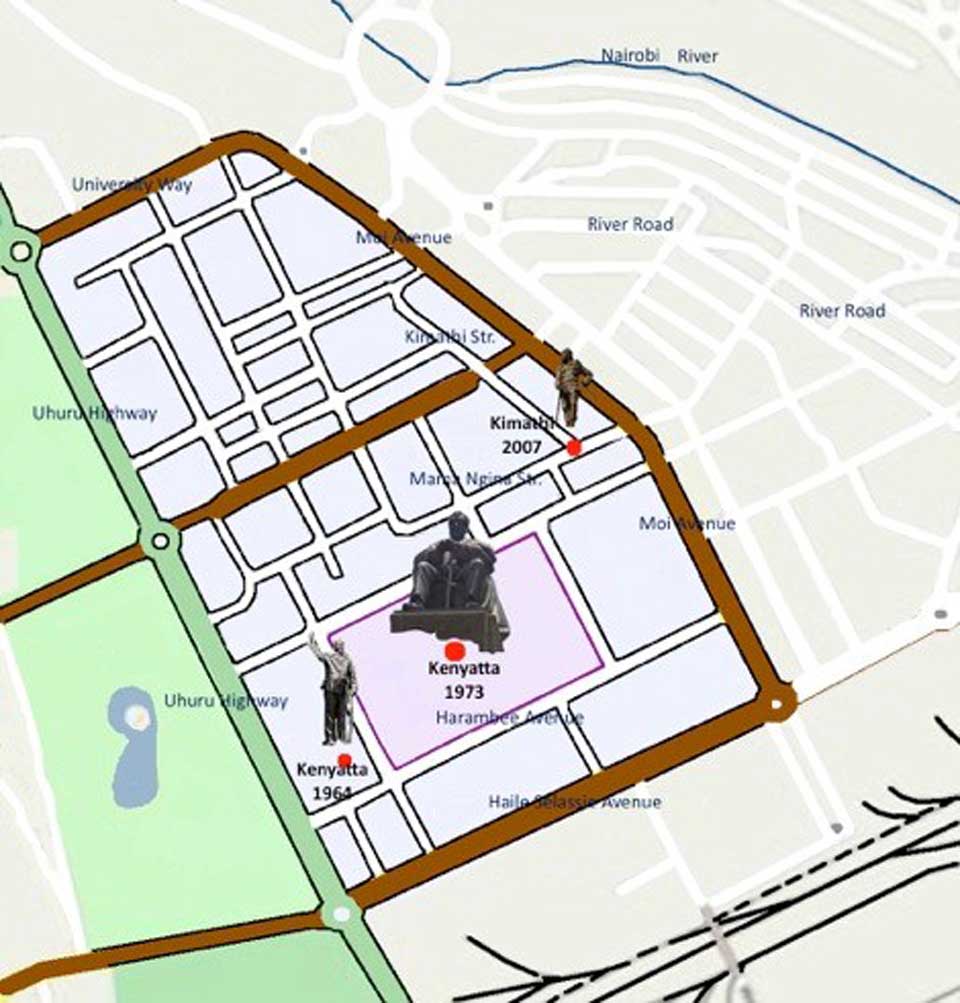
Figure 4. Location of the different statues © Lydia Muthuma
Jomo Kenyatta’s 1973 statue is placed in City Square with about one acre of land setting him apart from the surrounding buildings. Anyone walking into City Square, walks into this statue because it is the focal point. In traversing the square or accessing nearby buildings, one must pay visual homage to Kenyatta’s 1973 statue because of its setting; the geographical centre of the square (cf. figure 4 & 5).
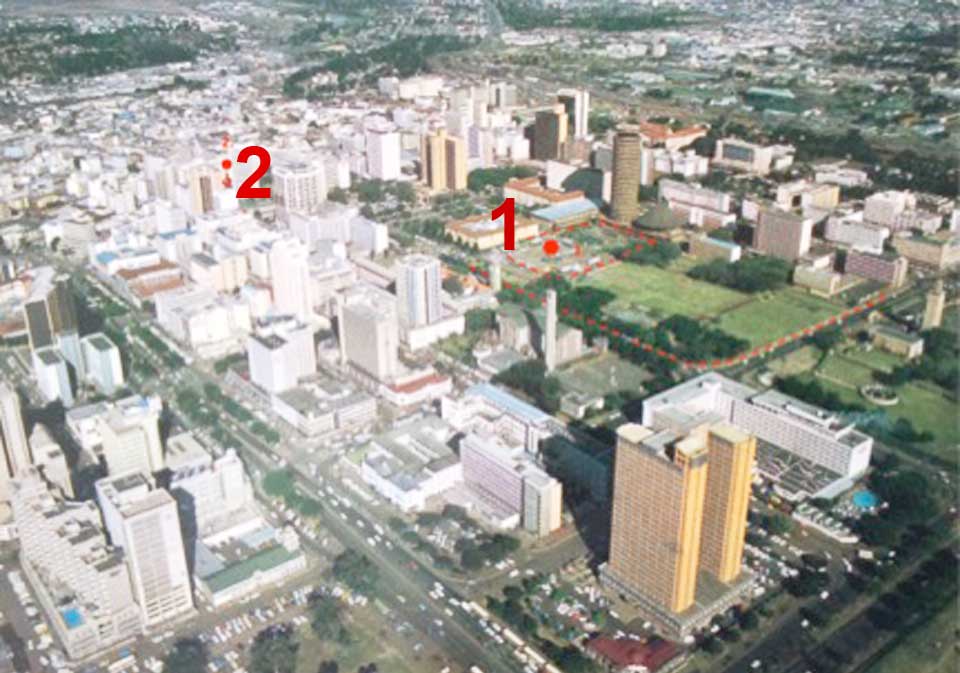
Fig. 5 City Square
Kimathi’s statue is set in different surroundings. By the year 2007 when Kimathi’s statue was installed, empty 1-acre plots, other than City Square, were not to be had in Nairobi’s centre. In fact a heroes' corner was designated about 5 km due west, in 2006, but was deemed unsuitable for Kimathi's statue. The street named for him, right in the middle of the city, was the preferred site. So on a tall plinth, Kimathi stands at the southern end of Kimathi Street. (cf. figure 4 & 5) There is hardly any viewing distance because Kimathi’s statue stands on a tiny traffic island, amidst tall buildings like Corner House (15 stories) and the Hilton Hotel (20 stories). The statue is in the middle of a busy traffic junction – where Mama Ngina Street meets Kimathi Street. And because it is immersed in both vehicular and pedestrian traffic, viewers are treated to short interrupted glances of Kimathi, atop a pyramid-like plinth that was designed by members of Kenyatta University’s Department of Fine Art. Fleeting, staccato snap shots that punctuate the flowing vehicular traffic comprise the everyday viewing experience. Lack of space, attendant hubbub and noise are inextricably bound up with Kimathi’s statue.
Meanwhile ample space and limited, if any, vehicular or pedestrian traffic, are the elements surrounding Jomo Kenyatta’s 1973 statue. He is represented twice life size to Kimathi’s mere life size. Unlike Kimathi, Kenyatta sits comfortably on a tall rectangular plinth. No wonder some say of Kenyatta's 1973 statue, “he is majestic, aloof...”, they are responding to—among other factors— the viewing experience, the physical placement and context of this sculpture. (cf. Figure 4 & 5)
Through the artistic lens
Statues of great men are often linked to significant historical happenings. Investigating their historical context is one way of ‘reading’ them. But it is not the only one. They can also be viewed as artistic components of the landscape they inhabit.
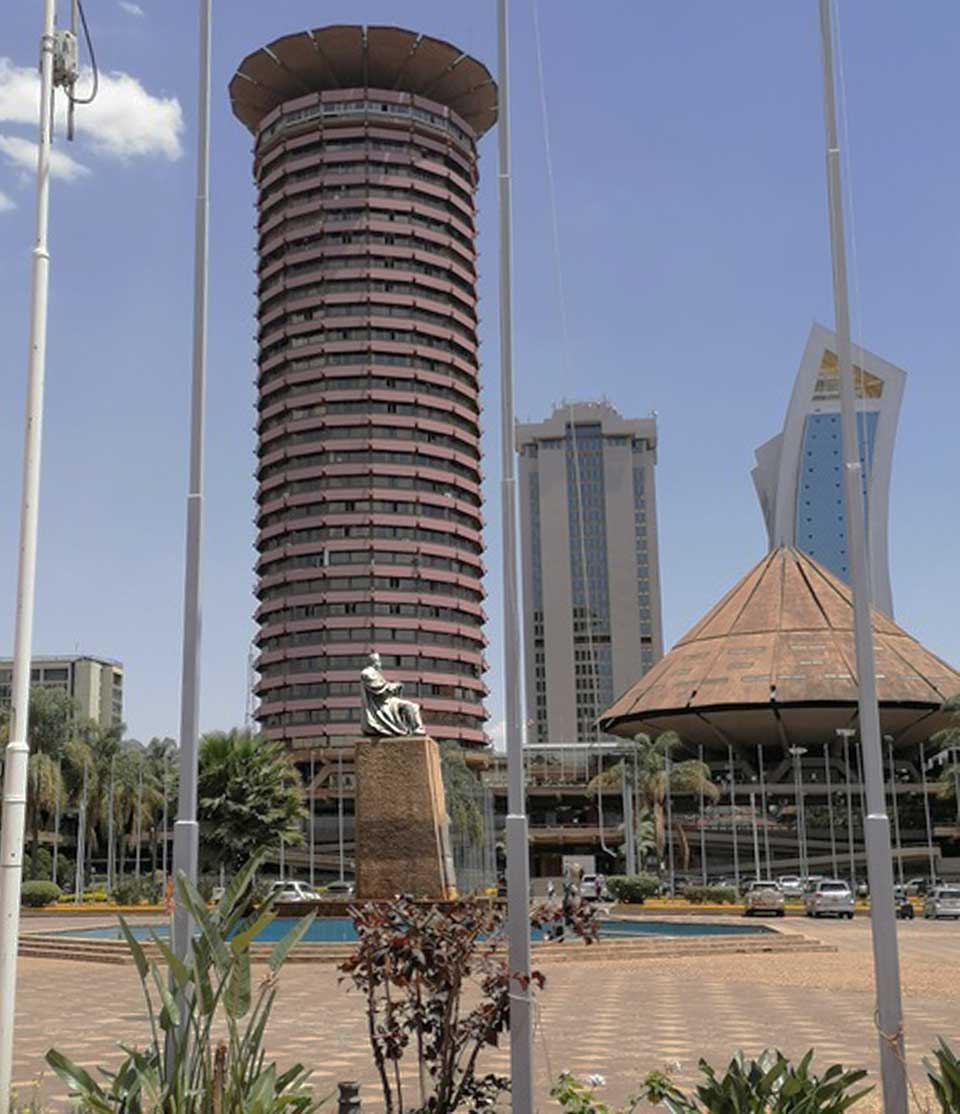
Figure 6 Kenyatta’s 1973 statue surrounded by the iconic Kenyatta International Convention Centre and Times Tower. © Lydia Muthuma
While the 1964 statue of Kenyatta was installed to mark the attainment of the country’s Republic status, (cf. figure 1.) it does not form the main subject of this article because of its inaccessibility to the ordinary Kenyan.The second statue of Jomo Kenyatta, which is the subject of this paper, was installed in City Square in 1973. Its situ (the 1973 statue) is about half a kilometer away from the Parliament buildings as shown in figure 4. It is curious that ten years after unveiling the first statue of Kenyatta (1964 to 1973) a second statue of the very same president was installed in City Square, near the first one. One wonders what prompted the erection of this second statue. Was the first lacking in any way? Because contemporaneous historical happenings do not supply a plausible answer, I turn to reasons artistic to account for the ‘double representation’ of Jomo Kenyatta.
City Square was designed in the 1930s as Nairobi’s most central public space. During this era, the colonial government was working hard to convince London that Nairobi could become the capital of a ‘federated’ East Africa with internal self rule. Kenya was to go the way of Australia or Canada within the British Empire. Nairobi Town Square (now City Square) was designed to show off the High Court (now Supreme Court). The visual focal point of Town Square was a statue of the then reigning monarch, King George V of Britain. But when the second world war signaled the beginning of the end of the British Empire, and the Mau Mau rebellion, similarly signaled the end of colonial rule in Kenya, the statue of King George V had to come down. Change in political leadership caused change in displaying of statues. Therefore from 1964, when this statue was dethroned, City Square was without a focal point – visually.
Even with the addition of the Kenyatta International Convention Centre (KICC) building, as a visual extension of the Supreme Court, the square still lacked visual balance and focal point. Thus in 1973, a second statue of Jomo Kenyatta was installed in order to solve this aesthetic problem. It took up the place that had borne King George V. The sculptor of this second statue, James Butler, was to fabricate work for a given site.It is in this sense that Kenyatta’s 1973 statue is considered site specific –the site was incomplete without the statue because previously it had held the statue of King George V, which was removed in c. 1963. Between 1963 and 1973, this spot was without a statue. Re-filling the gap, in this site, supplies a rationale for the repeated representation of Jomo Kenyatta –outside parliament in 1964 and in City Square in 1973; same person in the two statues.
Dedan Kimathi’s statue is not site specific: it was first fabricated then a site decided upon –later. In comparison to Kenyatta’s 1973 statue, Kimathi’s, while smaller in size, is provided with little, if any, viewing distance. It is placed amongst tall buildings at the intersection of two busy thoroughfares. However, whatever its artistic (de)merit, it comes with a wealth of historical re-imagining. Kimathi’s statue is considered an active element in the processes of decolonisation today. (Mwangi, E. 2010)
Again, unlike Kenyatta’s 1973 statue, Kimathi’s was not fashioned during his life time. It is posthumous since Kimathi was condemned to death by hanging, in 1956, for the crime of unlawful possession of a firearm. In reality though, his crime was rebelling against colonial rule as leader of the KLFA also known as the Mau Mau. The sentence was carried out in 1957 and his body deposited in an unmarked grave.Fifty years later – 1957 to 2007 – Kimathi’s statue was unveiled. The time lapse calls for a scrutiny and rationalization of ‘re-calling’ him from the dead. Why the need to represent him, by installing a statue, 50 years after his death? Political history is rife with explanations that are still on-going. (Julie MacArthur, 2019)
An artistic probing of Kimathi’s statue; if it brings back this Mau Mau hero to life and whether it was meant to, presents several challenges because the statue appears more symbolic than an actual re-presention of Kimathi. This is because of its size and situ. Its scale, in comparison to the adjacent built environment, is miniscule. It does not command viewership although it is right in the middle of the public. Its size renders it pedestrian and somewhat not worth more than a passing glance. There is little about it to catch the eye of a passerby. It can be mistaken for one more ‘live’ pedestrian attempting to cross the street. It is ‘camouflaged’ by its size which makes it blend into the pedestrian traffic. Its success, in engaging the viewer’s affects, is debatable. And a significant contributor is the statue’s site.Once Kimathi’s statue was completed, a decision was arrived at to install it at the junction of Kimathi and Mama Ngina Street, within busy vehicular and pedestrian traffic. Viewers are treated to snap shot sights of it amid the unending caravan of commuter buses. This style of ‘seeing’ is easily translated into a similar mode of remembering; snap shot, unclear memories of Kimathi – who was he again?
Conversely, in City Square, Jomo Kenyatta sits in the absence of interfering traffic; in the absence of impinging tall buildings and with ample viewing distance. Commendations like: “the statue (Kenyatta’s 1973) is an island by itself and can be approached from multiple areas both visually and physically which is a valuable status within space defining elements (…) It has the unmistakable character of an icon and can easily be the best defined statue in the country (Kenya),” are not unusual. Truly, the site of a statue influences the viewer’s response. http://www.archidatum.com/projects/jomo-kenyatta-statue-james-butler/
Conclusion
Perhaps because of the historical circumstances the two statues –Kenyatta’s 1973 and Kimathi’s 2007 are viewed differently. They also evoke varied responses. What cannot be overlooked is that their siting (situ) contributes to their visual perception, which in turn influences the remembrance and mental picture retained by the public.
The siting of both statues corresponds with Kenyatta being the central character in Kenya’s decolonisation narrative while Kimathi occupies the more peripheral position. Kenyatta (1973) sits in City Square while Kimathi is amid the hubbub of downtown Nairobi.
References
- http://www.archidatum.com/projects/jomo-kenyatta-statue-james-butler/
- Mwangi, E. (2010). The incomplete rebellion: Mau Mau movement in twenty-first-century Kenyan popular culture. Africa Today, 57(2), 86-113.
- Shanguhyia, M. S. (2019). Julie MacArthur, ed. Dedan Kimathi on Trial: Colonial and Popular Memory in Kenya’s Mau Mau Rebellion. Athens: Ohio University Press, 2017. xxvi+ 406 pp. Bibliography. Index. Paper. ISBN: 978-0896-803176. African Studies Review, 62(2), E12-E15.
published October 2020
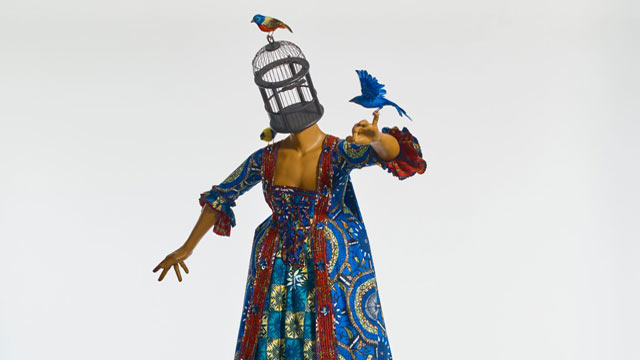
-
 Bernadette Van Haute
Bernadette Van HauteMrs Pinckney and the Emancipated Birds of South Carolina (2017) is a sculpture in the round composed of a headless, female, ‘white’ mannequin swathed in historical dress and balancing on a globe. In place of her head is an empty birdcage from which three birds have escaped. The work was created by the internationally renowned artist Yinka Shonibare (born 1962) who is a black man of Nigerian descent living in the United Kingdom. He can thus be identified as a member of the African diaspora. In his artworks he usually engages with concepts that are related to the politics of colonialism and the slave trade and explores cultural identity in the context of globalisation. [1] While his creations are deeply critical of western imperialism, he always makes sure to render them visually alluring and engaging to elicit a visceral response. [2]
This particular artwork was co-commissioned by the Yale Center for British Art and Historic Royal Palaces, Kensington Palace, and created especially for the exhibition "Enlightened Princesses: Caroline, Augusta, Charlotte, and the Shaping of the Modern World".[3] This adds an aura of seriousness of intellectual and aesthetic intent to the sculpture. In the title of the work, the artist has identified the woman as Mrs Pinckney, or Elizabeth (Eliza) Lucas Pinckney, who at the age of 16 was put in charge of her father’s plantations in South Carolina. [4] She had a major influence on the colonial economy by developing indigo as an important cash crop to be processed as dye. [5] The sculpture is said to be the artist’s response to Eliza’s encounter with the German Princess Augusta in 1753 which further identifies her as a member of the social elite. [6] All of the above components help to retrieve the identity of the subject, the ideology being addressed as well as the message in the image.
The artist has encoded his artwork with visual tropes that clarify and enforce his message. While the style of Eliza’s dress is based on 18th-century fashion, the fabric used is Dutch wax cloth which Amah Edo describes as a “marker of Africanness”. [7] Manufactured in Europe but using the Javanese batik printing technique, the cloth “came to be produced specifically for West African markets in the 1890s … [and] its aesthetic was adapted by manufacturers to suit these new consumers’ tastes”. [8] Now widely perceived as symbolic of tradition, the Dutch wax cloth is regarded “as a high-end commodity desirable to elite customers”.[9] The material of the woman’s dress thus not only identifies her as a member of the elite but also refers to Africa as the source of her wealth: it is through the labour of the African slaves that Eliza was able to run her family’s plantations in America. Likewise, the blue of the material – and the bird on her finger – is a direct reference to her successful cultivation and processing of indigo. It can thus be seen that the artist explores concepts of race and class through a careful choice of materials and colours in his imagery. By dressing the white woman in African cloth, he complicates history and racial identity in an effort to startle the viewer’s conscience.
As the plantation’s manager, Eliza occupied a position of power which is visually manifested by her being placed literally on top of the world. The latter is represented by an eighteenth-century globe that shows the colonial territories of the British empire. [10] Eliza is thus turned into a symbol of white superiority and privilege granted by the politics of imperialism. Her balancing act, however, proves to be precarious and elicits tension as the ball can roll at any moment and topple her from her position of power. It is also interesting to note that the globe is an attribute of Fortune, the fickle goddess of antiquity. Fortune is blind and even eyeless, and the globe “on which she stands or sits, originally indicated instability, but to the Renaissance it was rather the world over which her sway extended”. [11] The headless Mrs Pinckney thus shows a cunning resemblance with the antique goddess Fortune “who bestows her favours at random”. [12]
The favours bestowed by Eliza relate to her release of the birds from the birdcage. However, instead of flying away to freedom, they come back to her. She playfully lifts her left arm for an indigo-blue bird to perch on her little finger, while another bright-coloured bird sits on her left shoulder and a third one on top of the cage. According to Shonibare, the birds are a metaphor for slaves and her gesture of setting them free symbolises her wish to emancipate the slaves – hence the title Mrs Pinckney and the Emancipated Birds of South Carolina. [13] The narrative thus presents a paradox between the white woman’s privileged yet unstable position as powerful, wealthy mistress and her fickle wish to liberate the black slaves whose destiny is entirely in her hands.
In this work, Shonibare has given his own interpretation of the story of Mrs Pinckney, choosing to focus on the effects of the slave trade and colonisation in the eighteenth century in the United States, then still British territory. While the playfulness of his rendition and its aesthetic appeal conceal the harsh realities of enslavement, the dehumanisation of black people as a result of colonial politics still filters through in the form of brightly coloured birds which, although set free, are so tamed – read oppressed and subjugated - that they are not able to fly.
[1] https://en.wikipedia.org/wiki/Yinka_Shonibare (26 July 2021).
[2] Yale News, 2017. Yinka Shonibare MBE (RA): ‘Mrs. Pinckney and the Emancipated Birds of South Carolina’. Video. Yale News, Yale British Art, 25 July 2017. https://news.yale.edu/videos/yinka-shonibare-mbe-ra-mrs-pinckney-and-emancipated-birds-south-carolina (26 July 2021)
[3] Yale News 2017.
[4] Yale News 2017.
[5] https://en.wikipedia.org/wiki/Eliza_Lucas (26 July 2021).
[6] Yale News 2017.
[7] Edo, Amah M. (2019). From African print to global luxury: Dutch wax cloth rebranding and the politics of high-value. In Mehita Iqani and Simidele Dosekun (Hrsg.). African luxury: Aesthetics and politics (pp. 77-92). Bristol, UK / Chicago, USA: Intellect, p. 82.
[8] Edo 2019, p. 80.
[9] Edo 2019, p. 85.
[10] Yale News 2017.
[11] Hall, James. 1974. Dictionary of subjects and symbols in art. London: John Murray, p. 127.
[12] Hall, James. 1974. Dictionary of subjects and symbols in art. London: John Murray, p. 127.
[13] Yale News 2017.
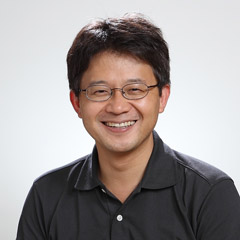 Nobumasa Kiyonaga
Nobumasa KiyonagaThe oeuvre of Yinka Shonibare CBE is often characterised by a colourful and at the same time amusing appearance. This facilitates the viewer's immediate access. This is also the case with his 2017 work Mrs Pinckney and the Emancipated Birds of South Carolina. What one perceives here at first glance is the figure of a lady wearing historical European clothing, a "Robe à la Française" from the 18th century. However, the clothing is unusually colourful. Moreover, the woman is standing on a sphere, albeit shakily and leaning forward somewhat. This image quickly connects with the traditional European iconography of "Fortuna", i.e. the admonishing, allegorical symbol of "fate". It turns out that the sphere is the globe.
The graceful lady also has a strange head in the form of a birdcage. But its door is open and the three birds have long since escaped. This could be an allusion to Maurice Maeterlinck's The Blue Bird, the central message of which is the obvious true happiness. In any case, the caged head shows us that it is actually our thoughts that tie us down and hinder our actions, as is often the case. Seen in this light, at least this lady has succeeded in unmasking the internalised gender ideology and liberating herself mentally. But is it really a lasting liberation?
Who actually is this lady, this "Mrs Pinckney"? What fate is at stake? She is not known here in Japan, for example. A look at Wikipedia, for example, will help: she is considered one of the first emancipated women in the USA, who achieved prosperity with her pioneering attempt to grow indigo on slave plantations in South Carolina. This dye was in particular demand for military uniforms in Great Britain at the time.[1] That is why the lady is wearing this indigo dress. But where does the artist's reference to Mrs. Pinckney come from? A direct connection is hard to find at first. However, knowing that Shonibare describes himself as a "post-colonial hybrid"[2] - he was born in London as the child of Nigerian parents, grew up in Nigeria and studied in London - and that he very often uses "African wax prints" for his works,[3] one gains more clues about the work.
At present, those wax prints seem to represent "authentic" African life, but they have an Indonesian origin and were made by Europeans, especially Dutch, and sold and distributed in West Africa.[4] In this sense, they are in fact a transcultural product. Through their use, the artist points to the "cultural imagination as a power structure and means of domination"[5] in the spirit of the critique of representation. In this specific work, too, the wax prints, which have something in common with the fate of indigo, find their use in clothing.
Thus, it turns out that the lady functions as the encouraging and, at the same time, admonishing symbol of the emancipation of women, which never proceeds in a linear fashion and is still threatened and endangered everywhere today. Moreover, this emancipation movement must always be seen in an even more complex context, which was and still is connected with the fate of countless people - in Mrs. Pinckney's case, for example, that of the slaves, according to the message of the work.
[1] https://de.wikipedia.org/wiki/Eliza_Lucas_Pinckney (27 July 2021)
[2] Shoji, Sachiko. 2019. “History is Happening Now: What Connects Us All to the Art of Yinka Shonibare CBE.” In Exhibition catalogue Yinka Shonibare CBE: Flower Power. Fukuoka: Fukuoka Art Museum, p. 105. Incidentally, this is the artist's first solo exhibition in Japan.
[3] Shonibare CBE, Yinka. 2019. “Artist Statement. Woman Shooting Cherry Blossoms.” In Exhibition catalogue Yinka Shonibare CBE: Flower Power, Fukuoka: Fukuoka Art Museum, p. 13.
[4] Ibid. According to Shoji, Japan also became involved in the production of those wax prints and their export to Africa from the late 1920s to the mid-1990s. See Shoji 2019, 106-107.
[5] Shonibare 2019.
 Ernst Wagner
Ernst WagnerA life-size, headless, female mannequin balances on a globe showing the African continent from the front. Her Biedermeier-style clothing in bright colours shows a deep décolleté. The fabric pattern is Dutch Wax, which can be inferred from the given information on the work. In combination with the birdcage and the three colourful birds outside the cage, the sculpture is reminiscent of surrealist montages like in René Magritte's artworks.
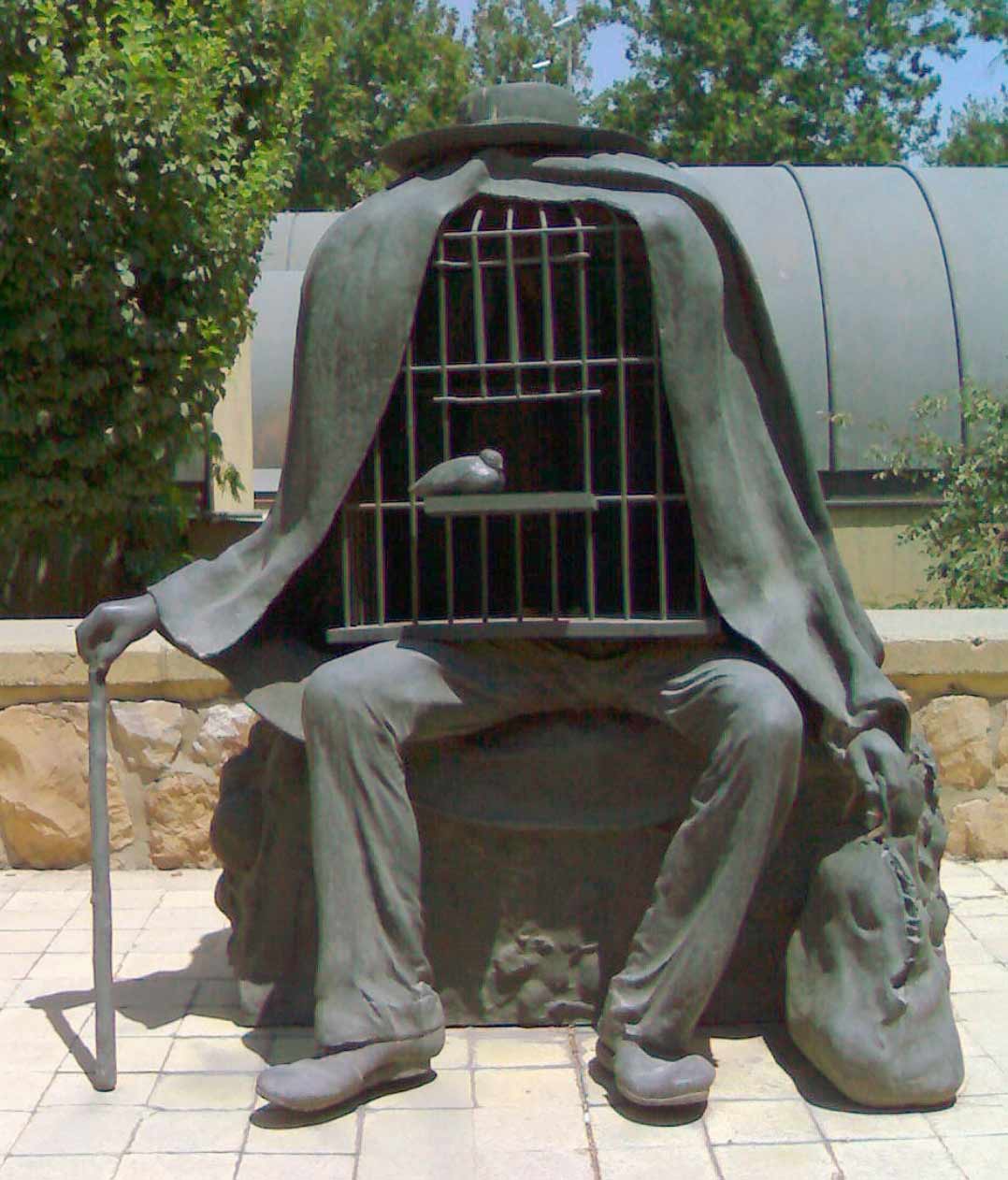 René Magritte, Le Thérapeute (1976), Tehran (Copyright: WikiCommons)
René Magritte, Le Thérapeute (1976), Tehran (Copyright: WikiCommons)The title refers to a concrete iconography that makes research necessary which - as a reward - helps to decipher the birds and the blue dress: Mrs Pinckney refers to a prominent historical woman (Eliza Pinckney, 1722 - 93) whose biography - as one can read on Wikipedia - was deeply entangled with English colonialism and the American War of Independence. Shuttling between North America and England, she was remarkably innovative and entrepreneurial. The birds in the sculpture allude to a specific anecdote when Eliza Pinckney gave such birds as a gift to the mother of the British King George III. The blue of the dress can be seen as an allusion to Pinckney's production of indigo in South Carolina.
The globe and the pattern of the dress - like the title - also allude to the theme of colonialism. Even the material specification of "Dutch Wax" tells a tangled story in colonialism. But the female role model embodied by Eliza Pinckney in her time, obviously denies the usual connotations associated with colonialism, slavery and looting. The birds outside the cage perhaps also make references to the immanent contradiction between freedom and captivity.
Alluding seems to be the most adequate term to grasp the specificity of the visual language of this work. Nothing is clearly asserted, no thesis is put fprward. Rather, a dazzling, assembled, ambiguous figurine stands in the context of 18th-century colonialism, hinting at many themes that are significant also today: women's roles, capitalism, domination and exploitation of nature, colonialism, freedom and oppression. This fits in well with the immediate perception of the object. Looking at the artwork, one gets the impression of a strange balance of lability and stability, of theatricality and ridiculousness, of immediate sensuality and learned knowledge.
Now, the question remains as to how this work is located in the transcultural contact zones. Today, it is exhibited in a US collection of British art, the "Yale Center for British Art". The artist himself is called a British-Nigerian artist. He himself uses his English title of nobility CBE (Commander of the British Empire) in his name. Since documenta 13, he is well known in the context of Global Art. In terms of iconography, the work is also located at these interfaces. Through montage, it merges different associations into an inherently contradictory complexity that cannot be resolved. This creates a fundamental openness that is reflectes when we ask about its meaning: can we read the work as ironic alienation? Or as a commentary on history? Or as homage or, on the contrary, as criticism of the historical Mrs Pinckney? As a reflection of current and very serious issues or as a harmlessly playful object?
A video produced by the museum where the work is now located shows an analogous reception history (Link 1 / Link 2). How does the work constitute the “ideal” viewer? He or she is a decoding, deciphering viewer who allows the iconographic fixation to fail with relish because of the sensuality of the playful object, just as the narrative of Mrs Pinckney fails because of the mannequin's instability. The ideal, contemporary viewer simultaneously enjoys the openness and yet sees him-/herself confirmed in his/her anti-colonial habitus.
 Discussion
DiscussionDiscussion
EW: When I compared all three contributions, I was initially surprised by the large number of common intersections. This certainly points to the global power of interpretation of media representations in English (website of the collection at Yale, Wikipedia), which we could not escape either. We all researched Mrs. Pinckney on Wikipedia, we all trusted the video on the website as a source. But what is interesting now is how differently we deal with it and what different conclusions we come to. I have the impression that in your approach, Bernadette, the story of Mrs. Pinckney plays the biggest role, while in my text this story is rather only a possible reference point. I don't know if you can agree with me.
NK: Yes, I also see these differences. With Ernst, I see more of a fundamental, principled attitude in the analysis of the work. In Bernadette's interpretation, I found the interpretation of the birds as "slaves" interesting. I myself saw in it the - temporarily - liberated soul of an emancipated woman. Moreover, in this context, I also find your reference to the paradox of the actually already liberated "slaves" particularly illuminating, as it seems to have been derived from your discussion of colonial history in Africa.
BVH: When comparing our contributions, I was also reminded of the fact that art is always about other art, hence we looked for precedents that may have inspired the artist. But what I find most exciting about our interpretations are the differences in emphasis on the various meanings that are embedded in the work. For Ernst, the transcultural nature of the work stands out, as well as its openness in meaning. For Nobu, it is the reference to gender ideology and women’s emancipation that forms the core of the work, especially in light of ongoing gender discrimination. For me, it is the historical narrative that led me to interrogate the issue of racial discrimination which also continues today in movements such as #BlackLivesMatter.
EW: I share this, and I would like to follow up with a question. Is it possible that our respective contexts in which we work have influenced this? Not in terms of content – we agree on that – but in terms of patterns of argumentation. If you, Bernadette, place so much emphasis on the story of Mrs. Pinckney, does this perhaps reflect the great oral, meaningful storytelling traditions in Africa? And when you, Nobumasa, on the other hand, elaborate Mrs. Pinckney as an encouraging and at the same time cautionary symbol, does this perhaps reflect the great ethical traditions in Asia? My refusal of direct meaning-making and ethical service, on the other hand, would then be a European-style reflexive evasive manoeuvre to a (preferably unassailable) meta-level?
BVH: Good question indeed. In my opinion, this exercise shows how we are all conditioned by the sociocultural environment in which we live and work. Hence my response, from a South African point of view, focused on the story/history in order to highlight the importance of the work in decolonising the subject. While playfully complicating racial issues in a historical context, the artist mainly celebrates Africanness by means of materials, patterns and colours. This allowed me to infuse my interpretation with African epistemologies. Your response, Ernst, could be regarded as a refusal, perhaps, to acknowledge and engage with the deeper implications of the work and indeed rather shift the focus onto more theoretical concerns as inspired by German art historians? I am keen to hear Nobumasa’s view on this matter.
NK: Ernst's question about whether a Japanese ethical tradition might secretly be reflected in my interpretation is very difficult for me to answer. But as Bernadette has just pointed out, the social context in which we work definitely plays a certain role. While globalisation has erased spatial distances, perhaps not necessarily mental ones. For Japanese today, Africa is still very distant, in the double sense mentioned above. Although Africa is the second largest continent with 55 countries and countless information is available, detailed and nuanced ideas about it are often missing from our consciousness. My leap into the general, or ethical, implication of the work could possibly be explained in this way. Seen in this way, I have probably unconsciously "traced" my own situation. But this also underlines the fact that the critique of representation – in the sense of a critical questioning of pictorial representations – is still as relevant today as it ever was.
EW: I was very grateful to you, Nobumasa, for the emphasis on the ethical, because we always have to include the ethical dimension in the context of education. My argument from a German point of view would be that the interpretation of a work like Mrs. Pinckney must not be arbitrary. That would be the ethical responsibility of the interpreters. We will have to come back to this in a moment when we discuss conclusions for a toolbox for decoding images.
But first I would like to learn more about the differences between our approaches – even though there is a large area of consensus. In the theoretical discussions we had some time ago, we clearly distinguished the Japanese concept of 'kansho kyoiku', the South African concept of 'art criticism' and the European concept of 'work immanence'. Could you elaborate on the question of how these positions are reflected in your texts?
NK: The introduction of dialogue-based art viewing from the USA in the late 1990s revived the field of art education in schools or museums in Japan. Since then, this didactic method, which seems to seek to maximise the viewer's part in interpretation through its strict rejection of knowledge transfer and ultimately prioritises the discussion of interpretation, is still in vogue today. But a crucial question still arises as to how the meaning of interpretation, or meaningful interpretation, is secured without degenerating into mere arbitrariness. In this respect, too, our experiment seems to be very inspiring.
BVH: At the University of South Africa we believe that the basic skills required to interpret objects of visual culture are best taught by beginning to practise art criticism. The proper domain of a critic is the description, interpretation and evaluation of concrete works of art. As a first step in this process, students must learn how to describe and interpret artworks. Essentially art criticism is a practice embedded in western epistemology that has been appropriated to study the art of contemporary Africa in a global context. When investigating the historical arts of Africa, the method remains the same although the local context of traditional culture and customs must be taken in consideration. My interpretation of Shonibare’s work was guided by these very same principles.
EW: Finally, I would like to ask you something with regard to the 'methodological kit' proposed by the editors of this volume: Which methodological approaches for the interpretation of images do you consider absolutely necessary – independent of our respective Japanese, South African or European context? And I'll add a second question in a moment: Does that leave one area that plays a role exclusively in your respective local context?
BVH: From an art historical point of view, the methods best suited for the interpretation of political images stem from a contextual approach which demands critical consideration of the cultural context of the work, its artist and of the social practices and power relations in which it is embedded. As the interpreter, you can apply the iconological method: first describe what you see – formal elements and details – and then identify the iconography, the specific subject and symbolism of the work. Do some research on facts and historical context, as well as the reasons why the work was made or commissioned. Then you can explain how all this information was put together to express the meaning or content of the work and decide what message or ideas the artist was trying to communicate. Because every interpreter comes to the artwork with his/her own worldview, the interpretation will differ depending on that worldview and not on the local context. For example, because I attach more importance to the idea of decolonisation, my contextual approach is combined with and influenced by decolonial theory.
NK: Basically, Bernadette, I gladly agree with you, especially with regard to your gradual approach. I also think it is reasonable and sensible from a pedagogical point of view. But this raises the question of what actually constitutes a "political image" or "when" an image becomes political. Of course, there are pictures or works of art that are obviously and unmistakably recognisable as such, but there are also those that are much more subtle, that are not so noticeable to foreign eyes, or that were not originally created with political intentions, but that in retrospect seem to be quite political. What one considers to be political depends, after all, very much on the view of the observer, possibly even completely apart from the original intention of the creator. In this respect, it seems to me that a fundamental attitude is indispensable for the viewer to be able to keep a mental distance from a picture and its context as well as from himself and his own horizon in order to perceive a picture (also) politically.
EW: Thank you both, because from my point of view I cannot and do not need to add anything more. I completely agree that an iconological basis, as Bernadette has formulated it, is needed. And I am deeply convinced that the reception-historical and reception-theoretical extension that Nobumasa has added is absolutely necessary, indeed indispensable, for the toolbox. I can add nothing to this bundle of methods.
What perhaps came up short in our conversation were the different cultural conditions and the resulting consequences for interpretation. But we'll make up for that on another occasion.
NK: Finally, let me add something to my previous statement. For responsible interpretation, we need above all a willingness to engage in dialogue. I experienced this again in our conversation and our experiment also shows this in an exemplary way.
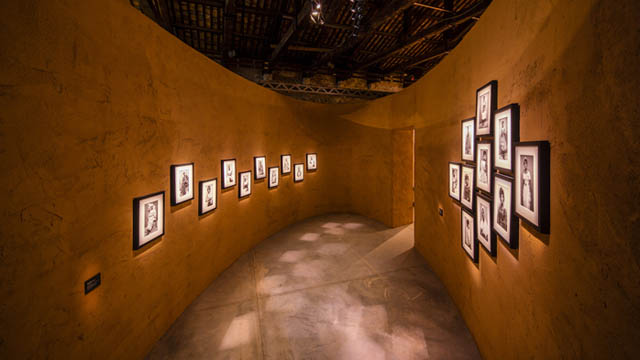
-
 Kwasi Ohene-Ayeh
Kwasi Ohene-AyehThe Ghana National Pavilion at last year’s 58th International Art Exhibition of La Biennale di Venezia served to augment the fervent energy of contemporary art already simmering in its locality. The Pavilion staged a stellar intergenerational selection of six “multi-local”1 artists from Ghana— Felicia Ansah Abban, El Anatsui, John Akomfrah, Lynette Yiadom-Boakye, Selasi Awusi Sosu and Ibrahim Mahama— whose works range between photography, painting, film, video, and installation. Stationed in the Artiglierie within the Arsenale, the Pavilion displayed the artists' works in continuous cylindrical enclosures designed by architect David Adjaye, and executed with laterite soil couriered from Ghana. The nation’s debut outing at the Biennale, titled Ghana Freedom, summoned the “boundlessness” and euphoria in the spirit of self-determination promised in its mid-century Independence moment and epitomised in such cultural events as the World Festival of Black Arts— the first being Festival Mondial des Arts Nègres (FESMAN) which took place in 1966 in Dakar, Senegal, and then the Festival of Arts and Culture (FESTAC) which happened in Lagos, Nigeria, in 1977. “There is no longer any need to look back in the same way as an act of reclamation or reaction”, writes the curator Nana Oforiatta Ayim, since “these pathways remain with us and evolve”(Ayim, 2019, pp. 31).
The emancipatory ideal summarised in the titular of the exhibition is a poignant basis for this evolution given the colonial mediation of Ghana’s formal education in general, and art education in particular (seid’ou, 2014; seid’ou, 2016). In this regard, Ghana Freedom could be said to have countenanced an approach to the practice of art that is unconstrained by the de-contextualised imposition of the beaux-arts tradition which became ingrained through colonial instruction in the Gold Coast (pre-independence Ghana) from the late-19th century to the late-1950s, and which prevailed in the postcolonial mediation from then till the first decade of the 21st century. Exhibitions of this dispensation predominantly lacked curatorial direction. Indeed, the Ghana Pavilion, however obliquely, can also be said to have announced the inventiveness of emergent exhibition practices in the country. For example, Ibrahim Mahama’s early site-oriented and itinerant exhibitions in public places is a pragmatic and critical response to the derelict infrastructural conditions an art practitioner in the country has to contend with. Mahama’s attitude to this systemic neglect is traceable to the interventionist ethic and affirmative politics of blaxTARLINES KUMASI.2
It goes without saying that the spectacular occasion of the Pavilion accumulates cultural capital for the nation in asserting a compelling place and reputation as far as the global mainstream of art is concerned— more especially for a nation which has been treated as a footnote in literature on the history of art in Africa. It is therefore our task to, so to speak, “brush history against the grain” (Benjamin, 1969, pp. 257) by practically intervening in it through such exhibition making ventures. In this vein, the success of the Pavilion highlights two major points for discussion.
The first is a dialectical situation. At a time when cultural institutions and producers are enduring famishing conditions as far as state support or infrastructural systems are concerned, the state has demonstrated that it is possible to alter this fate— seeing as the Ministries of Finance and that of Tourism, Arts, and Culture, respectively supported and commissioned the Pavilion. But now that the impossible has happened, one would have thought that prioritising a National Pavilion would pave the way to launch serious longterm cultural policies ensuring continued presence in Venice itself, and also to invest in and build the necessary economic and cultural support structures for those local practitioners who are in dire need of it. As this is yet to happen, it will be crucial for Ghana to sustain the legacy of the Pavilion beyond the rhetoric of representation, even if it turns out to be a one-time affair.
Secondly, turning our attention to local relevance, the intention of the organisers to, later that year, bring the exhibition to the National Museum of Ghana to be able to show it to local audiences and to generate new knowledge has yet to materialise, for whatever reasons.3 This is unfortunate given the curator’s unequivocal concern for institution building and the “possibilities of artistic development in Ghana itself” (Ayim, 2019, pp. 140). If we keep in mind, apropos Borges, that every exhibition, at any given moment, based on its arguments or claims, “creates its own precursors” and therefore holds the potential to alter our conceptions of both past and future within that genealogy,4 then it presently counts as a missed opportunity not to have optimised Ghana Freedom in terms of creating history rather than solely staging one. What I mean is that the exhibition could have served as an epistemic site through which to actively produce and update the history of contemporary art in Ghana. For example, by citing5 or acknowledging the timeliness in the return of the exhibition to the National Museum falling on the 20th anniversary of South Meets West6 — the seldom talked-about contemporary art exhibition of African artists based on the continent and in the diaspora which also took place at the National Museum in 1999 with an artist lineup including Atta Kwami, Tracey Rose, and Yinka Shonibare— in addition to such “precursors” as FESMAN, FESPAC and “Authentic/Ex-centric".7
Such an instance would have contributed to the intellectual legacy of Ghana Freedom in fulfilling the task of theorising the newly emergent curatorial and artistic paradigms in Ghana, all the while establishing the critical connections, differences, and evolutions between postcolonial and transnational antedatings of such political attitudes to exhibition making. This is especially important when we take the emancipatory promise of contemporary art seriously by considering the exhibition as a system that is not only meant for [re]producing spectacular displays, while taking the commodification of art for granted, but as one which deploys the convergence of symbolic and material consequences enveloped in the immanent tensions of history and power. Particularly when we acknowledge that the National Pavilion structure of the Venice Biennale impedes the institution from turning towards the non-imperialist substance of contemporary art.8
It remains to be seen how far representation of culture as the sole basis of participating in such blue-chip events as the Venice Biennale can get us9 (or any nation with egalitarian aspirations for that matter). Let us also not forget that biennales have not always existed, nor should they necessarily always exist in the future.10 Accepting this, at least, cautions us not to take its existence as well as what it promises for granted. If we succeed in the latter it breeds conformism which can be opposite to true freedom. To boot, the present COVID-19 pandemic has gone a long way to expose the fragility of existing exhibition conventions as it threatens to revolutionize our economic, socio-cultural, health and political sectors on a planetary scale. The institutions by which we traditionally associate the production, circulation and experience of art— i.e. galleries, museums, the art market, etc.— have all suddenly ground to a halt and are facing the challenge to structurally rethink their modus operandi. Therefore the future of exhibition making, as we know it, is what is currently at stake. We are confronted with the task, now, as in previous times in history, to be more inventive with the exhibition form. Bonaventure Soh Bejeng Ndikung, artistic director of Sonsbeek (2020-2024), articulates this grammar of contingency well enough in the epigraph.
Where Ghana goes from here in verifying art as an egalitarian universality and creating particular models to suit its locality is entirely up to us, its protagonists. And so the question becomes, when such real threats and crises have paled the superficiality of representation (in other words, when all the pomp and pageantry of Ghana Freedom has disappeared), what will its historical substance be posthumously based on?
About Selasi Awusi Sosu's presentation at the pavilion see: Link
About Ibrahim Mahama's "Savannah Center for Contemporary Art" in Tamale see: Link
Footnotes
1Taiye Selasi uses this term in her essay Who is Afraid of a National Pavilion? in Ayim (2019 pp.38-44).
2Both Mahama and Selasi Sosu are alumni of KNUST and active protagonists of blaxTARLINES who espouse these transformations. This internationally networked collective has been functioning as the contemporary art incubator in the Department of Painting & Sculpture in Ghana’s foremost Art College at the Kwame Nkrumah University of Science & Technology (KNUST) since 2015, and has radically upended the hegemony of salon style display formats erstwhile ubiquitous in commercial galleries, hotel lobbies, and other spaces which had contrived the realisation of artistic potential primarily for the patronage of tourists.
3Nana Oforiatta Ayim confirmed in her lecture in ibid. (in June) after its opening on May 11th that the show would be at the National Museum of Ghana later that year.
4I appropriate this thought from Jorge Luis Borges in his essay Kafka and his Precursors (1951).
5By citing, I do not mean merely mentioning (since the curator succeeded in mentioning FESMAN, FESPAC and “Authentic/Ex-centric” as precursors), but through curatorial research, and coming to terms with their historical, theoretical, and aesthetic substance and formulating an argument that deals critically with the claims and implications of these events through an analysis of their significance to our own epoch.
6South Meets West is an exhibition organized by Kunsthalle Bern and Historical Museum of Bern in collaboration with the National Museum of Ghana which happened in Accra in 1999 and travelled to Bern in 2000. The exhibition curators are Dr. Bernhard Fibicher (Kunsthalle Bern, assisted by Eszter Gyarmathy), Dr Yacouba Konaté (Université d’Abidjan-Cocody, Côte d’Ivoire), Dr. Yvonne Vera (National Gallery Bulawayo, Zimbabwe). Participating artists are Jane Alexander, Fernando Alvim, Meshac Gaba, Kendell Geers, Tapfuma Gutsa, Atta Kwami, Goddy Leye, Zwelethu Mthethwa, Tracey Rose, Yinka Shonibare, Pascale Marthine Tayou, Yacouba Touré, Minnette Vári, and Dominique Zinkpe. The catalogue included texts by Oladélé A. Bamgboyé, Dr. Bernard Fibicher, Kendell Geers, Clive Kellner, Dr. Yacouba Konaté, Atta Kwami, Simon Njami, Prof. Joe Nkrumah, Tonie Okpe and Sarah Zürcher. See South Meets West (2000).
7Oforiatta Ayim acknowledged her debt to Salah Hassan’s and Olu Oguibe’s curated exhibition at the 49th Venice Biennale in 2001, Authentic/Ex-centric: Africa In and Out of Africa. See Ayim (2019. pp. 140).
8Oforiatta Ayim commented on the problematics of this in our public conversation in op. cit. @thestudioaccra. (2019). Taiye Selasi also points at this issue in her catalog essay.
9The curator of the Pavilion, Nana Oforiatta Ayim, states her motivations for realising the Pavilion as such: “One of my driving forces [for being in Venice] is this idea of representation— of voice, of narrative— of who gets to speak the narrative.” She made this statement in a public conversation I had with her at @thestudioaccra. (2019, June 27). Ghana Pavilion Venice Biennale: Conversation with Nana Oforiatta Ayim. [Facebook post]. https://web.facebook.com/accrastudio/photos/a.1118364178194088/2491384694225356/?type=3&theater. Audio of lecture is in author’s archives, courtesy @thestudioaccra.
10I appropriate this thought from Walter Benjamin who, in a similar spirit of contingency, was speaking particularly of the novel form in literature. See Benjamin (1998. pp. 89).
References
- Ayim, N. O. (Ed.). (2019). Ghana Freedom: Ghana Pavilion at the 58th International Art Exhibition La Biennale di Venezia [catalogue]. Koenig Books.
- Benjamin, W. (1969). Theses on the Philosophy of History. In Hannah Arendt (Ed.) Illuminations: Essays and Reflections. Schocken Books.
- Benjamin, W. (1998). The Author as Producer. In Understanding Brecht: Walter Benjamin. Verso.
- Mitter, S. (2020). Art Biennials Were Testing Grounds. Now They Are Being Tested. 2020. https://www.nytimes.com/2020/05/01/arts/design/art-fairs-biennials-virus.html. Accessed 6th May, 2020.
- seid’ou k. (2006). Theoretical Foundations of the KNUST Painting Programme: A Philosophical inquiry and its contextual relevance in Ghanaian Culture [Unpublished PhD Thesis]. Kumasi: KNUST.
- seid’ou, k. (2014). Gold Coast Hand and Eye Work: A Genealogical History. Global Advanced Research Journal of History. Political Science and International Relations ISSN: 2315-506X Vol. 3(1). pp. 008-016.
- South Meets West exhibition catalogue. 2000. Kunsthalle Bern, NÀWÁO. ISBN 3-85780-124-7.
published May 2020
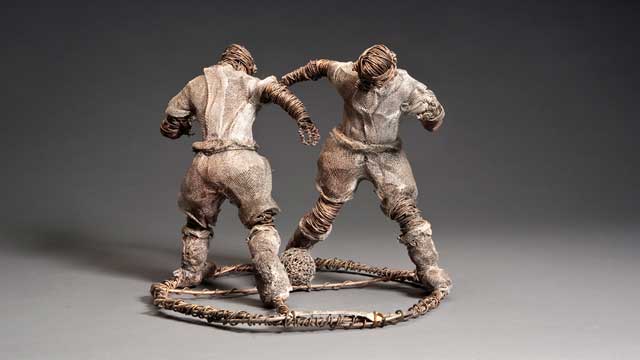
-
 Stefan Eisenhofer
Stefan EisenhoferHis artistic production is informed by the basic concepts of "love", "peace" and "liberty", and he expressly hopes that his works will help to create a better future.
Since 1996, after twenty-five years of working with clay, plaster, stone, cement and wood, Joe Big-Big has mainly used wire, iron nets and barbed wire to produce works with a very characteristic signature. Through the use of metal nets, he produces an effect of lightness and dynamism, even in sculptures several metres high. It was his fondness for big and high sculptures that earned him the nickname Big-Big.
Through his choice of materials he reveals the preoccupations that inform his work: he believes that people are free to decide whether they want to produce or destroy something, to encourage or suppress. In Joe Big-Big's work, wire and barbed wire, commonly symbols of oppression, captivity and division, represent the overcoming of bondage: they stand for prevention and protection. Joe Big-Big plays here with the notion of wire as an everyday material that normally goes unheeded, but which can become an instrument of human creativeness and global understanding through artistic activity. However, in Joe Big-Big's work this metal material seldom loses its ambivalence – for it is also a symbol of human labour and human toil. The artist makes use of these associations in works showing toiling people.
Joe Big-Big is intensely interested in the iconology of his metal materials and the objects he integrates into his works. Padlocks, for instance, symbolize the difficulties we get ourselves into, while keys stand for solving problems, freedom, peace and happiness. Coins represent the money we need to live, and clocks or watches are references to the time we need for solving our problems on the way to a carefree future. The metal materials thus symbolize wealth, strength and power. The artist also deliberately combines old with new metals, as a reminder that one needs to remember the old in order to be able to cope with the present and the future.
The themes taken up by Joe Big-Big come from nearly all areas of human life. His works are concerned with very personal issues as well as with political topics, such as war, poverty, flight, displacement, or the equality of women. He believes that his images speak louder than words, and he intends them to arouse emotions in the viewer, for "art without emotion, feeling or meaning is like a voice or a noise without meaning".
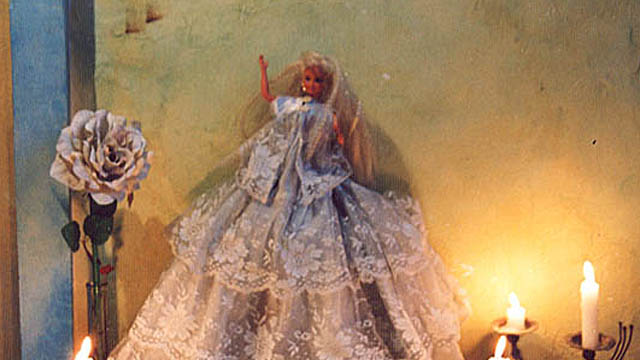
-
 Natalie Göltenboth
Natalie GöltenbothWhen I first entered Anna’s house1, I was surprised to hear that it was a temple of the Afro-Cuban Santería religion, a place determined by the presence of the orichas – the sacred beings of Santería. The objects of the interior did not reveal but seemed to hide their sacred meaning for the uninitiated viewer.
On our way through the house, Anna introduced me to a doll dressed up in white: Obatalá, the paternal oricha of wisdom and justice, with a cream cake on his right and a wide-eyed Bambi on his left. On the sideboard in the corner we greeted Yemayá, the maternal oricha of the sea, represented by a plastic bowl filled with water in which various floating animals swung and a Barbie, whose light blue lace dress complemented the turquoise colored water of the bowl. Finally, in a small wardrobe, the soup tureen of the goddess Ochún was decorated with two elegant Barbies in golden outfits, staring out of the darkness with their always flawless smiles. Two foreigners, charged with western ideals of beauty, who, in this context, had been commissioned with representing Ochún, the oricha of femininity, love and freshwater.
The representation or illustration of sacred powers through everyday objects, such as toys, dolls and knickknacks, have held a strong fascination for me since I literally stumbled upon them in Santero households, and, thus, the question of how this transference of powers and meanings to ultimately mundane objects could occur has long accompanied me on my fieldwork.
How can we interpret the fact that Ochún, the Afro-Cuban goddess of love and freshwater is visualized by a glittering Barbie doll sent to Cuba by Cuban family members living in the USA.
We should take a look back to the beginnings of the history of this religion for a better understanding of these dolls on the altars of Afro-Cuban Santería. Between the 16th and the 19th century, people were moved from one world to another on the sea routes of the transatlantic slave trade, which connected West Africa with the Caribbean (and this, in turn, with Europe), where they would henceforth work as slaves on the plantations of white landowners.
We should consider that people from Nigeria, Togo and Benin who had been deported to Cuba arrived in the New World without any luggage. The carved wooden sculptures of their gods, power objects, masks or costumes were left behind together with the African coastline. The transfer of religious concepts from Africa to Cuba, the Caribbean or Brazil, therefore, took place primarily in the minds of these people and remained dependent on this imaginative reservoir for long periods of time.
Despite the fact that the Cuban social anthropologist Don Fernando Ortiz2 still managed to collect some old carved wood oricha representations which had been produced during the colonial period in the 1930s to 1950s, the tradition of carving sculptures had not been resumed in the new situation in Cuba. The wooden oricha representations of Nigeria and Benin were replaced by smooth porcelain Madonna statues and the serious looking saints of Spanish folk Catholicism. Slaves from West Africa who were forced to worship the statue of Santa Barbara reacted with a phenomenon known as the syncretism of the Caribbean: statues of the Madonna and saints were interpreted as “reservoirs” of African deities and treated as such.
In the course of these syntheses, Santa Barbara is venerated as a representation of the virile oricha Changó, ruler of fire, thunderstorms and lightning. The Virgin of Regla, with her blue and white Madonna robe, is associated with Yemayá, the maternal oricha of the sea, and the Virgen de la Caridad del Cobre, in her church near Santiago de Cuba, is worshipped as Ochún, the oricha of love, creativity and sexuality. This possibility of reinterpretation, of “declaring something to be something else,” is tantamount to breaking the link between form and content and is the precondition for the unusual appearance of Barbies on the Santería altars.
As the colonial supplies in holy figurines diminished, colorful multiples of saints from Cuban mass production are found nowadays instead of the statues. Together with plastic dolls, Barbies or everyday objects, these new assemblages bear witness to the change of time and values, of new desires and new myths that move the people of Cuba today and are visualized on the altars.
Despite the fact that the connection of object and meaning has been blown up in modern Santería arrangements, it remains unclear to what extent new narratives are woven into the conception of the orichas when they are represented by new material objects: how much Madonna can one find in Yemayá, the oricha of the sea, and what is the relationship between a Barbie and an oricha? Referring to Marshall McLuhan’s3 famous statement that the medium is a significant part of the message, we can try a more specific interpretation of Barbies on Santería altars.
Original Barbie dolls are commodities acquired in stores in the USA and sent as gifts by relatives. As commodities and gifts, they mirror family ties that have continued over decades connecting Cuba and the USA, countries that have been politically separated since the Cuban revolution in 1959. In addition, Barbie dolls are not only saturated with the sacred aura of the orichas, they are also simultaneously encrusted with a fine texture of Cuban dreams of consumption and the feverish delirium of departure. Like Catholic saints, Barbies are figurines which are highly charged with their own narrative: the story of Ken and Barbie in the US American glamour world is a story of success, power and consumption. In this sense, Barbies on Afro-Cuban altars represent the fusion of idealized body and lifestyle imaginaries with sacred Afro-Cuban entities and deified ancestors. And, in the end, the forces of the orichas are conjured for reaching exactly these reasons: to provide their adepts with power that enables them to achieve their goals and realize their dreams – be they capitalistic or of another sort.
The reclassification of the Barbie doll from toy to altar object does not happen suddenly. The dolls have to undergo a transition process to become part of an altar installation. The dolls that appear on altars have been subjected to a ritual cleansing ceremony using decoctions of herbs associated with a particular oricha, which allows them to bear the vital power “Aché” of the sacred being. A bundle of herbs and other substances have been placed inside their bodies. Throughout these preparations, nothing has changed the appearance of the doll, which preserves its fashionable style and smile. What has changed is the idea about the object and hence its place – the Barbie is now part of a sacred altar installation.
Barbie dolls watch the strollers from the illuminated doorways that line the dark streets of Havana. Powerful representations of forces, imaginations, places and practices, connecting Africa and Cuba as well as Cuba and the USA, blending boundaries between dolls and gods, toys and power objects, commodities and sacred beings. They connect long-separated families and fragmented religious concepts. They guard the entrances of homes and watch over the desires of their inhabitants, who rely on the power of their Barbie goddesses.
Footnotes
1) Natalie Göltenboth. “Yemayá und der Spielzeugdampfer – Zur Sakralität der Ready-mades auf afrokubanischen Altären.” In Ideen über Afroamerikaner – Afroamerikaner und ihre Ideen. Beiträge der Regionalgruppe Afroamerika auf der Tagung der Deutschen Gesellschaft für Völkerkunde in Göttingen 2001, edited by Lioba Rossbach de Olmos & Bettina Schmidt. Marburg: Curupira, 2003, pp. 107-127.
2) Fernando Ortiz. Hampa Afrocubana: Los Negros Brujos. Miami. Universal, 1973.
3) Marshall McLuhan. Understanding Media: The Extensions of Men. 1st Ed. New York: Mc Graw Hill, 1964
References
- Brown, David H. “Thrones of the Orichas. Afro-Cuban Altars in New Jersey, New York and Havana”, African Arts, Oct. (1993) 44-87.
- Danto, Arthur C. Transfiguration of the Commonplace. A Philosophy of Art. Cambridge, Massachusetts: Harvard University Press, 1981.
- Göltenboth, Natalie.2020. „Invoking the gods – or the apotheosis oft he Barbie doll“ IN: Philipp Schorch, Martin Saxer et al. Exploring Materiality and Connectivity in Anthropology and Beyond. London: UCL
- Göltenboth, Natalie. “Yemayá und der Spielzeugdampfer – Zur Sakralität der Ready-mades auf afrokubanischen Altären.” IN: Ideen über Afroamerikaner – Afroamerikaner und ihre Ideen. Beiträge der Regionalgruppe Afroamerika auf der Tagung der Deutschen Gesellschaft für Völkerkunde in Göttingen 2001, edited by Lioba Rossbach de Olmos and Bettina Schmidt. Marburg: Curupira, 2003, pp. 107-127.
- Holbraad, Martin, and Morten Axel Pedersen. “Things as Concepts.” In The Ontological Turn. An Anthropological Exposition. Cambridge: Cambridge Univ. Press, 2017, pp. 199-238.
- Willie Ramos, Miguel. “Afro-Cuban Orisha Worship.” In Santería Aesthetics in Contemporary Latin Art, edited by Arthuro Lindsay. Washington: Smithsonian Press, 1996, pp. 51-76.
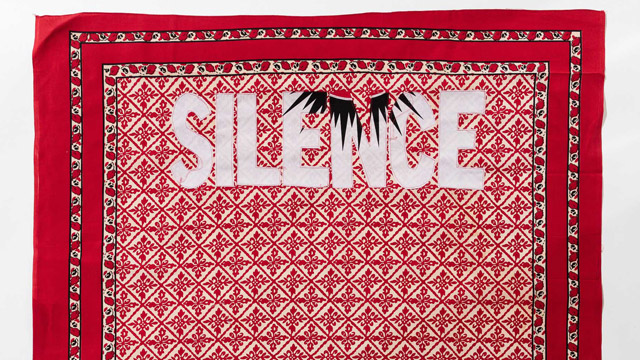
-
 Bernadette Van Haute
Bernadette Van HauteLawrence Lemaoana’s work, entitled SILENCE … FALLS (2017) consists of Kanga fabric with cotton embroidery, measuring 155 x 115 cm. Lemaoana is a South African black male, born in Johannesburg in 1982, who lives and works in Johannesburg. The work serves as an example of the ways in which young black artists in South Africa aim to express a specific South African identity which appeals to the global art world.
The use of Kanga fabric as medium is in itself very significant. Lemaoana states that: "Kanga fabrics [...] are used extensively in my work. Manufactured in the East, and brought to South Africa to be sold in markets and bazaars, the journey of the fabrics speaks of the idiosyncrasies and trade imbalances of globalisation. The textiles themselves though have a wholly different life in South Africa – they are regarded as significant markers of spiritual healing, imbued with great religious and spiritual power, used by diviners and fortune-tellers." (Afronova)
The Kanga cloth is “used specifically in Emandzawe rituals, both as clothing for the sangoma [diviner] performing the ritual and as cloth on the shrine inside the shrine room in which the ritual takes place” (von Veh, 2017, pp. 13-14). The use of this fabric thus establishes Lemaoana’s identification with both global culture and black African culture which does not belong to a mythical past but is still very much alive today. His own familiarity with the sangoma becomes clear when he maintains that the ambiguity of the traditional healer’s utterings parallels that of headlines in the news media. He also exploits the deeper meaning embedded in the three colours white, red and black to heighten the impact of his highly topical messages.
Lemaoana’s work is inspired by current socio-political events and the way in which they are reported in the local media. The composition Silence Falls evokes the #RhodesMustFall movement which began in 2015. This demonstrates the artist’s concern with the plight of the South African youth and his identity as an artist born in the 1980s – the so-called ‘born-frees’ who did not actually experience the ‘struggle’. The works of this generation of artists are described as “symptomatic of the new identity issues of the post-apartheid era. This young generation is appropriating a history that it believes has been confiscated and twisted in order to develop an alternative that takes into account its own subjective experience. Conscious of their responsibilities, these artists are helping to formulate and affirm a specific South African identity” (Pagé and Scherf, 2017, p. 8).
Lemaoana expresses his concern with socio-political issues through a critical engagement with mass media in South Africa. He is particularly concerned by the ability of the local media to shape social consciousness. By isolating news headlines and appropriating political slogans in his very own cynical way he “turns didactic and propagandistic tools on their head” (Afronova). As Lepage (2017, p. 117) states, Lemaoana uses the power of “words as favoured instruments in the political struggle”.
The importance of Lemaoana’s work is vested in his participation in the Fondation Louis Vuitton exhibition in Paris in 2017. The exhibition was divided in three parts; the first one was entitled Being there: South Africa, a contemporary scene and aimed to show South African vitality through the works of 16 artists. In the accompanying catalogue the curators Suzanne Pagé and Angeline Scherf (2017, p. 8) explained that their choice of artists was “based primarily on the action of the artists themselves, on their engagement with the current economic and social institutions, their awareness and conviction that they can act and play a role: BEING THERE”.
Interestingly the curators also comment on the fact that this younger generation of artists, in the context of ongoing economic and social divisions more than two decades after the end of Apartheid, sees it as its mission to transform “disenchantment into the energy for renewal” (Pagé and Scherf, 2017, p. 8). Achille Mbembe (2017, p. 16) elaborates on the current tensions in South African politics and culture which have led to a stalemate. In a society where consumption has become the quintessential state of being, the visual arts are in crisis, characterised by radical fragmentation and dispersion of reality (Mbembe 2017, pp. 23-24). “What is needed in contemporary South African arts”, writes Mbembe (2017, p. 24), “are concepts with which to seek out the real … . This will not happen without a new collective imagination that will help to facilitate the passage from the past and present to the future”.
This is what Lemaoana has achieved in his art. His participation in the show confirms his status as a contemporary South African artist who has managed to decolonise his art by “seeking out the real” and grounding it in a local or national context. Furthermore, in Lemaoana’s works there is no room for, what Mbembe (2017, p. 25) calls, “tropes of pain and suffering” or the injuries inflicted “by the forces of racism and patriarchy” – tropes that are the characteristic traps of postcolonial discourse. His art is decolonised in the sense that all the resources of cultural and artistic modernity – both in terms of medium and narrative – have been mobilised in order to render itself more relevant to a modern Africa and a global humanity (Ekpo, 2017, p. 20).
References
- Afronova. http://www.afronova.com/artists/lawrence-lemaoana-2/ (accessed on September 19, 2017).
- Ekpo, D. (2017). Manifesto for a Post-African art. Unpublished keynote address presented at the SAVAH Conference, Tshwane University of Technology, South Africa, September 21 – 23, 2017.
- Lepage, A. (2017). Lawrence Lemaoana. In S. Pagé & A. Scherf (Eds.), Being there: South Africa, a contemporary scene (pp. 116-21). Paris: Fondation Louis Vuitton and Editions Dilecta.
- Mbembe, A. (2017). Difference and repetition. Reflections on South Africa today. In S. Pagé & A. Scherf (Eds.), Being there: South Africa, a contemporary scene (pp. 15-25). Paris: Fondation Louis Vuitton and Editions Dilecta.
- Pagé, S. & Scherf, A. (Eds.). (2017). Being there: South Africa, a contemporary scene. Exhibition catalogue. Paris: Fondation Louis Vuitton and Editions Dilecta.
- von Veh, K. (2017). Textual Textiles: Gender and Political Parodies in the Work of Lawrence Lemaoana, TEXTILE,1-19. doi: 10.1080/14759756.2017.1337381 (Accessed September 5, 2017).
published March 2020
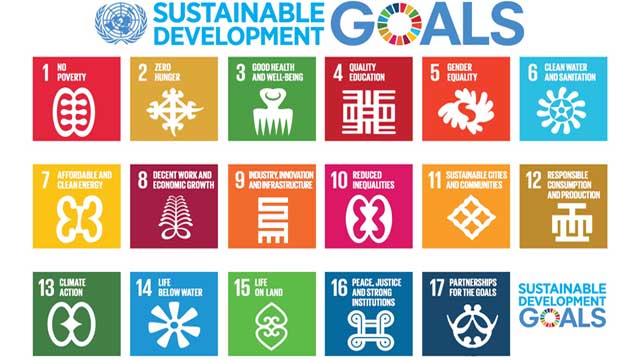
-
 Patrique deGraft-Yankson
Patrique deGraft-YanksonWe may be right to assume that the level of awareness just at a little over four years of its implementation should not be too alarming. However, analyzing such low level of SDGs awareness among a people a country whose president is a Co-Chair of the Eminent Group of Sustainable Development Goals Advocates in Africa leaves some cause to worry.
The good news however is that, not being directly aware of the SDGs in the way they have been blueprinted does not mean the people are insensitive to its calls and claims. The fact is that, most of the demands of the SDGs are already embedded in the culture and belief systems of the people, and I consider this as an important resource to deploy for awareness creation and enthusiastic implementation of the SDGs.
For the realization of UNs commitment to leave no one behind in the mobilization of the citizens of the world to achieve the 2030 agenda (UN, 2020) therefore, I am of the belief that efforts at linking the relevance of the 17 goals to cultural manifestations of the people should be highly considered. The image shown above is a demonstration of how various traditional symbols speaks to the SDGs in a language which is understood by the traditional Ghanaian. These symbols transcend language barriers and their meanings are inherent within their traditional belief systems, making the goals both physically and spiritually relevant to people.
The meanings of the symbols are as follows:
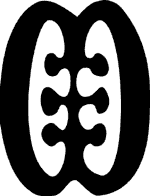
Ese Ne Tekrema (The teeth and the tongue)
Symbol of generosity towards one another. Through the formation of a linear relationship in diversity towards a common goal, both the personal and societal needs of the people will be realized.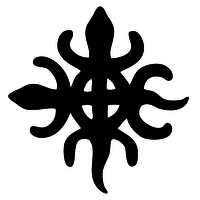
Funtumfunafu Denkyemfunafu (Siamese/conjoined crocodiles)
Symbol of brotherly feeling, caring and sharing. The society stays stronger when people coexist in the belief that we all smile and grow together when we feed and enjoy the good things in life together.
Dua Afe (Wooden comb)
Symbol of sanitation, cleanliness and beauty. This symbol reechoes the essence of physical and spiritual wellbeing through personal and environmental cleanliness.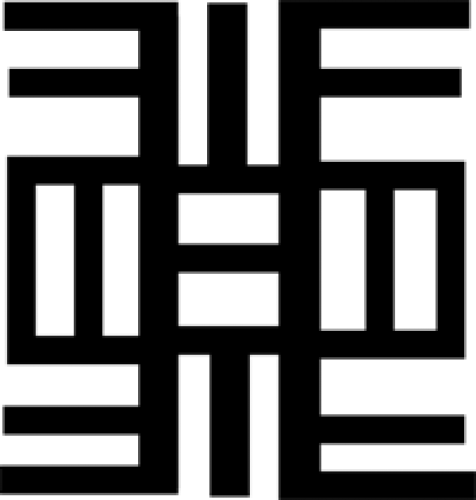
Nea Onnim No Sua a, Ohu (Anyone who does not know is capable of ‘knowing’ through education)
Symbol of educational opportunities. This symbol plays down ignorance by reminding people of their inert capabilities to get educated to any level of their preference. In other words, opportunities for quality education exist for all.
Obi Nka Bi (No one bites the other)
Symbol of equal regard, recognition and treatment for all. No one bites the other as a value ensures that all genders and age groupings have equal rights for existence in the society which allow them to listen and be listened.
Sesa Wo Suban (Change your life)
Symbol of deterrence and admonition towards all unapproved societal behaviors that affect the natural environment. This symbol represents strong advocacy for transformation and dynamic life patterns that affect nature. One of the unacceptable life patterns this symbol is currently addressing is the Ghanaian youth’s preference for wealth through illegal mining which destroys precious water bodies
Pempasie (Sew in readiness)
Symbol of production and sustainability. This symbol emphasizes the importance of societal preparedness and readiness for the future through effective production and management of all resources for posterity.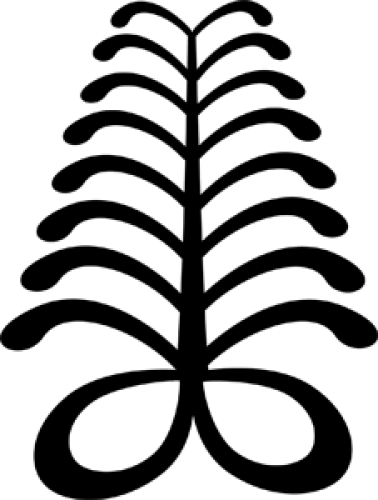
Aya (Fern)
Symbol of resourcefulness through resilience, self-reliance, hard work and judicious engagement of the environment and its resources.

Nkyimkyim (Twisting)
Symbol of collective action towards the building of the human society through initiative, dynamism, versatility, innovation and resilience. Indeed, building a successful society, like life itself, is not a smooth journey. The journey of life is tortuous and it requires a great amount of innovation and creativity to sail through.
Nkonsonkonson (Chain)
A symbol of unity. This symbol, depicting two links in a chain, advocates for the need to heal the componentized society since in unity lies strength.
Eban (Fence)
A symbol of love, safety and security. The fence symbolically secures and protects the family from unhealthy activities outside of it.
Hwehwe Mu Dua (Measuring stick)
Symbol of examination and Self/Quality Control. This symbol emphasizes the need for circumspection in all human endeavors. It directs attention to self and quality control in everything including production and consumption. It admonishes against over consumption, over production and all forms of egoistic instincts and behaviors which adversely affect the general good of the society.

Nyame Biribi Wo Soro (God resides in the heavens)
Symbol of reverence to the heavens, the abode of the Supreme Being. Recognition to the ‘heavens’, or the skies as the residence of the supreme being is tied to the belief that all good things come from the heavens – rains, sunshine, fresh air, etc. The ‘heavens’ need to be respected for continuous flow of life-given goodies.
Ananse Ntentan (Spider’s Web)
Symbol of knowledge and wisdom about the complexities of life. This symbol alludes to the intricate personality of Ananse, the spider, a well-known character in Ghanaian/African folktales. In Ananse’s world, all facets of life need to be somehow manipulated, positively or negatively, for good or bad reasons. This sometimes led him to dire situation. Ananse therefore is a character for admonitions and reprimanding. Being conscious about the character of Ananse guides your steps against any unfair treatment to the world around you, be it the skies, on the land, in the waters or below the waters.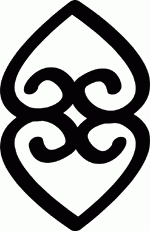
Asase Ye Duru (The Earth/Land is heavy)
Symbol for reverence and recognition to the providence and the divinity of the ‘Earth/Land’ and everything associated with it. The ‘Earth’ is the mother to everything. It carries the entire humanity, trees, water bodies, the sea (and what is in it and beneath it), big and small animals, etc. This why it is described as ‘heavy’. Respect/reverence to the Land is respect/reverence to life.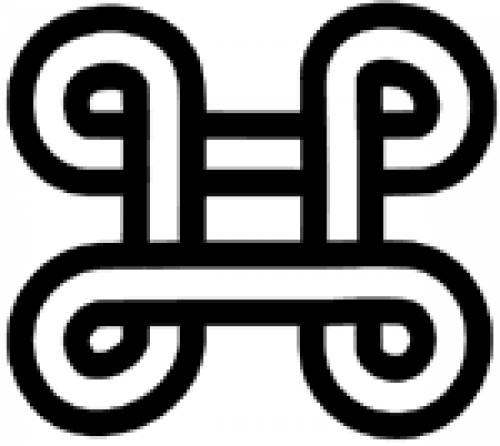
Mpatapo (Knot of Pacification/Reconciliation)
Symbol of bonding and adjudicatory factor which brings back parties in a dispute to a peaceful, harmonious and reconciliatory coexistence to ensure unified and strong societies and institutions.
Ti Koro Nko Agyina (One Head does not forma Council)
Symbol for partnership, collaboration and teamwork. This symbol emphasizes the importance of cooperation and collective efforts in the realization of all goals. Obviously, the attainment of the SDGs is a collective responsibility. No one nation (one head) can make it happen. It takes the concerted efforts of the entire citizenship of the world.Bibliography
- Adinkra Brand, A. (2020, November 15). African adinkra symbols and meanings. Retrieved from Adinkra Brand: https://www.adinkrabrand.com/blog/african-adinkra-symbols-and-meanings/
- Kasahorow Adinkra Library, K. A. (2020, November 15). Adinkra symbols and meanings. Retrieved from Kasahorow Adinkra Library: https://www.adinkrasymbols.org/symbols/nkyinkyim/
- United Nations, U. (2020, December 7). Sustainable Development. Retrieved from Uited Nations: https://www.un.org/sustainabledevelopment/development-agenda-retired/
published January 2021
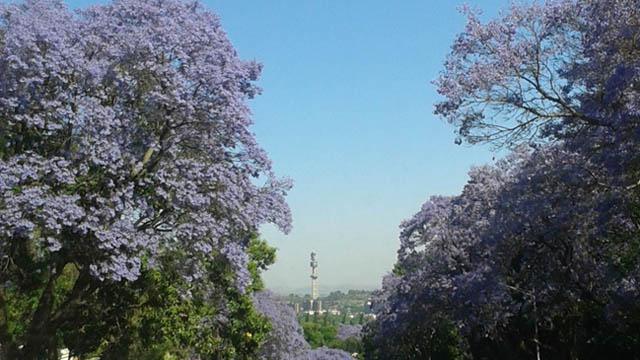
-
 Esther Kibuka-Sebitosi
Esther Kibuka-SebitosiThe image shows the deciduous large Jacaranda tree that grows up to 20-30 m high. The leaves are bipinnate produced in conspicuous large panicles, each flower with a five-lobed purple corolla. The fruit is oval flattened capsule containing numerous seeds. The Jacaranda in Pretoria flowers between September to November with purple flowers that paint the whole City purple. For this reason, Pretoria is called the Jacaranda city.
Known for its alluring lilac blossoms, the Jacaranda tree (Jacaranda mimosifolia) is native to South America and was introduced for decorative purposes way back in the 1800s to South Africa. In Pretoria, the Jacaranda was first introduced in Arcadia in 1888. Its beautiful flowers are characteristic of the springtime in Pretoria, City of Tshwane, Gauteng Province, where it fascinates the residents by putting a light purple carpet all over the roads.
Although the purple flowers remind the University students of the exams that take place around that time of the year, the elegant beauty of the Jacaranda flowers calms down the souls of many residents. Legend has it that when a flower from the Jacaranda tree drops on top of your head, you would pass all of your exams. Therefore, students wish for on eof the soft blossoms to drop one of its tubular flowers on their heads as they pass under this magical tree. The seeds, on the other hand, are enclosed in a brown, oval and flat capsule, which bursts open when dry, releasing flat winged seeds. They disseminate via wind dispersal to the savannah, woodlands, rocky ridges, riverbanks and all sorts of habitats.
To the conservationists, this deciduous beauty is an invasive species. Its origin is reported to be South America, particularly Argentina and /or Brazil because of the name’s Guarani origin in Argentina. The tree is regarded as an invasive species in South Africa and Australia. In South Africa, it is labelled as preventing growth of native species. However, in other parts of Africa such as Zambia, Zimbabwe and Kenya, the species is also present without being considered invasive yet.
In Pretoria, City of Tshwane, Gauteng province, the Jacaranda trees are enormous and line the pavement of the streets and inhabit roadsides, as evident in the images above. When they flower, they paint the whole City purple and it is spectacular to witness. The images portray the beauty and elegance of the tree that perhaps is draining the native ecosystem, which not to many are aware of.
Jacaranda blossoms are stunningly beautiful, but hidden underneath is the contradiction of the tree being an alien species that prevents indigenous trees from growing. Indeed, not “all that glitters is gold”. For this reason, the Jacaranda tree is no longer allowed to be planted in Pretoria.
Water scarcity is the most alarming problem of the twentieth century next to climate change in conservation. The sustainable Development Goal (SDG) 15 aims to protect, restore and promote sustainable use of terrestrial ecosystems, sustainably manage forests, combat desertification, and halt and reverse land degradation and halt biodiversity loss. In the meantime, SDG goal 11 promotes sustainable cities and communities. The dilemma of keeping the City green with trees and balancing the water ecosystems with the proper tree planting is a challenge that must be tackled through a multi-inter and trans-disciplinary approach to sustainable development. The Jacaranda tree is an example of this contradiction.
Apart from being beautiful ornamental trees, the Jacarandas' wood is used for furniture and other crafts. Meanwhile, programmes to address the social economic problems in communities were linked to alien species like the Jacaranda. These programmes aim at the sustainable management of natural resources through the control and management of alien invasive plants, by removing the species and thereby bringing employment to the youth, as part of the expanded Public Works Programme. The objective is to reduce the impact of invasive alien trees on water resources.
All over the world, trees and plants are introduced for various purposes. These trees contribute to multiple services for instance fodder, timber, medicines, fruits, shade and ornaments. Now as resources become scarce - especially water -, conflicts are beginning to emerge. Benefits and costs of these species are weighed against the endurance of the people and impact on the environment. Many strategies involve physical removal of alien vegetation. The benefit-cost analyses conducted so far have shown that the investment in clearing invasive species cost for example R116 in riparian areas, which equals about 6,40 US-Dollars (Marais and Wannenburgh (20008). However, it is important to remember that clearance seldomly results in total elimination.
References
- Jacaranda Jacaranda mimosifolia, retrieved from http://www.invasives.org.za/legislation/item/265-jacarandajacaranda-mimosifolia
- Marais, C and Wannenburgh, A.M. (20008) Restoration of water resources (natural capital) through the clearing of invasive alien plants from riparian areas in South Africa — Costs and water benefits.
- South African Journal of Botany 74 (2008) 526–537
- https://www.news24.com/Archives/Witness/Theyre-beautiful-but-jacarandas-can-do-harm-warns-expert-20150430
- Bolsmann, E. (1997). Jacaranda – Pride of Pretoria. Pub Be My Guest Publishers, Pretoria pp. 40.
- Potgieter, M.J and A.Samie (2019). Ethnobotanical survey of invasive alien plant species used in the treatment of sexually transmitted infections in Waterberg District, South Africa, retrieved from: https://doi.org/10.1016/j.sajb.2019.01.012
published May 2020
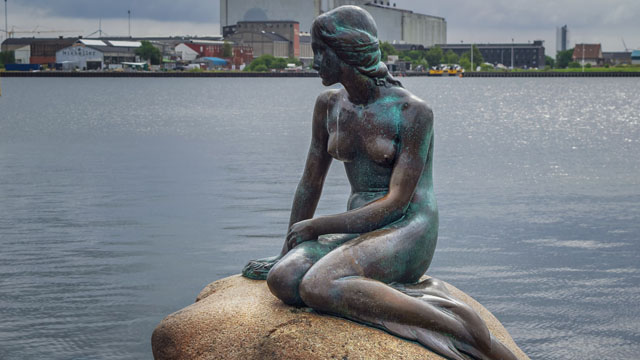
-
 Bea Lundt
Bea LundtA helplessly wretched female figure: The “Little Mermaid” in Copenhagen
Well known worldwide is the monument of the „Little Mermaid“ in Copenhagen. The figure is called a “national symbol” for Denmark and a “landmark” for Northern Europe. The bronze sculpture of 125 cm height was constructed by Edward Eriksen in 1913. It shows a naked young woman, her feet like the tail of a fish. The intention of the sculptor was to honour and remember Hans-Christian Andersen (1805-1875), the Danish author of the story „Den lille Havfrue“ (The little mermaid). The place which had been chosen for erecting the monument is a rock in the water near the open sea; the figure turns her face to the shore of the Danish capital Copenhagen.
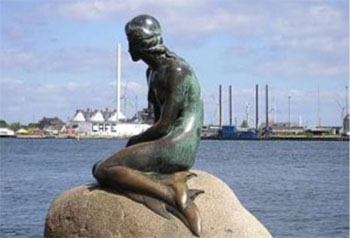
"Little mermaid" by Edward Eriksen 1913, 125 cm, Copenhagen harbour,
https://dreamguides.edreams.de/daenemark/kopenhagen/die-kleine-meerjungfrauWith this installation the country accentuates its identity of being involved in the element water and its representation in literature and culture. The famous piece of art transports different messages and reactions, has its own life and a specific history.
The narrative behind this figure, a fairy-tale for children, is well-known in Europe: A young mermaid wants to get into contact with a prince she loves. But he never recognizes her and marries a noble woman. The mermaid dissolves to foam, which flows back in the ocean. But also she is transformed to stay as a ghost in the air, where she can be part of earthly life and earn an immortal soul.
As a being of the nature the mermaid is part of the “other” of civilization and as subordinated to human and especially masculine beings. The title marks her to be “little”, not having a name and individuality. She did not receive any respect and interest, not even for her female beauty. By this ignorance she is killed, with no traces of her life. The story shows the most helplessly wretched female figure in literature we can imagine.
Within a memory-culture the monument might help a region of seafarers to feel superior over the sea and the beings involved with this element. Denmark was a colonial power. From overseas came goods and wealth on trading-ships. People from West Africa were deported as slaves to the Danish colonies Carribean Islands, where they had to grow sugarcane. The Molasses, the essence of this plant, was brought to Northern Europe, where Rum was made from it, the central product which made towns very prosperous. In visualizing a sentimental mythical story from the period Biedermeier the monument helps to divert from this context or even to suppress it. But the symbolic meaning might also be an accusation against (male) neglection of the nature and a warning for girls to hope to win the dream prince. It also can be seen as a protest against monarchy, aristocratic lifestyle and the glorified royal history of the country.
Performance and public reactions
Many tourists visit the monument every day and there are activities and actions around it. It stimulates the wish of giving the mermaid the attention she did not get in the story, as a symbolic compensation. There are also anonymous acts of aggression and destruction against the statue (see examples). Feminist groups protest against the offer of a voyeuristic view on a naked woman in this exposed location, this is also done by conservative circles in a prudish mentality. The statue also provoked campaigns of environmentalists who added her slogans demanding protection of other creatures being under control of human power like the whales for example.
An independent queen in Premodern Times: Melusine
The fairytale of Andersen is a modern adaptation of older stories and there are lots of distinctions within the development of this symbolic figure. Very common throughout several European languages is a narration about a female figure with the name Melusine, which is derived from the french word “mere” (mother) of the Lusignans, an influencial family, living in France and in Cyprus, from where the legend might have reached Africa. In the shape of a woman she marries a nobleman and rules over the country, building it up in an innovative way. When her husband discovers her in the bathroom being half a dragon, she flies away. In the official belief she is said to be a dangerous demon with no soul, destroying Christian families. But in aristocratic traditions the mermaid is understood as the ancestress of their gender and put in their heraldry. In illustrations in books she is depicted as a courtly lady with half the body of a fish, standing in a basin; the destructive element of water being abolished. She is not a victim, but the active part in the plot; when she leaves, her big family suffers and the country loses its strong ruler with her outstanding creativity.
The twofold character of Melusine represents very well the beginnings of noble families: Polygamic life was common, and when the institution of the Christian marriage was imposed, one of the spouses of a ruler needed to be sent away. The element water might hint at the origin of the mistress from a village near the river outside the castle, which is on top of a hill. In popular narrations she was given an aura of mystery, having the body of a dangerous monster.
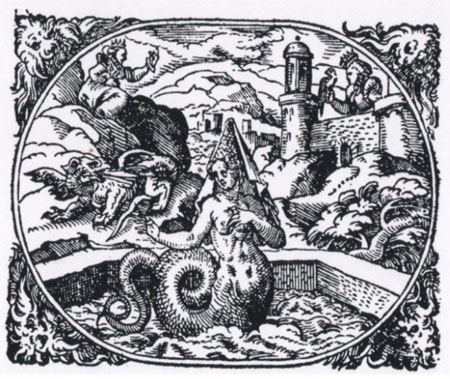
Melusine. The mermaid as a court lady and the ancestress of noble families (woodcut and illustration of a manuscript 15th century), Thüring von Ringoltingen: “Melusine”. In der Fassung des Buchs der Liebe (1587), hg. Hans-Gert Roloff, Reclam Verlag Stuttgart1991, S. 3.
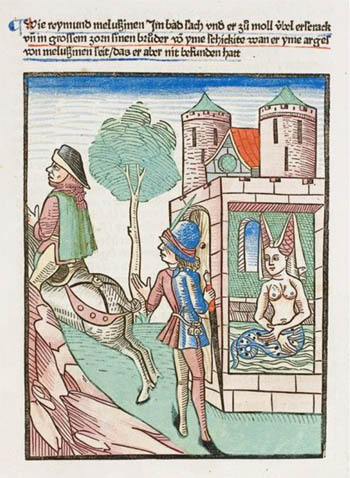
She is discovered having half a fish-body (book illustration 15th century), Thüring von Ringoltingen: „Melusine“ First printing Basel: Richel, around 1473/74. digit. ULB Darmstadt urn:nbn:de:tuda-tudigit-35087
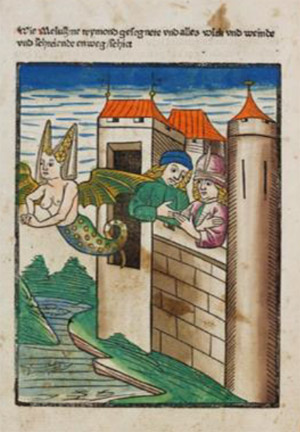
She flies away (book illustration), from "der Seelen Wurzgarten“. St. Peter pap. 23, Coburg bei Schwäbisch Hall 1467 (digitized by the ‘Badische Landesbibliothek Karlsruhe’, 65v.)
The modern tale of a beauty killing her lover: Undine
With the name “Undine” (lat. “unda”: wave) in Romanticism the mermaid-figure develops vampiric qualities, killing her lover by a kiss when he marries another woman.
This motif inspired many paintings. They channel phantasies and visions about the chances and problems of a partnership between persons from different origin and about death as the consequence of an unsuccessful encounter. How can strange-looking persons, which come from or over the sea, be integrated?
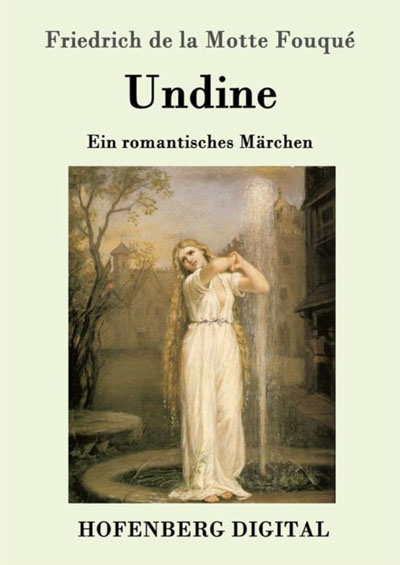
Friedrich de la Motte Fouqué (1777 – 1843), novel, 1814, published by Karl-Maria Guth. Berlin 2015, Painting by John William Waterhouse 1872.
Conclusion
Premodern times reflect the mermaid mainly as bringing fertility from nature to mankind, hoping to gain a soul through marriage with a human being. There are systematic changes to this story during modernity, which might result from the background of colonialism as absorption and subjugation of everything different and “strange”. Men are longing for its attractiviness, but also fearing that this inclusion of a natural being might cause protest and fury. The European tradition can be said to be a parable about migration and exchange between different worlds, the mermaid being a symbol-figure for the futile attempt of colonizing the other.
The task of a transcultural comparison: Mami Wata
In Ghana I learned about Mami Wata, a traditional African figure, the patron of fishermen. In Quidah (Benin) I saw her as a goddess of the python, the holy snake. She has her own shrine where specifically educated priests pay tribute to her to keep her merciful. The name is interpreted to be a pidgin-version of „Mother of the water“. Scholars from Europe assumed that Melusine was carried on ships' bows in the 15. century from Europe to the West-African coast, where her narrative interlaced with local narrations with their own long tradition of water-goddesses. But: It might also be the other way round, from West-Africa to Europe, probably on the trade-roads through the Sahara. There, the legend emerged much earlier and arrived in Europe as early as the 12th century, when the mermaid-stories began to gain popularity. How is a figure transformed when it is transferred to a region with such different history and traditions?
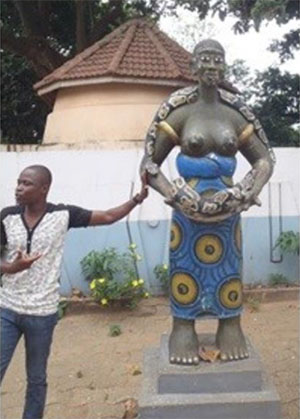
Temple of the Python, “Holy Forest”, Quidah (Benin) 2015 Foto: Nina Paarmann
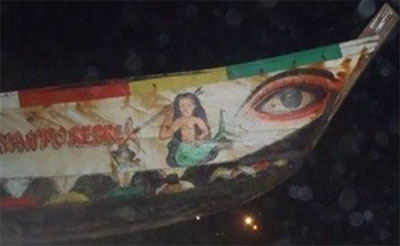
Fishing boat in Winneba (Ghana) 2012, Foto: Nina Paarmann
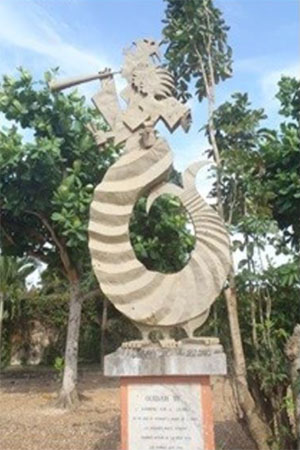
Quidah (Benin) 2015: “Slave Road”, Text: “memorial for the ‘tree of forgetting’ which had to be orbited, nine times by the male and seven times by the female slaves”, Foto: Nina Paarmann
References
- Hans-Christian Andersen: „Den lille havfrue“ (The little Mermaid) fairytale, in: Sämtliche Märchen 1-2, München 1974 (hg. Nielsen, E.).
- Bea Lundt: Melusine und Merlin im Mittelalter. Modelle und Entwürfe weiblicher Existenz im Beziehungsdiskurs der Geschlechter. Ein Beitrag zur Historischen Erzählforschung. (Diss. 1990), Fink-Verlag München 1991.
- Bea Lundt: Wassergeister als universales Motiv. Paracelsus’ Deutung der Nymphengestalt und die Figur Mami Wata in Afrika. In: Nova Acta Paracelsica. Beiträge zur Paracelsus-Forschung (NF 28). Hg. Pia Holenstein Weidmann. Bern u.a. 2018, S. 9-40
Edited by Kelly Thompson.
published February 2020
 Esther Kibuka-Sebitosi
Esther Kibuka-SebitosiMermaids at the East African coast
The Mermaid in Copenhagen reminded me of the stories I heard when I visited the coastal town of Mombasa, East African coast in Kenya. This was back in the University days when I accompanied my friend Salome to visit her mother in Mombasa. We travelled by bus all the way from Kampala through Nairobi to Mombasa, a long journey of over 24 hrs. We landed at “Mwembe Tayari” Kiswahili translation “ripe mangoes”- this market is a vibrant place with all sorts of mangoes to eat. It was a market of all diverse cultures: Arabic, Swahili, Bantu and the main language was Kiswahili- a mixture of Arabic and Local Bantu languages. The myths, stories and folklore are all mixed taking origins from Arabic and African descent.
Back to the Mermaid stories, once upon a time, a man went to have a drink at one of the Mombasa bars. He drank and went home with a woman. Before they slept, the mermaid wangled her fins to switch off the lights. He ran out of the house and told the whole town up to Malindi, a faraway town.
Mermaids are both a mystery and envy because they are told to be very beautiful women who come, seduce men, and then disappear in the night. Another story was that the mermaids were “Genie” or ghosts, which are really demons of the sea. When my Pastor friend, the late Lule went to preach the gospel in Mombasa, he had to cast out many. He told me that one night he slept only to be woken up a mermaid to command him to go and leave town. He just prayed in the name of Jesus and she left without a trace in a closed door. He said, when you see one, you need to do some spiritual warfare; use the Name of Jesus and the Blood of Jesus as weapons of mass destruction.
Stories of mermaids are varied but when told by a Swahili woman; you need to sleep over, as they never end. You need to have some “mandazi” (sweet like a doughnut) and African Tea with Masala (spices) as you listen to these rich African tales. Will keep you posted when I visit again.
References
- http://blog.swaliafrica.com/mami-wata-the-mermaids-in-african-mythology/2/
- Dona Fish, Angola, ca. 1950
published February 2020
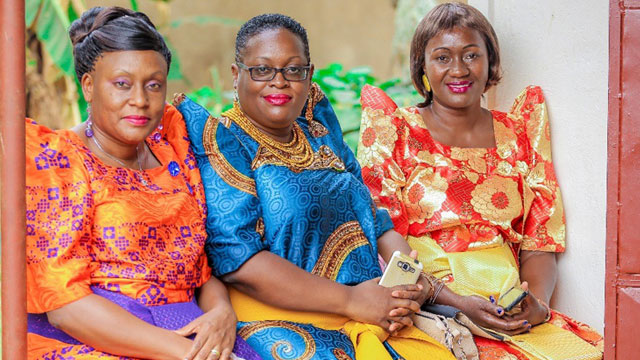
-
 Esther Kibuka-Sebitosi
Esther Kibuka-Sebitosi“Decolonizing self” is a photo demonstrating the complexity of cultures and how inter twinned African and western cultures have become. The photo was taken at a traditional wedding in Kanyanya village, where African cultural practices like sitting down on the mat are proudly demonstrated. Paradoxically, decolonizing the self-starting with the dress, is not an easy process as pieces of the western culture are clearly visible, for example the sunglasses, the necklace and ear rings all show the interlinkages between cultures. The example is excellent in showing culture, history and evolution of the traditional dress and political economy for educators. The mood of the gaze is best described by former President Thabo Mbeki in his poem,” I am an African” as he proudly says, “ “Today I feel good to be an African”.
In unravelling decolonizing self, I want to start with explaining colonialism; Torres (2007) refers to colonialism as, “ a political and economic relation in which the sovereignty of a nation or people rests on the power of another nation”. He refers to coloniality as a long-standing patterns of power that emerged as a result of colonialism but that define “culture, labour, intersubjective relations and knowledge production well beyond the duration of colonial administration”. Hence, coloniality, he argues, survives colonialism and is maintained through books, music, academic performance, cultural patterns, in self-image and aspirations of self and is lived every day. It follows therefore that decolonizing self would have aspects of culture, language and daily practices that one has to get rid of. Taking an example of cultural dress, I dress in my traditional dress called the busuti or Gomesi. The image shows the dress and the Shaath (cream colour that is used to tie it). The necklace is modern shining with stones. The accessories are also western. I am sitting down on a mat made out of sisal and “nsansa- palm tree leaves. Sitting down is a cultural tradition and practice that dates back for generations. This is also a gender demonstration of roles of women who would sit on the mat to greet visitors who had come to be introduced. The practice of paying lobola (bride price) is common in Southern Africa and traverses the African continent. In the photograph, everybody dresses in the traditional dresses. It is a way of saying “I am an African” and I dress like this, “Look how smart my dress is lovely”.
Ironically, long ago, the traditional dress was made of out of the Mutuba tree- Fig tree Ficus species. They got it from the bark of the tree, which they smashed until it became flat. It was dried and then rolled out. The cloth (Kikunta or Lubugo) comprised only of a sheet, which was wrapped around, the shoulders. Over the years, the Kikoyi replaced the kikunta as it was made out of cloth- cotton. Linked to the traditional dress, is the decorative materials from India. Inside the dress is another wraparound Kikoyi that together with decorations were also from India. The image shows the material of the dress- silk with beads. This material is from India or Dubai. The modern materials are no longer traditional (Kikunta and kikoyi). The local industry has adapted to make traditional dresses out of new materials linen, nylon, chiffon or a mixture instead of cotton or Lubugo from the Mutuba tree back.
The image also demonstrates the mostly western sunglasses or gaggles. The sunglasses show the western culture I have adopted over the years. The Europeans normally put on sunglasses to protect their eyes from the sun. The occasion was held during the day as the sun was shining. It is not traditional practice to wear sunglasses. However, they help protect the shy people, as they do not have to look at all the guests. The gaze in the image is that of a woman comfortable in her body, sitting down with pride and taking pride in her tradition. This particular image was selected because it reveals the culture in transition. It is contemporary culture- a traditional wedding- a place where African Culture is luxuriously displayed. Paradoxically, the dress is traditional but the accessories are western showing the entangled nature of coloniality- the tradition African culture and the western culture, practices, all intertwined in intercultural interactions. The sunglasses may also demonstrate the cover up- hiding of self in the modern practices. Based on the above, it is not surprising that Decolonization is a layered process, which takes time and patience.
Thabo Mbeki wrote a poem, “I am an African” expresses the objective of the constitution, “It is a firm assertion made by ourselves that South Africa belongs to all who live in it, Black and White”.
As I sit on the mat and watch the bride and groom give gifts to each other, I remember the words of the former President of South Africa, “Today I feel good to be an African”.
In decolonizing self, “decolonization” that has become the rallying cry for those trying to undo the racist legacies of the past, according to Achille Mbembe. Starting with cultural dressing is the first form of decolonizing self. Other forms include decolonizing power and decolonizing knowledge.
published January 2020
 Katharina Knaus
Katharina KnausBeyoncé’s and Jay-Z´s Video „Apeshit“ discusses post-colonial exhibition art
My first contact with art history was by reading E.H.Gombrich „The Story of art.“ (1909-2001). When starting my studies of art history in Munich, this was the book they recommended as standard literature. The cover text describes it as „the most famous and popular book on art ever published“. Although it claimes to be an introduction in art „for reader of all ages and backgrounds“ Gombrich tells a very one-sided story. Beyoncé’s and Jay-Z´s Video „Apeshit“ discusses post-colonial art historiography by exposing the Louvre as a white – dominated space.
„Two black women are sitting on the floor wearing light brown tights and body-hugging beige vests. They are in profile, facing away from each other, and positioned at either side of David’s painting of the famous 19th Century French socialite. Linking the two women together is a flowing piece of white material, each end of which they wear on their heads like a turban.
Above them, Madame Récamier reclines on her antique sofa, dressed in a simple sleeveless white dress, her head turned towards the viewer. The design of the sofa is similar to that of a sleigh-bed, with rising wooden ends. It is these bed ends that the women on the floor echo, the variance in the darkness of their skin matching the different tones of the wood in the painting.
The cloth that links them represents the dress worn by the painting’s subject. The message is clear: It was on the backs of subjugated black people from the French colonies that Madame Récamier was able to enjoy her life of leisure and pleasure.“ (Will Gompertz)
The Carters’ Louvre takeover isn’t just about protest; it is about power too. But the overall point is powerfully put. The game is up for those institutions – be it Hollywood, Broadway or the Louvre – which have ignored black artists, refused them a voice, or a seat at the top table.
published January 2020
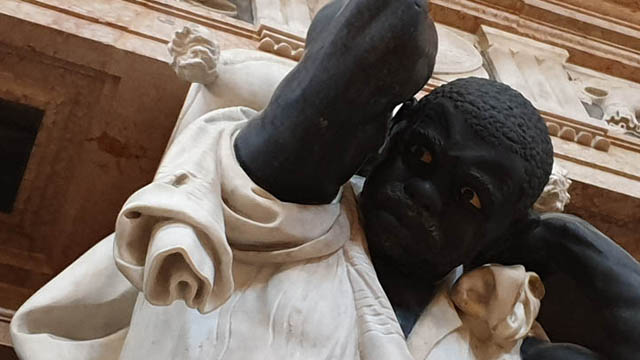
-
 Leonie Chima Emeka
Leonie Chima EmekaFour figures of captured Africans in black and white marble support a massive triumphal arch on their shoulders. On white marble cushions rests the heavy construction with a sculpture of the doge Giovanni Pesaro in its center. flanked by four virtues — Fides, Fortitudo, Caritas and Justitia — the effigy states justice, faith and militant power as the virtues of the Venetian Republic under the reign of Giovanni Pesaro.1 With striking vividness the tomb seems to propagate the subjection of the black body in favour of the Venetian civilisation.
The literally black skin of the slaves, their round faces, full lips and swallowing round eyes encourage the assumption that what we see here is a typed representation of the so called ‘Sub-Saharan African’. Our perception today is materially influenced by the knowledge of images of Blackamoors in American and European popular culture, as well as the concrete exploitation of the black body during colonialism and slavery. The experience of Venetians in the 17th century, however, was considerably different to our postcolonial and post-slavery perception today. What nowadays generates emotions of horror and contempt, was meant to advertise a short reign that lasted merely one year from 1658 until the doge's death in 1659.2 The tomb was built in 1669, ten years after Giovanni Pesaro’s demise, according to the design of the famous Venetian architect Baldessari Longhena (1598-1682).3
The figures of the black slaves are by most accounts ascribed to the German sculptor Melchior Barthel (1625-1672) and relate, not to Africans captured in the transatlantic slave trade, but to the people enslaved in the war against the Ottoman Empire in defence to the island of Candia (today Crete) which was partly lead under Pesaro’s command.4 The weapons and armour which adorn the entablature suggest that the tomb in the shape of a triumphant arch refers to a victorious war. The iconography of victory, however, is a vast exaggeration of the truth, as Pesaro had not been considered successful in his defence of Candia and “ironically the island fell in the hands [… of the Ottoman; note from the author] in 1669, as the monument was completed”.5 Other than the slave’s de-humanising features might suggest the monument does not legitimise systematic exploitation of the black body equally to blackamoor iconography. Although the transatlantic slave trade had already started when the Pesaro tomb was completed, many more Europeans suffered enslavement in North Africa than has previously been commonly acknowledged.6 Venetian enslavement was such a common experience, that “both Ottomans and Venetians counted their imperial rivalry partially in terms of slaves taken and returned”.7
In 1669 Great Britain, which later became the most investigated in the transatlantic slave trade, lost more people to Ottoman enslavement than the other way around. The military strength of the Ottoman Empire rather suggests that the compositional subjection of the black marble slaves are meant to refer, or even constitute, a military strength that was strongly challenged in Pesaro’s lifetime. Unlike the blackamoor iconography, the grave is not to be understood as a visual manifestation of the transatlantic slave trade and colonialism, but postulates a militaristic superiority that was in fact strongly challenged.
Although the black marble slaves in Venice precede blackamoor imagery and its historical context, one cannot disconnect our perception from the traumatic history that would follow. It is hard to overlook the de-humanising effect of the eternally oppressed African sculptures and not to remember the disturbing past of systematic enslavement and its visual representation in de-humanising blackamoor imagery. Even if compared to another massive monumental sculpture featuring Africans as captives the black marble slaves remain singular in their artistic strategy of de-humanisation of the black body.
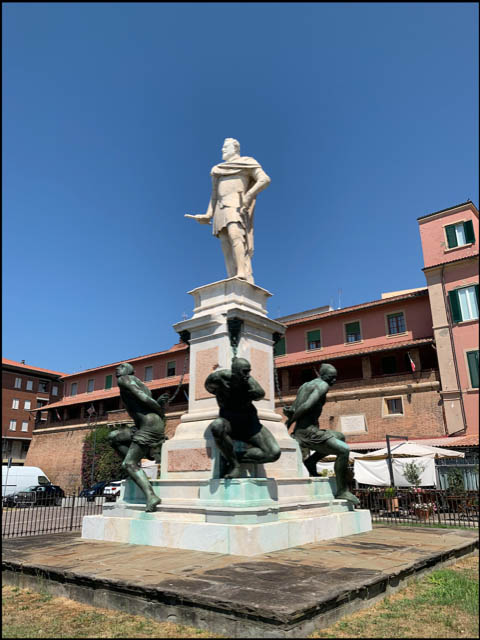
© Leonie Chima Emeka
Giovanni Bandini, Grand Duke Ferdinando I de' Medici 1597-99,
marble, and Pietro Tacca, I quattro Mori, 1621-26, bronze, height 33 ft. 3 in. (10.14 m)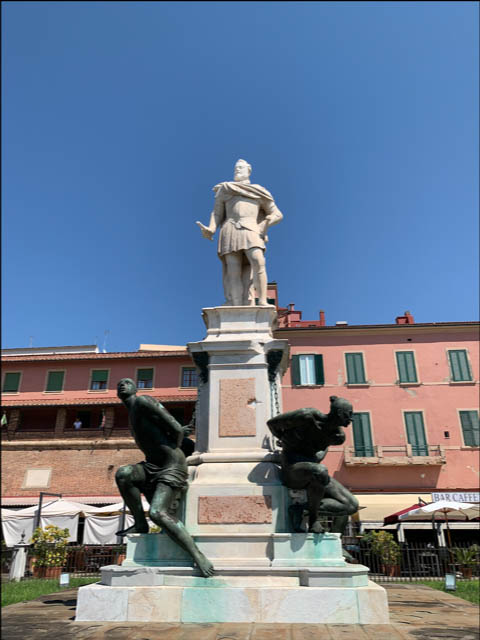
© Leonie Chima Emeka
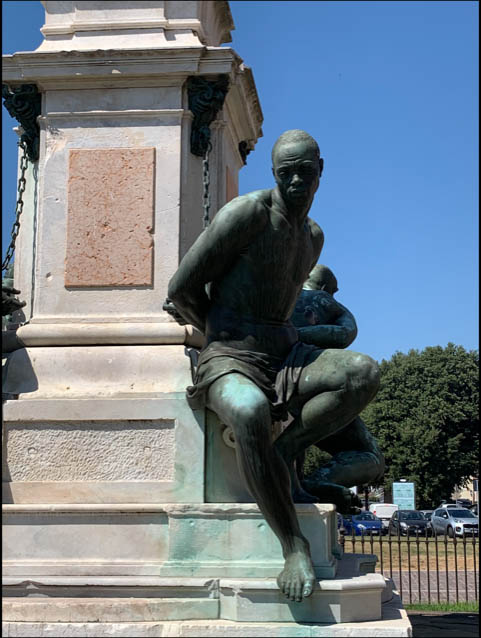
© Leonie Chima Emeka
Pietro Tacca, I quattro Mori, 1621-1626, Piazza Micheli, Livorno
The Monument to Grand Duke Ferdinando I de' Medici in Livorno, Tuscany, is considered the first public monument in early modern Italy to depict enslavement of the black body as a violent act and might have served as a model for the black marble slaves in Venice.8 The four bronze figures were manufactured in 1626, only 33 years before the Venetian sculptures, by Pietro Tacca. The four Livorno slaves are in fact a later addition to the monument of the likeness of Ferdinando I. Grand Duke of Tuscany.9 Tied to the pedestal they are meant to be understood under the control of Ferdinand I. It is the slaves’ strength and the explicitly forced subjection of these muscular bodies that indicate the elegant but lean Ferdinando I as a strong, assertive and powerful figure.
The four attributes of power completed in Pesaro’s youth, might have offered an alluring imagery for the later Doge, who had been highly criticised and actually taken to court for his military actions in defence of the Isle of Crete.10 Also the Venetian slaves represent physical strength as they support the massive tomb on their shoulders. The round eyes and big lips in the grimacing round faces which are contorted to an almost animal expression, however, mark the Pesaro slaves as hideous beings. The Venetian Slaves surpass their models in Livorno transcending the degree of de-humanisation to evoke the impression of the African slave as inferior. The slaves in Livorno, who wear a challenging or defeated expression, invite sympathetic emotions while the Venetian figures are deformed to almost caricatures. The status of dominance and subjugation is already apparent in the Venetian figures themselves. Not the presence of the chains, nor their mere position marks them as victims of subjection. It is rather indicated that the subjection is already incorporated in their hilarious features. In presence of the Pesaro slaves one cannot help but feel the uncomfortable impression, that it is the slaves themselves, their explicitly depicted inferiority, which legitimises their enslavement. Barthel’s artistic strategy of de-humanisation marks a shift in the representation of the black body in European imagery. If racism is defined as the naturalisation of the inferiority of the black body it concludes: the Monumento al Doge Giovanni Pesaro is a racist monument before systematic racism.
Footnotes
1 Identification of virtues: da Mosto, p.250.
2 Da Mosto, p.253f.
3 Da Mosto, p.251. Longhena’s plan can be found in the Zentralinstitute für Kunstgeschichte in Munich.
4 Ascription and life dates: Kaplan, p.186. Residency in Venice and Ascription: De Mosto, p.251.
Ascription to Ottomans and War of Candia: Da Mosto, p.238, p.249, p.253. Kaplan, p.186.
5 Kaplan, p.186. Although Kaplan and De Mosto name “Turks”, I chose the term Ottoman according to Lowe’s statement, that the term ‘Turks’ was often used to describe the whole Ottoman Empire. Da Mosto, p.253.
6 Davis, p.87ff.
7 Rothman, p.429
8 Rosen, p.38.
9 Construction of pedestal and sculpture: 1597 and 1599 by Giovanni Bandini ibid., p.38.
10 Da Mosto, p.254.
published July 2020
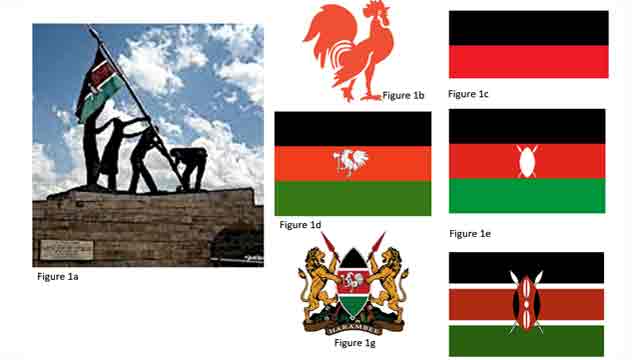
-
 Donna Pido
Donna PidoKenya’s Independence monument resides at Uhuru Gardens in Nairobi (Figure 1a), most likely because this is where received Independence (Kiarie 2022). Though only a few people visit Uhuru Gardens and get to see the monument, it reminds us of 12 December 1963, the day of Independence and when Kenya Army soldiers first raised the national flag on Mt Kenya. Mau-Mau and other guerilla soldiers see hoisting the flag as a visual symbol of military victory over King’s African Rifles and their British collaborators though some felt it is the same collaborators who inherited power from the British (Branch 2007). In this context, Independence is remembered as a military defeat of the British sense of military invincibility. However, a political class comprised of ‘under-educated’ intelligentsia saw Independence as an intellectual contest and a defeat of so-called colonial arrogance. Rural dwellers, on the other hand, seemed spectators with the view that Independence was coming ready with ‘owners’ (politicians, businessmen and educated elite). That Independence has owners who enjoy it while rural remain on the sideline is evident the persistent poverty thriving in rural Kenya (Njeru 2018). So, even Uhuru Gardens and the Independence Monument have ‘owners’ who are not rural dwellers; it is clear that the monument is the collective memory and visual culture of its ‘owners’.
It seems the majority of rural dwellers understood Independence according to what politicians said- wealth as the accumulation of money, health as getting treatment in hospitals, education as attending school and passing examinations (Kenya African National Union 1969). We are not sure they are able to read and understand the Independence monument at Uhuru Gardens. Why KANU did not install the rooster at Uhuru Gardens draws considerable curiosity. That is beyond our scope here. One with a thick African cultural knowledge could easily choose the image of a rooster instead of that of hoisting the national flag because KANU was a nation-wide party and the rooster has cultural meanings nationwide. Among the Luos of Western, establishing new homesteads entailed carrying an axe and rooster to the site of the first house; this ideology is well-represented in the KANU flag (figure 1d). In other parts of Kenya, the rooster is a symbol of manhood required to make many children (Wikipedia. 2022). By crowing early in the morning, the rooster does not simply announce time but also sets the work-eat-rest rhythm of life in rural areas.
Before discussing WWII monument and of pre-Independence flags, we want to briefly address meanings in choices of colors and other elements in party flags and the national flag. The black, red and green stripes in KAU, KANU and the national flag have the same meanings. The black stood for the indigenous population, red for the common blood of all humanity or blood shed during the struggle for Independence. Green symbolized the nation’s fertile land or landscape of the country, while the weapons were a reminder that organized struggle was the basis for future self-government (Smith 2001). No doubt the shield and spear are common traditional Kenya tools of offence and defense. It is said that white represented unity and peace. It is rather clear that a section of Kenya’s coat of arms is modeled on KANU’s flag- colors and the rooster carrying an axe. Meanings herein are similar to those we mentioned in our discussion on KANU’s flag; the shield and spears also bear the same meanings as we mentioned when discussing the national flag.
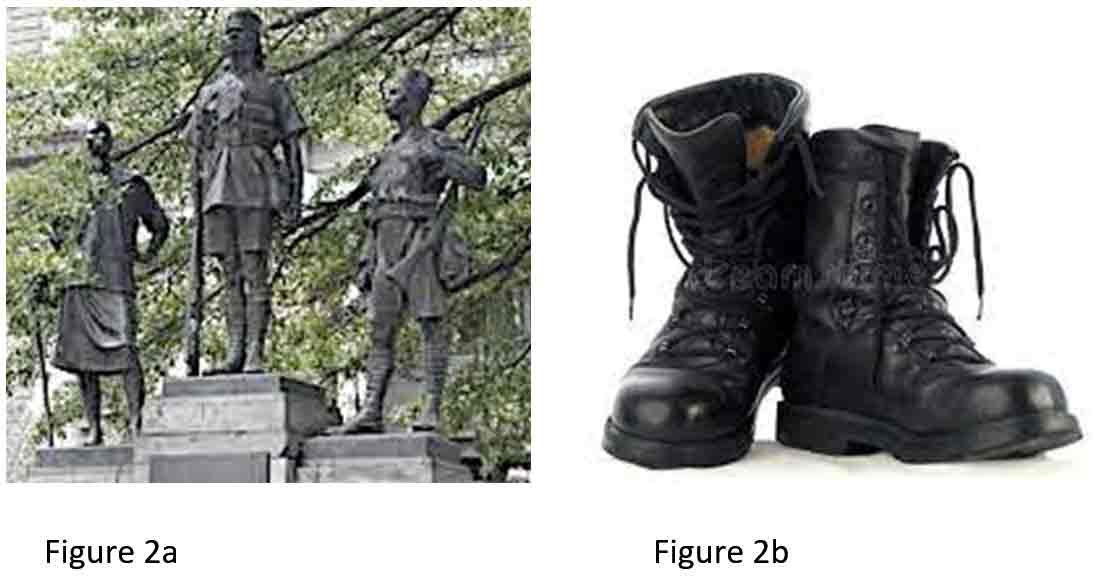
The combat boots (Figure 2b, Internet sources) tend to strike a note that is closer to the Acholi collective memory of WWII because they refer to it as too bin (Acholi for ‘come ye death’). Among the Acholis of Northern Uganda, the combat boots symbolize the massive death in the War and the sacrifice of people forced to be loyal to the King of England. There is quite a stark contrast between the intended collective memory and the actual one. At least among the Acholi, the boots are infinitely more meaningful that the bronze images so hapless servant/soldiers.
Many of us in Kenya may not be able to remember the pre-Independence flags presented here because they were in use a long time ago. Between Indonesians, Indians and Arabs, we are not sure on who first visited Kenya. However, Arabs came in greater numbers over a longer period, intermarried with the local population and eventually set a government with the Sultan of Oman as its emperor or king. We included the flag of the Sultan of Zanzibar (3a, Internet sources) as a part of the visual culture of Kenya. The flag does not fly anymore but Arab dhows and their sails are prominent visual feature at the coast of Kenya. History has it that the Portuguese followed and displaced the Arabs and built Fort Jesus- we included Portuguese flag (3b, Internet sources) of that time since we consider it a part of the visual culture of Kenya at that time. Apart from Fort Jesus in Mombasa and the Vasco da Gama monument in Malindi, there seems no outstanding visual feature that rigorously reminds us of the Portuguese.
We turn now to the World War II monument standing on Kenyatta Avenue, Nairobi (Figure 2a, Internet sources). Our action was driven by the thought that the monument is also a reminder of how Africans were roped into a war they did not start, meaning, they did not have any special interest in the war. While the British saw this monument as honoring the regional war dead, we remember our own who died in North Africa, Burma or elsewhere as WWII raged. In any case it would have served us Kenyans more meaningfully if the monument had represented Kings African Rifles in action instead of as the transport company that was its main function. The figures of this monument are just standing as if posing for a photograph.
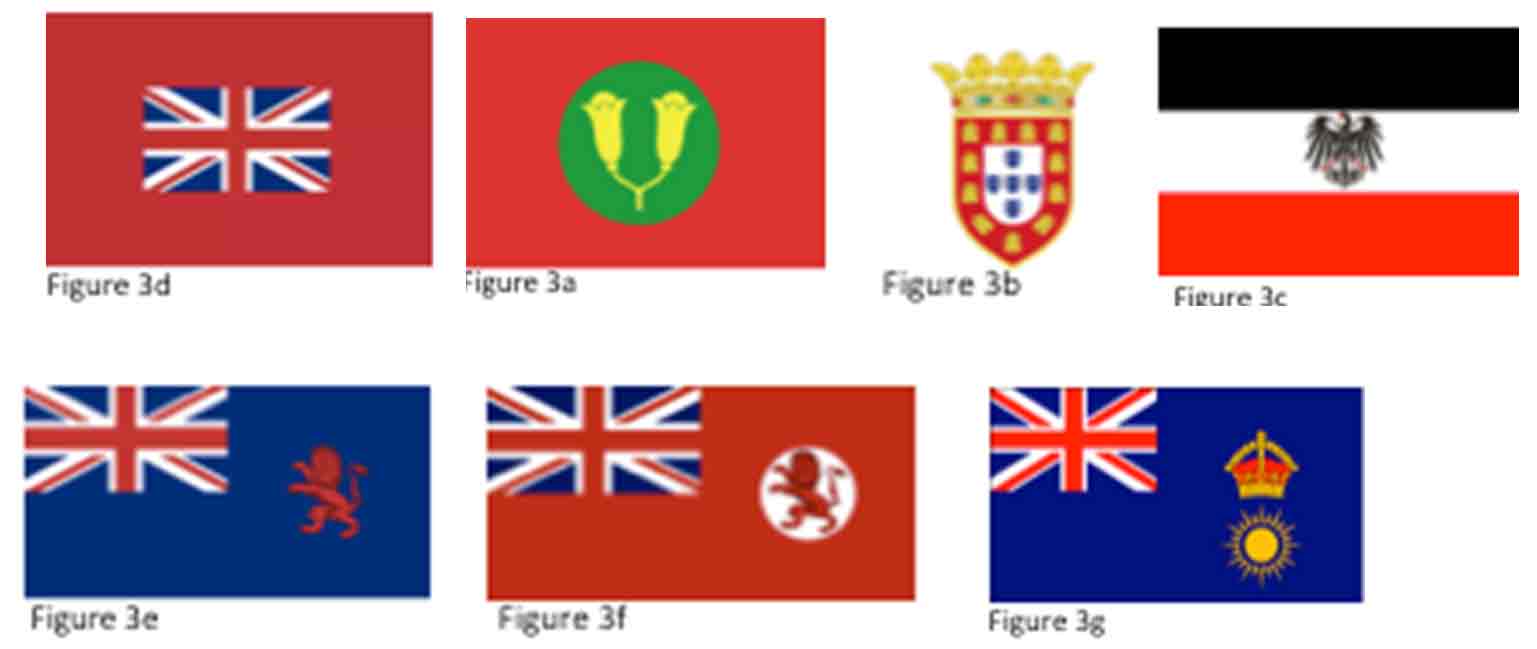
The eagerness related to the partitioning of Africa and the establishing of colonies saw the Germans come to Kenya and German East Africa (Tanganyika) where the German flag flew (Figure 3c). Heller, the German coin is the most outstanding collective memory of German East Africa; old folk still refers to coins as heller (hela, eeera, Figure 4a and 4b, Internet sources). Though rupee was more popular as an Indian coin, it was also used in German East Africa and its name was integrated into many languages that still use it to mean ‘money' (Figure 4c, Internet sources).
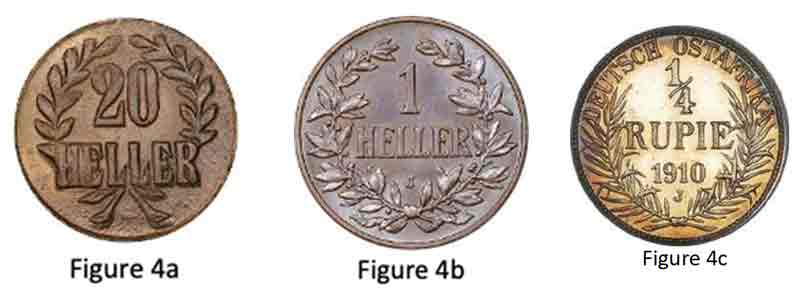
Some people think that if Germany had won World War I (WWI), East Africa would have been a German colony. But that was not to be; various parts of East Africa were under Brisstish rule until Independence in the early 1960s. The Witu flag (Figure 3d) was hoisted soon after the British drove Germans out of East Africa, this was followed by the British East Africa flag (Figure 3g, Internet sources) and flags (Figures 3e and 3f, Internet sources) were used in Kenya colony, specifically. The Union Jack was prominent in flags for British East and Africa and Kenya Colony. British influence is massive in Kenya and related visual culture is so massive that it deserves more attention that is possible here. Meanwhile we note that the structure of Kenya’s coat of arms is similar to emblems and related devices that were in use when Kenya was a colony.
Summary of Discussions
We embarked on writing this article hoping to add to on-going efforts in exploring collective memory in Africa. Our short article touched on political collective memory including but not limited to past and existing monuments, flags, coat of arms and emblems. It is difficult but possible to argue that pre-Independence devices form a part of Kenya’s visual culture; we argue thus for believe that the past makes today as the present makes tomorrow. Heller, the German coin of colonial Kenya, provides one example of how past visual culture persists through time to be a part of the present and does so with little cultural transformation.
In this article, monuments, flags, emblems, coats of arms and coins provided fodder for discussions. It seems the Independence monument is a Government object that only officers of Government and the intelligentsia communicate with and use it to remember Independence and WWI. Kenyans who paid the price of WWI and Independence have yet to enjoy whatever benefits may accrue from the two. The once very powerful KANU that received Independence from Great Britain is now a pale shadow of the political party it was. However, its rooster remains a visually powerful emblem that speaks of time, space, majestic manhood and connection with the universe.
We do not know why KANU’s rooster is dwarfed in the coat of arms and is absent in the national flag. The absence or minimizing of such a powerful symbol can raise questions. For example, is it a part of continued colonization that thrives on suffocating local expressions? Or was it a matter dictated by non-Kenyan concepts of design? These questions need addressing soon and with more concerted efforts.
References cited
- Branch Daniel 2007: The Enemy Within: Loyalists and the War Against Mau-Mau in Kenya, in Journal of African History, Volume 48, Issue 2, July 2007, Cambridge University Press
- Kenya African National Union 1969: The K.A.N.U Manifesto, University of Virginia
- Kiarie Maina 2022: http://www.enzimuseum.org/museums-of-kenya/monuments/uhuru-gardens
- Njeru Timothy Njagi 2018: What is Driving Persistent Poverty in Rural Kenya, in: The Conversation https://theconversation.com/whats-driving-persistent-poverty-in-rural-kenya-99765
- Smith Whitney 2001: https://www.britannica.com/contributor/Whitney-Smith/4445
- Wikipedia 2022 Cultural References to Chickens: https://en.wikipedia.org/wiki/Cultural_references_to_chickens
- Woods Steven Paul, Weinborn Michael, Ryan Yangi Li, Hodgson Erica, Amanda R.J. Ng, Bucks Romola S. 2015 Does Prospective Memory Influence Quality of Life in Community-Dwelling Older Adults? in: Neuropsychol Dev Cogn B Aging Neuropsychol Cogn https://www.ncbi.nlm.nih.gov/pmc/articles/PMC4537668/
For further reading: Lydia Waithira Muthuma. How Public are Public Statues? (Public statues in Nairobi)
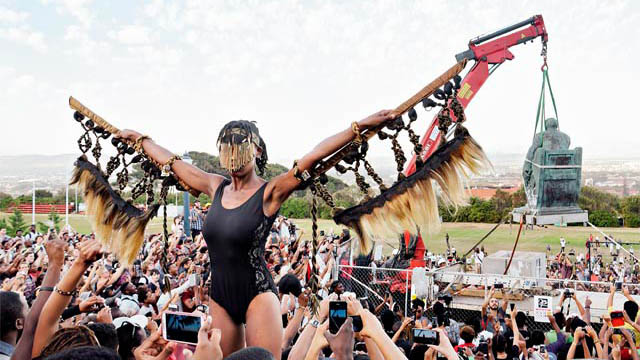
-
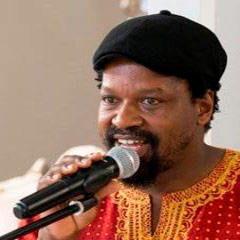 Bongani Mkhonza
Bongani MkhonzaIn this chapter, I trace the original source of the image that inspired the artwork by Sethembile Msezane titled, ‘Chapungu- The Day Rhodes Fell (2015). I envision that to get to the bottom of it, the etymology of the word ‘chapungu’ as used in the title of the artwork will have to be retraced and given context. The second section of the chapter discusses the content of the artwork in relation to how it endeavors to employ the old classical imagery in an attempt to negotiate new meanings. Lastly, borrowing from a family of critical discourse analysis theories (Fairclough and Wodak 1997; van Dijk 1997; Wodak 2001b) the strategies of monumentalisation as constructed by the dominant political culture will be analysed.
What is in the title? The etymology of the word ‘chapungu’.
The word chapungu is associated with a language used by the Shona people found in Zimbabwe. The Shona language developed as part of the greater Bantu heritage populating the central and southern Africa. According to the online VaShona project dictionary, the word chapungu refers to: “Any large, rapacious bird of the Falcon family, esp. of the general Aquila and Haliaeetus. The eagle is remarkable for strength, size, graceful figure, keenness of vision, and extraordinary flight” (https://vashona.com/en/dictionary/sna/chapungu). The Shona tribe of Zimbabwe created myths about the chipungu bird. Some elements of those myths seem to have been inspired by other world’s mythologies of birds with mythical powers. In the beliefs of the Shona, “the bird called chapungu (bateleur eagle) is a good omen, bringing protection and good fortune to a community” (Muzari 2013:1). The chapungu bird is also seen as a symbol of strength hope and renewal. The attributes used by the Shona people to describe the myths and beliefs about the chapungu bird seem to flow into the metaphor of a phoenix bird. Accordingly, I maintain that the context is key in recapturing the derivation of meaning behind the title of Msezane’s artwork. Shedding light on the etymology of the word ‘chapungu’ brings us to appreciate the connection between Cecil John Rhodes and the Shona people of Zimbabwe. Of course, to assume that the title ‘Chapungu - The Day Rhodes Fell’ (2015) is not connected to Cecil John Rhodes might be too farfetched. Evidence drawn from history shows that there is a direct relationship between Rhodes and Zimbabwe (formerly known as Rhodesia). Moreover, when you ask the Shona people where does the word Zimbabwe originate from, they will inform you that it is a Shona word for ‘Stone houses’. Stone houses are a “historical stone structure known as Great Zimbabwe, which is the second largest in Africa after the Egyptian pyramids” (https://www.sahistory.org.za/article/role-cecil-john-rhodes-british-south-african-company-conquest-matabeleland). Cecil John Rhodes and the British South African Company (BSAC) invaded Zimbabwe in 1890. After the invasion, the lands were named the Southern and Northern Rhodesia, to honour Cecil John Rhodes (https://www.sahistory.org.za/people/cecil-john-rhodes). This connection enlightens us in terms of what might have probed the artist to use the Shona word, ‘Chapungu’ as part of a title of her work.Old image new meanings
The foreground of the artwork depicts an image of the artist spreading her arms far wide projecting a takeoff position. It is known knowledge that humans will never fly by flapping arms with wings. Therefore, this self-defining act transforms her incapable human physicality into a metaphysical creature that is capable and ready to fly. The act by this metaphysical creature can also be received as its yearning for freedom and justice. Moreover, it also becomes a creature that is able to defy and transcends time and space. In her artists statement Msezane (2016) concedes that “she employs strategies of creating self-definition that are deeply rooted in looking at her own past, be it through spirituality or relearning South African history and its alternate narratives” (Msezane 2016). The image of this creature is strategically deployed for the audience to perhaps liken its agency to that of a myth of the phoenix rising from the ashes.Associated with the temple of the Sun in Egypt, and re-invented in Greek mythology, the story of the phoenix has been appraised as one of the world’s most-loved stories. It is the mythology of the world of modern monsters as told and retold by writers, philosophers, artists and poets through generations. Tacitus and Ovid are the two great authors from the classical period who stand out when painting a picture of the phoenix mythology. Perhaps it is mostly because of the way that Tacitus ventures out to humanise the attributes and actions of the phoenix and he refers to it as ‘he/him’. While, Ovid negates the phoenix of subject pronouns which are only used when referring to people. In telling his story, Ovid refers to the phoenix as ‘it’.
Tacitus narrated the story in the following detail, “in the consulship of Paulus Fabius (A.D. 34) the miraculous bird known to the world by the name of the Phoenix, after disappearing for a series of ages, revisited Egypt. It was attended in its flight by a group of various birds, all attracted by the novelty, and gazing with wonder at so beautiful an appearance. The first care of the young bird as soon as fledged, and able to trust to his wings, is to perform the obsequies of his father. However, this duty is not undertaken rashly. He collects a quantity of myrrh, and to try his strength makes frequent excursions with a load on his back. When he has gained sufficient confidence in his own vigour, he takes up the body of his father and flies with it to the altar of the Sun, where he leaves it to be consumed in flames of fragrance” (Bulfinch 19AD:[sp]).
Ovid’s story is almost similar the one told by Tacitus. Ovid’s version is narrated as follows: “Most beings spring from other individuals; but there is a certain kind which reproduces itself. The Assyrians call it the Phoenix. It does not live on fruit or flowers, but on frankincense and odoriferous gums. When it has lived five hundred years, it builds itself a nest in the branches of an oak, or on the top of a palm tree. In this it collects cinnamon, and spikenard, and myrrh, and of these ‘materials builds a pile on which it deposits itself, and dying, breathes out its last breath amidst odours. From the body of the parent bird, a young Phoenix issues forth, destined to live as long as its predecessor. When this has grown up and gained sufficient strength, it lifts its nest from the tree (its own cradle and its parent’s sepulchre), and carries it to the city of Heliopolis in Egypt, and deposits it in the temple of the Sun” (Bulfinch 19AD:[sp]). To this end, Msezane’s (2015) artwork references a known classical image of the phoenix to negotiate her struggle to recover her lost forms of visibility as a black woman in South Africa. In this way, it can be said that she is born again. Msezane (2016) is quoted as expressing that, “by examining past and present representations of black women…, in public and private domains, [she] focuses on the omission of iconic black women in history and mythology” (Gallery Momo 2016:[sp]).
At the background, the stage of the statue of ‘Rhodes falling’ is set. The site is loaded with the ambience of euphoria, yet almost similar to the scene of tragedy; it also gives you a baffling feeling of trepidation. A sense of uneasiness perhaps also emanates from an inferred ever presence of violence. Intended or imagined, the violence is visibly signaled by a force of a crane removing the statue. To anyone with eyes and curiosity, the crane’s arm also propounds an idea of a machine-gun. Unlike Camus’ (1942) existential theatre of the absurd, this background theatre in Msezane’s artwork seems to seal the fate of Rhodes, as if ‘he’ was going to be destroyed either way. Either by the truck that is physically depicted removing ‘him’ to a point of obscurity or by the machine gun.
Monuments and dominant political power
In concluding notes, monuments form part of a critical discourse in the legitimisation of a dominant political power structure. The public installation of powerful elites as iconic figures is either a precursor or descendant of the formulation of a nation. Either way, monuments and monumentalisation are a political construct that is trapped within the discourse of inclusion and exclusion. In response to this dilemma, Msezane’s artwork (2015) deploys a struggle to affirm the existence of the excluded in the formulation the powerful symbols for the nation. Most of all, her work challenges the percieved role of national symbols and commemoration spaces as key features in the portrayal of women as invisible subjects in history. As a young women growing up in Cape Town South Africa, Msezane looked around and saw no reflection of herself represented in public space such as the statues and monuments. Her performance piece where her female black body stands upright holding her wings straight out to the sides as if a phoenix rising from the ashes is indeed an act of self-affirmation. Msezane asks for no permissions but use the re-imaging as a strategy to re-insect her female black body as evidence of her existence.Bibliography
- Birch, D. 2009: The Oxford Companion to English Literature (7 ed.) The Theatre of the Absurd (1942). Oxford University Press.
- Bulfinch, T. 2019: AD Bulfinch’s mythology: the age of fable: the age of chivalry: legends of Charlemagne. New York: Modern Library.
- Fairclough, N. and Wodak, R. 1997: Critical discourse analysis, in T. van Dijk (ed.), Discourse Studies: A Multidisciplinary Introduction. Vol. 2. London: Sage, pp. 258–84.
- http://www.krugerpark.co.za/africa_bateleur_eagle.html (Accessed 20 January 2019).
- https://www.sahistory.org.za/article/role-cecil-john-rhodes-british-south-african-company-conquest-matabeleland (Accessed 19 January 2019).
- https://www.sahistory.org.za/people/cecil-john-rhodes (Accessed 19 January 2019).
- http://www.unwomen.org/en/news/in-focus/women-and-the-sdgs (Accessed 23 January 2019).
- https://vashona.com/en/dictionary/sna/chapungu (Accessed 20 January 2019).
- Msezane, S. 2016: Artist statement. Gallery Momo, Johannesburg.
- Msezane, S. 2017: Kwasuka Sukela: Re-imagined Bodies of a (South African) 90s Born Woman. Exhibition catalogue 2017, Gallery Momo, Cape Town
- Muzari, G. 2013: When a luck-bringing bird falters. The Standard News. Zimbabwe.
- van Dijk, T. (ed.) 1997: Discourse Studies: A Multidisciplinary Introduction. 2 Vols. London: Sage.
- Wodak, R. 2001: What CDA is about — a summary of its history, important concepts and its developments, in R. Wodak and M. Meyer (eds), Methods of Critical Discourse Analysis. London: Sage, pp. 1–13.
published November 2019
 Janina Totzauer
Janina Totzauer"Rhodes Must Fall" - Personal Experiences of a Guest Student in Cape Town
The protests around Rhodes Must Fall were a unique and cathartic experience for me as a German guest student in Cape Town in 2015. When I arrived in January, the city was on fire. Literally, because it was the hottest summer in a long time and Table Mountain had caught fire; figuratively, because something was boiling under the students. While the fire-fighting helicopters thundered over our heads, I caught up within a few weeks what the German school books on colonial history denied me. Cecil Rhodes, great colonial ruler and self-proclaimed philanthropist, had once donated large tracts of land to the University of Cape Town, securing for himself an imposing statue on the main campus. Sitting on a throne, the eternal bronze image gazes down from the heights of Table Mountain to the plains of Cape Town, the so-called Cape Flats, where even today many of the poorest of the poor live. The only problem with his patronage is that he illegally appropriated the building land that secured him the eternal gratitude of the university, befitting a colonial ruler. In other words, he stole the land from the locals and drove them out.
Twenty-one years after the fall of Apartheid in South Africa, it seems overdue that such a ruler be overthrown. The first generation of "Free Borns", all South Africans born in free South Africa after 1994, had reached their third year at the University of Cape Town and they yearned for this reminder of the colonial past to fall.
I remember hot afternoons spent in the streets. We demonstrated; all of us, white and black, "coloured" or "Indian" as they say in South Africa. Water bottles were passed around, the heat brought some of us to our knees. By the second demonstration, there were many more of us, hundreds. The driveway to the university was blocked. We were better organised. Water bottles, oranges and yoghurt were passed around. When I squinted puzzled at the countless milk cartons, they explained to me that they were there in case we had to wash our eyes out if the police would shoot at us with tear gas. I was still laughing. Later that afternoon, I provided milk to screaming faces and watery eyes. Art students staged performances and the main leaders fired up the crowd through the megaphone. "Rhodes Must Fall!", "Decolonise our University!" In between, old struggle songs were sung in Zulu. Songs that once accompanied the fall of Apartheid. I didn't understand a word, yet the power of the crowd pierced me. Something big was happening here, the history of the country yearned to be rewritten in the coming weeks.
I pushed my way to the student-organised congress about the next demo on the main campus. I wanted to know where to help. The atmosphere was heated. There was a lot of shouting. Anger spoke from many speakers. I wanted to get involved and raised my hand when, after a while, it was announced that no white people were allowed to speak today. I couldn't believe it at first. I was raging inside. I was on your side. I had been forbidden to speak and I was outraged. To this day, that small and subtle moment is a big turning point for me. Over the next few weeks, I worked my way from indignation to the realisation of what a privilege life I must have lived if I was so outraged to be banned from speaking for once. What a democratic paradise I must have grown up, if I take it for granted that I am allowed to speak and be heard. The fact that the ban was issued because of my skin colour brought me back into the prevailing conflict. If this one ban on speaking upset me so much, how must the majority of people in South Africa have felt during Apartheid. A trauma that even the first generation "Free Borns" have not yet let go of.
We were standing in front of a government building - I don't remember which one exactly - when the howling grenades went off. We were only about 40 students that day. I knew many of them from the art campus. It was hot and they kept sending white students forward to demand water from the government building's securities or to stand in the front row as a buffer against the police who besieged us. Skin colour as a defence mechanism. The demonstrators implied that whites were less likely to be attacked by the police. That they would be treated more politely and thus have their water bottles refilled. Just two small examples of grievances that seems to be out in the open in South Africa, but disappear under the colourful emblem of the "Rainbow Nation". When a small scuffle broke out between the young demonstrators and the few police officers, there were suddenly two bangs. So loud that the world seemed to sink into eternal silence afterwards. Everyone bursted apart, a young man sunk to the ground. He held his ears. He was later taken to hospital in a taxi.
It is the 9th of April when the protests are heard. The university has been closed for weeks because of the demonstrations, but today everyone gathers on the main campus. Cecil Rhodes is going to fall. We can't believe it yet. A crane is ready and thick winches hang around his body. Mr Rhodes' head is dripping with red paint, his jacket decorated with graffiti for weeks. We stand on the steps at Cecil's back, also looking down on the city. The city that in a few minutes will be a bit more free. More decolonised. There is singing and dancing. For the first time in weeks, the mood is exuberant. There are hundreds of us, representatives of all political parties take the microphone again and again, wanting to make sure they were there at this historically important moment. And then it happens, the statue is lifted from its pedestal. The crowd screams, drones circle in the air. Smartphones capture everything for eternity. And when the construction fences can no longer hold back the crowd, people also dance on the truck that slowly drives a Cecil Rhodes crowned with a dirty bucket off campus. The crowd continues to dance into the evening hours and as classes tentatively resume at the university the following week, the spirit of revolution is in the air. "We have been heard". To this day, the fall of Cecil Rhodes stands for a first strike in the struggle for the decolonisation of South Africa, not only on university campuses.Published December 2021Translation by Matthew Bremner
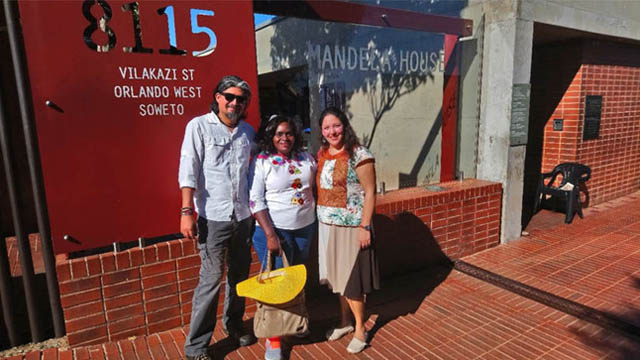
-
 Esther Kibuka-Sebitosi
Esther Kibuka-SebitosiThe Mandela House is located in Vilakazi Street 8115, Orlando West, Soweto. Now a museum, the Mandela House Museum is where the struggle icons Winnie Madikizela Mandela and her husband Nelson Mandela lived. There, they brought up their two daughters Zenani and Zindzi. Nelson Mandela spent little time at the house as he had to go underground during the struggle between 1946 until 1990s. He was arrested in 1962.
Winnie Mandela had to bring up the children while continuing the struggle. She was banished to the Free State town of Brandfort in 1977. Winnie Mandela was born in Mbongweni village, Bizana, Transkei on 26 September, 1936. She married Nelson Mandela in 1958. The marriage to a freedom fighter was a lonely one. The police often raided the Vilakazi Street 8115. Her husband was absent with meetings and amidst the turbulence she had to bring up the girls. In October 1958 she took part in the lady’s march to protest against pass laws. This was similar to the one in 1956 in Pretoria. She was an anti-apartheid activist and politician. She divorced Nelson Mandela in 1996 and was the minister of arts and culture from 1994 to 1996. She led a quiet life and on her 80th birthday, she was honored by family friends and politicians, including Julius Malema and the future President of South Africa, Cyril Ramaphosa, and Patricia de Lille, former mayor of Cape Town. This demonstrated her relationships with all political parties. She passed on 2 April 2018. A true mother of the nation.
Nelson Rolihlahla Mandela was born in Umtata on 18 July 1918. At the famous Rivonia trial, Mandela was brought before the court for his involvement in sabotage and violence in 1962. He was imprisoned for 27 years in total. He was first sent to Robben Island but later transferred to Victor Verster Prison in 1988. He was released from prison after 27 years in 1990 and he came home for only 11 months, after which he moved to a bigger home in Houghton, Johannesburg. The former State President, de Klerk, ordered his release and removed a ban on the political movement the African National Congress. Mandela served as President of the African National Congress (ANC) from 1991 to 1997. His Presidency is known for his legacy in ending racism, trying to fight poverty and inequality. He was dreaming of a nation free of racism with all people living together with all colours; the so-called Rainbow Nation. He wanted freedom without violence but the oppressors started killing his people. He then formed the Umkhonto we Sizwe, a military arm of the ANC. Nelson Mandela received a Nobel Peace Prize in 1993 with former state President of South Africa, Frederik Willem de Klerk.
The Mandela House has four bedrooms and one of them goes down memory lane. It brings both tears and relief, knowing that the Mandelas survived petrol bombs and bullets in the house during riots. The Mandela House Museum contains several honorary degrees awarded to Nelson and Winnie Madikizela-Mandela. It also hosts artefacts, memorabilia and artworks including “Tears of Freedom” by Leonard Katete, a Ugandan living in Kenya. The museum is a monument of history, harbouring family photographs dating back as far as the 1950s.
The Nelson Mandela Museum is open for public tours and photographs are allowed.
Vilakazi Street was also home to Bishop Desmond Mpilo Tutu, who was an Anglican Bishop and theologian well known for his humorous and critical speeches that call to order the freedom fighters. He played a major role during the anti-apartheid and human rights struggle for South Africa. Bishop Desmond Tutu was honoured with a Nobel Peace Prize for his achievements in opposition to South Africa’s brutal apartheid regime. He took a non-violent yet fearless stance against the oppressors, a characteristic that made him stand out amongst the liberation leaders. He articulated the sufferings of ordinary South Africans in clear manner and at the same time spoke up about the oppressive regiment. It is not surprising that Bishop Tutu’s Peace Prize paved the way for strict sanctions against South Africa in the 1980s.
Bishop Tutu chaired the Truth and Reconciliation Commission in 1995. Due to the fact that South Africa had suffered many wounds during apartheid, the many crimes committed by white rulers and atrocities against the black majority, the commission was established to “enable South Africans to come to terms with their past on a morally accepted basis and to advance the cause of reconciliation." The lack of social cohesion mainly due to racial disharmony led the newly elected Government led by Nelson Mandela to put together the Truth and Reconciliation Commission (TRC) under the chairmanship of Bishop Desmond Tutu. Cases such as the Soweto Riots (1976), in which Hector Pieterson was killed, were discussed; the Sharpeville Protests (1960 and 1984) and a number of other prominent cases were dealt with. Forgiveness was recommended as the fundamental condition of healing.
Vilakazi is also known for the Hector Pieterson Memorial and Museum, which were established to remember the Soweto uprising on June 16, 1976. Hector Pieterson was shot during the revolt on the day when schoolchildren demonstrated against the use of Afrikaans as a language of instruction for middle and secondary school.
Vilakazi Street and the Nelson Mandela Museum attract a number of tourists. The street is vibrant with good local food, music and dance. It has created small businesses in the township and is thereby contributing to the local economy.
References
- https://www.sahistory.org.za/people/winnie-madikizela-mandela
- https://www.sahistory.org.za/article/tutu-and-his-role-truth-reconciliation-commission, retrieved 26 January, 2019
- https://www.nobelprize.org/prizes/peace/1993/mandela/biographical/ , retrieved 26 January, 2019
published April 2020
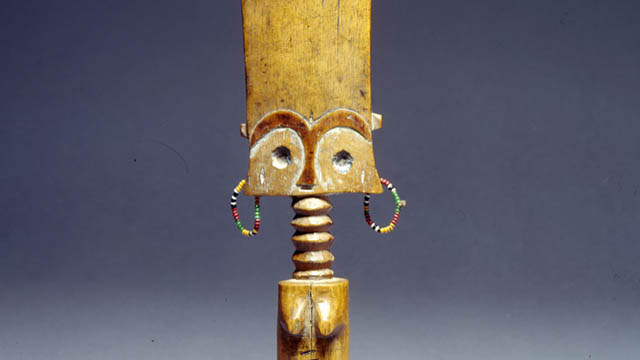
-
 Gertrude Nkrumah
Gertrude NkrumahInversion of Hegemony with Ideas of Femininity
Scholarly works abound on factors and causes of gender inequality in the Ghanaian society and many of these writings address gender inequality solely in terms of women as the victims and thus reinforcing the gender stereotype of female passivity. Although this is true in most cases, such studies do not necessarily address the question of how women have responded to and addressed issues of gender expectations and gender-related roles in African societies. By using the ‘Akuaba’ doll (fertility figurine), this research seeks to explore how the concept of womanhood has been portrayed and represented through time in the Ghanaian society among the Akan ethnic group. It seeks to extend an argument for the interpretation of these images beyond the depiction of women as sexual objects to that of creating an inversion of female hegemony in the society. I argue that instead of considering gender stereotypes as an all-pervasive oppressive tool, we must begin to think of the finer nuances and conceptualize how women have shaped, redefined, and negotiated socio-cultural construction of gender.
The object is widely referred to as the fertility figure, also known as the Akuaba doll among the Akans of Ghana. My reasons for selecting this object are two-fold. Firstly, it speaks to my childhood experiences as a girl growing up in an Akan society and secondly, as someone who is very passionate about gender-related issues either from an intellectual and personal perspectives, I was motivated to choose for this project an object that I can easily relate to, both from a personal and intellectual perspectives.
The object in question is the depiction of a female body, an exhibition of the Akan concept of an ideal woman. The features include a flat forehead with an elongated “ring-like neck shape”1 which reflects Akan standard of beauty. The understanding is that a woman with this type of neck is well-fed, healthy, and strong, a paragon of beauty and affluence. The flat broad forehead also is an embodiment of wisdom, while the accentuated breasts and hips with beads worn arounds the waist is the Akan ideal of womanhood, a depiction of woman as the giver of life. The beads worn around the waist has both aesthetic and symbolical meanings. In terms of beauty, beads were worn as an ornament for beautification, just as portrayed by the wearing of the jewels around her ears. It was also believed that wearing of beads around the waist is sexually appealing, while beads were also worn to broaden the hips and shape the waist for reproductive purposes. It is important to note that in the Akan society, and indeed in most Ghanaian culture, an ideal woman is one that carries and bears children. Clearly, ideas of beauty, sexuality and reproduction were the very essence of womanhood or femininity in the Akan society.
According to a very popular Akan oral tradition, the Akuaba doll is deeply rooted in one’s woman’s quest to overcome her inability in meeting societal ideas and expectation of womanhood.2 Akua, a childless woman, consulted a ritual specialist for a child. She was instructed to go to a woodcarver and make a doll of her choice for a child. Some rituals were then performed on the doll and given back to her to take home and treat and care for as her child. Later she became pregnant and gave birth to a daughter, just as she desired. The Akuaba doll then became symbolic for female reproduction. Amenumey explains that the Akuaba dolls were “…supposed to induce fertility and pregnancy….”.3 Among the Akan, like most precolonial Ghanaian societies, the concept of womanhood was largely defined and shaped by a woman’s ability to give birth to as many children as possible. Childbearing was a blessing from the gods and was usually celebrated with pomp and merrymaking. For instance, the custom was to reward a man whose wife has given birth to ten children with a sheep. The Akan refer to this as “badudwan”4 literally, a sheep for the tenth child. This was usually provided by the wife’s family to the husband to show their appreciation for the replenishing and sustainability of their family.5 In the quest to attain such feat, women worked hard to give birth to at least this number of children as prove of her worth to her husband and the society. This undoubtedly made women who were childless in the society feel undervalued and highly marginalized.
Such ideas and concepts of womanhood and inadvertent marginalisation of women still resonate in contemporary Ghanaian society and indeed in most contemporary societies. A woman’s value and worth continue to be tied with her sexual and reproductive abilities. Although women at present now have access to spaces and engage in works that go beyond the traditionally assigned roles of wife and motherhood (sexual and reproductive values), a woman is still expected to neatly fit in with socio-cultural construct of gender. This underscores the value place on women’s sexuality and reproduction to the detriment of other roles beyond these norms, thus leading to the marginalization of women. It is for these reasons that scholars such as Lerner and Allman have often called for the need to question entrenched patriarchal norms that undermine women’s oppression while it reinforces male- superiority.6
The understanding that women have continually been passive and largely detached from the making of their own history and are mere tools in the hands of a patriarchal society is neatly contested by the history behind the Akuaba doll. While it is true that it was Akua’s desperation to fit into societal expectation of ideals of motherhood that forced her to consult a diviner to help her conceive a child, the knowledge that Akua chose to actively engaged with the process of making the doll; how the doll is carved out, the shape, the physical features, and the aesthetic nature is significant. Additionally, the fact that she chose to carve out a girl child clearly indicates the active role she played in redefining and negotiating power with the matrilineal, yet patriarchal society, thus creating and inverting power in an all-pervasive patriarchal institution. It is also an indication that she did not consider the female as of little value in her society.
Paradoxically then, the history and philosophical ideologies that underpin the concept of the Akuaba doll is a clear exhibition of the nuances and complexities of societal construction of gender roles and status. In a society with a deeply entrenched gender expectations and assigned gender roles, it is remarkable that Akua sought to circumvent, manipulate, and yet conversely acquiesce with existing status quo to her advantage, an inversion of hegemony amidst patriarchal privilege. Therein lies the ambiguities and contradictions of performing gender.
References
- Addo-Fening, R (1973). Asante refugees in Akyem Abuakwa 1875-1912. Transactions of the Historical Society of Ghana. 14, 1. 39-64.
- Akyeampong, E & Obeng, P. (1995). Spirituality, Gender, and Power in Asante History. The International Journal of African Historical Studies. 28, 3. 481-508.
- Allman, Jean. (1996). “Rounding up Spinsters: Gender Chaos and Unmarried Women in Colonial Asante.” Journal of African History, 37, 2, 195-214.
- Amenumey, D. E. K. (2008). Ghana: A concise history from pre-colonial times to the 20th Century. Accra: Woeli Publishing.
- Appiah Anthony K. (1991) “Is the Post- in Postmodernism the Post- in Postcolonial? Critical Inquiry. Vol. 17, No. 2. 336-357.
- Lerner, G. (1994). The creation of feminist consciousness: From the Middle Ages to 1870. Oxford: Oxford University Press.
- Lerner, G. (1986). The creation of patriarchy. New York: Oxford University Press.
Footnotes
1) It is quite common today to hear songs in the Ghanaian society eulogising a woman’s beauty by referring to her ring-shaped neck, together with other physical features. This is an indication that the Akan standard of beauty in the past as enshrined in the Akuaba doll continue to resonate with contemporary Ghanaian societies.
2) This is a popular story among the Akans and was often recounted to young girls especially by an older woman in the family or society. I grew up listening to these stories from my mother and grandmother, among others.
3) D. E K. Amenumey. (2008). Ghana: A concise history from pre-colonial times to the 20th Century. Accra: Woeli Publishing. P. 90. From a spiritual and philosophical perspectives, the use of the Akuaba went beyond just fulfilling the desires of childless women. In most of these Akan societies, when a woman gives birth to twins but in an unlikely situation where one of them dies, she is expected to make a replica of an Akuaba doll in replacing the dead child. Some would also bury the dead child with the Akuaba doll as a way of warding off evil spirit from killing the living child.
4) “Badu” is an Akan name for the tenth born child. ‘Ba’ or ‘ɛba’ is the Twi word for child, while ‘ɛdu’ or ‘du ‘means the number ten in the Akan language. Therefore, the name Badu in Akan usually refers to a tenth born child.
5) It is significant to point out that Akan society, unlike most ethnic groups such as the Mole-Dagbani, Ewe, Ga-Adangbe and Guan, is mostly a matrilineal society. Lineage, inheritance, and chieftaincy succession have always been through the female line. Although precolonial Akan society was not completely immune from patriarchal ideals, women played important roles and and had significant status in society especially in areas of religion, politics and economy. For further details on this, see for example the articles Addo-Fening, R (1973). Asante refugees in Akyem Abuakwa 1875-1912. Transactions of the Historical Society of Ghana. 14, 1. 39-64 & Akyeampong, E & Obeng, P. (1995). Spirituality, Gender, and Power in Asante History. The International Journal of African Historical Studies. 28, 3. 481-508.
6) See for example, Allman, J. (1996). “Rounding up Spinsters: Gender Chaos and Unmarried Women in Colonial Asante.” Journal of African History, 37, 2, 195-214, Lerner, G. (1994). The creation of feminist consciousness: From the Middle Ages to 1870. Oxford: Oxford University Press., & Lerner, G. (1986). The creation of patriarchy. New York: Oxford University Press.
This article is part of a gallery: Perspectives from Ghana on Museum Objects in Germany
published January 2021
 ISB_Team
ISB_TeamA German Perspective on the Akuaba Doll in the Museum Fünf Kontinente Munich
Akuaba Dolls are wooden figures that were and apparently still are in use mainly in rural areas in southern Ghana. Young women hoping for pregnancy or - if they are already pregnant - for the health and beauty of their child, wear these figures on their bodies like real babies and take care of them. That is why they are called 'dolls'.
Akuaba or better Akua-Bà literally means 'child of Akua'. The story tells of "a woman named >Akua< who could not get pregnant and went to a local diviner or priest and commissioned the carving of a small wooden doll. She carried and cared for the doll as if it were her own child, feeding it, bathing it and so on. Soon the people in the village started calling it >Akua< >ba< - meaning >Akuaba's child<, since >ba< means child. She soon became pregnant and her daughter grew up with the doll." (Annor et al., p. 308)
This story also forms the basis for the function of the widespread dolls as aids in a desire for pregnancy. An Akuaba Doll expresses this desire for a child, so the figure is 'cared for' by a girl from puberty onwards. This happens within the family. Outside the family, Akuaba Dolls can be found in shrines under the care of a ritual specialist, where they can be borrowed for their purpose.
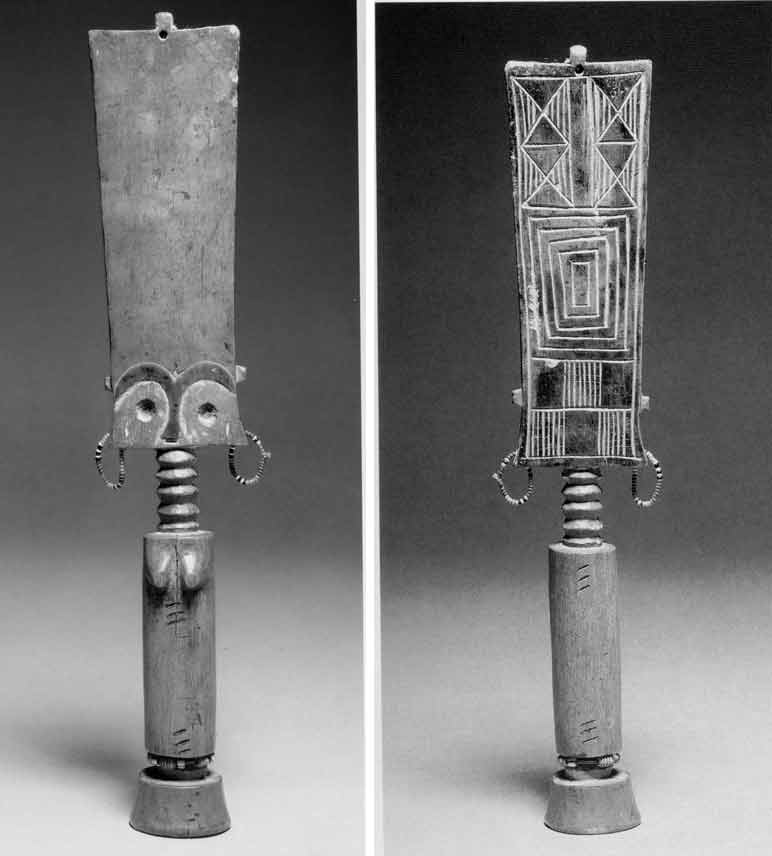
Fig. 1 & Fig. 2 Views of the Akuaba Doll in the Munich Museum Fünf Kontinente
Anonymous artist. Fante Fertility Figure. Early 20th century, Wood. 27,5 cm. Museum Fünf Kontinente. Presentation at Museum Fünf Kontinente.
© Museum Fünf Kontinente
Description
The doll in Munich's Museum Fünf Kontinente (Fig.1) comes from the Fante area. It shows a female figure. The very strongly abstracted forms and proportions symbolise various aspects:
The rectangular shape of the very flat head becomes - seen from the front - somewhat broader in an elegant curve towards the top. A strikingly high forehead, with eyes, eyebrows and nose only indicated, while mouth and ears are missing. The accentuated arch segments of the eyebrows flow together and then form the nose. On the back, the head has geometric patterns (Fig. 2). Added earrings of glass beads give the figure a colourful accent. For Kecskési (p. 38), their daintiness is a sign that the doll has been lovingly treated. At the very top there is another small moulding with a hole where hair was originally attached (compare Fig. 3a).
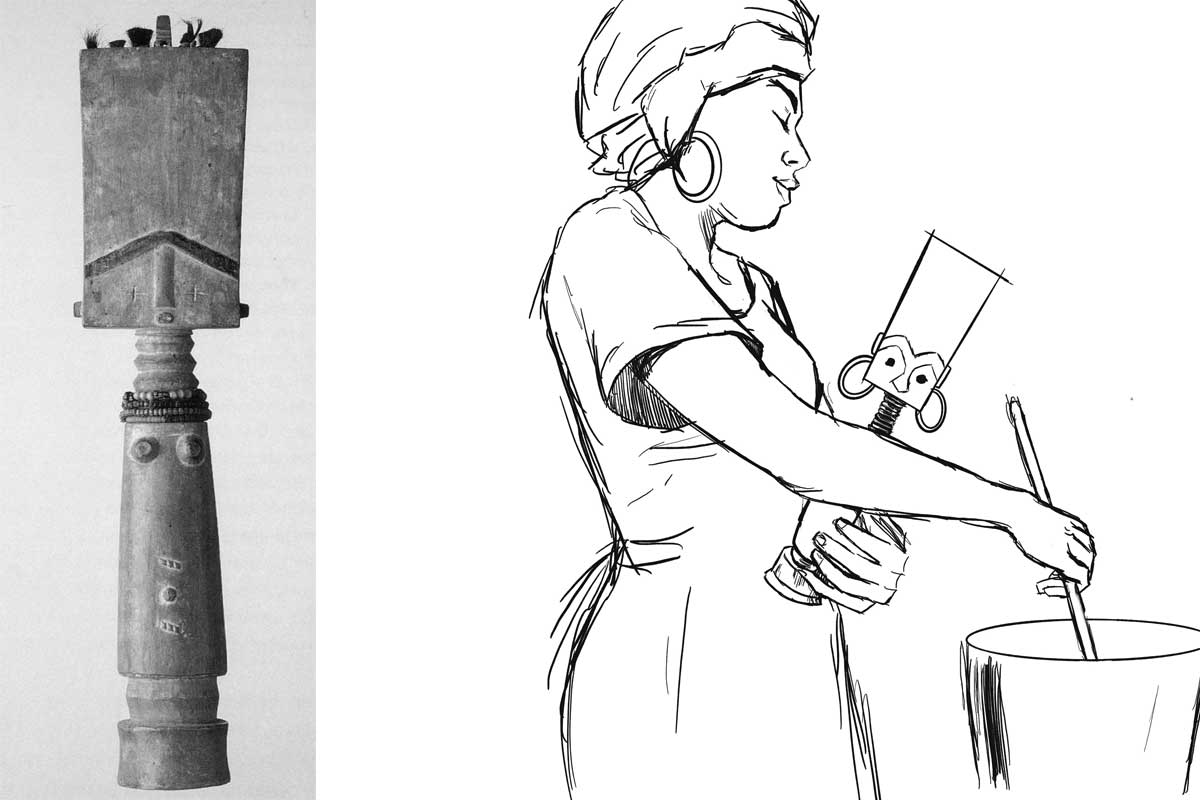
Fig. 3a: Akuaba Doll from the Linden Museum Stuttgart (Forkl p. 94). Fig. 3b: Use of the doll (drawing by Vanessa Rast - courtesy the artist)
The neck has five rings. It sits on a very slender, round trunk, which in turn stands on a delicate base. Striking are two groups of three diagonal embrasures each, which are repeated on the back. The figure has no arms, the legs are short stumps. The protruding forms in the chest area mark the figure as female. Its strict symmetry is softened by small deviations. One can well imagine taking the cylindrical figure in one's hand.
Material and technique
A ritual specialist to whom a woman who wishes to have a child goes makes the decision about the choice of doll at the respective shrine. If no suitable figures are available there, he instructs the woman to order a new Akuaba Doll from the woodcarver. The craftsmen then visit the tree to obtain the wood and ask the tree's spirits for permission to do so (oral information from the Ghanaian colleagues 2022 in Bayreuth [Link]). The Akuaba Doll in the Munich Museum was carved from softwood. (There are also darker examples made of hardwood, for example among the Ashanti, also an Akan group, as the presentation in the Ghana National Museum in Accra shows - see Fig. 4.) In the example in Munich, eyebrows and nose are darker.
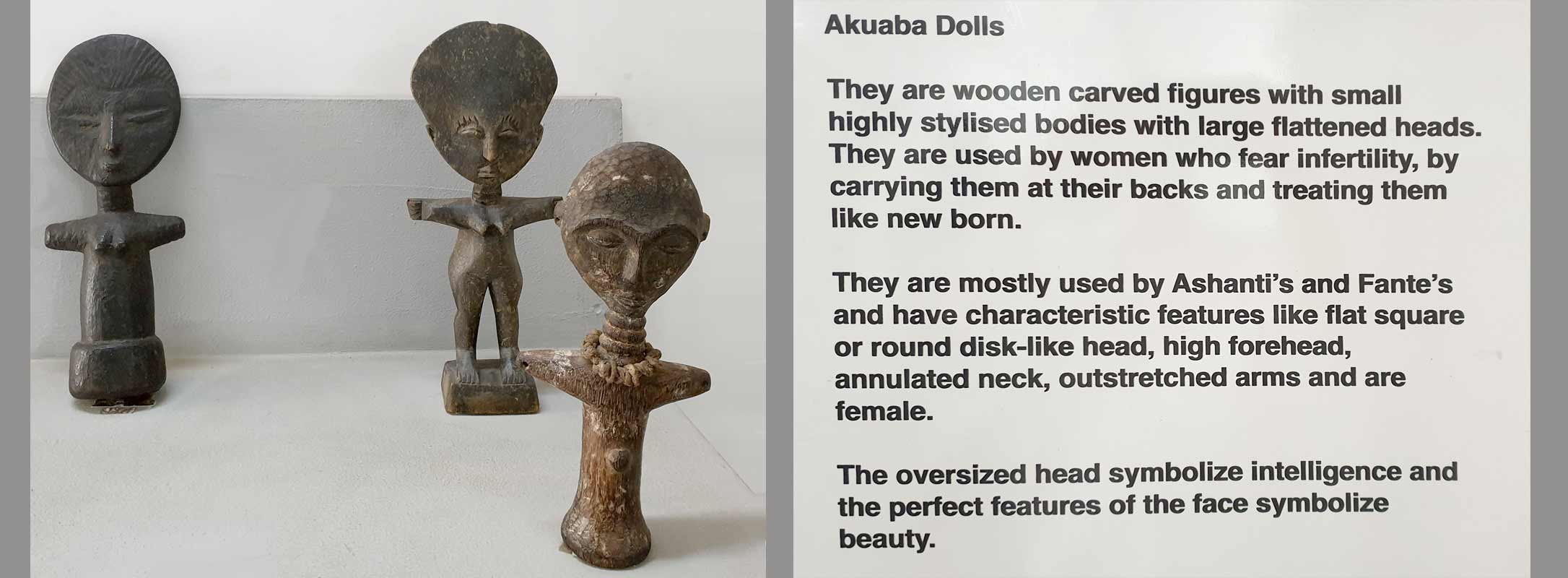
Fig. 4: Presentation of Akuaba Dolls at the Ghana National Museum in Accra (March 2023. Photo: the author)
Interpretation of the Munich figure within the original Ghanaian context
(1) Utility function: The figure is made for the family context. It is meant to lead to fertility, sometimes also to the beauty of a child. The size (height 28 cm), the pleasant material and the weight allow the figure to be carried and cared for like a baby. When an Akuaba Doll has fulfilled its task, it is often returned to the ritual specialist who accompanies the process.
The breasts indicate a female figure, which does not necessarily have to do with a corresponding desire for the sex of the child desired. Forkl (p. 94) assumes, however, that "women desire daughters, on the one hand as progenitors in a matrilineality oriented society, and on the other hand as support in household work." (There are also Akuaba figures with the characteristics of both sexes and probably male specimens; furthermore, breastfeeding examples and those who in turn carry other Akuaba Dolls.)
(2) Body shape: T The conspicuous and disproportionately large rectangular head symbolises the head as the seat of intellect and wisdom in local imagery. Akuaba figures among the Ashanti show round heads (see fig. 4), but they are also proportionally very large. High foreheads and flat faces correspond to the ideal of beauty. Luxuriant bulges on the necks tell that the figure is well-fed and thus refer to happiness and prosperity. There are Akuaba Dolls that show more feminine body shapes, wider hips, possibly emphasised by strings of pearls.
(3) The spiritual context: As Nkrumah writes in her contribution, an Akuaba figure serves as a dwelling place for a soul being, a being that is in a transitional area between the earthly and the spiritual world. Carrying and caring for it is a prerequisite for the entrance of such a soul being, which then sets out to appear on earth as a living being, i.e. to enter the family of the young woman through birth. A ritual specialist is involved in the selection, consecration and regulations for use. After a birth, the figure is returned to the ritual specialist.[1]
(4) The social and cultural context: The figure can also be seen as a sign of the traditional expectation for a woman to bring children into the world. In recent times, where traditional societal expectations of women collide with other worldviews, the ritual use of Akuaba Dolls obviously decreases .

Fig. 5: Souvenir shop at Accra Airport (March 2023. Photo: the author)
In the last decades, an interesting production for tourism has been established - apparently the dolls are seen as 'typical for Ghana'. However, these are not Akuaba Dolls in the traditional sense, but rather 'quotes'.
How can one relate Akuaba Dolls to European visual traditions and experiences?
As familiar as the image of an Akuaba figure may seem in Europe - as a 'typical' example of traditional African art - its traditional meaning is unknown in Europe. Nevertheless, it obviously seems to be attractive to tourists, e.g. as 'airport art' (see Fig. 5), perhaps because its shape somehow corresponds to the cliché idea of 'typically African', the size fits well into the suitcase, or the large head (by means of the Bambi effect) makes it appear 'cute'.
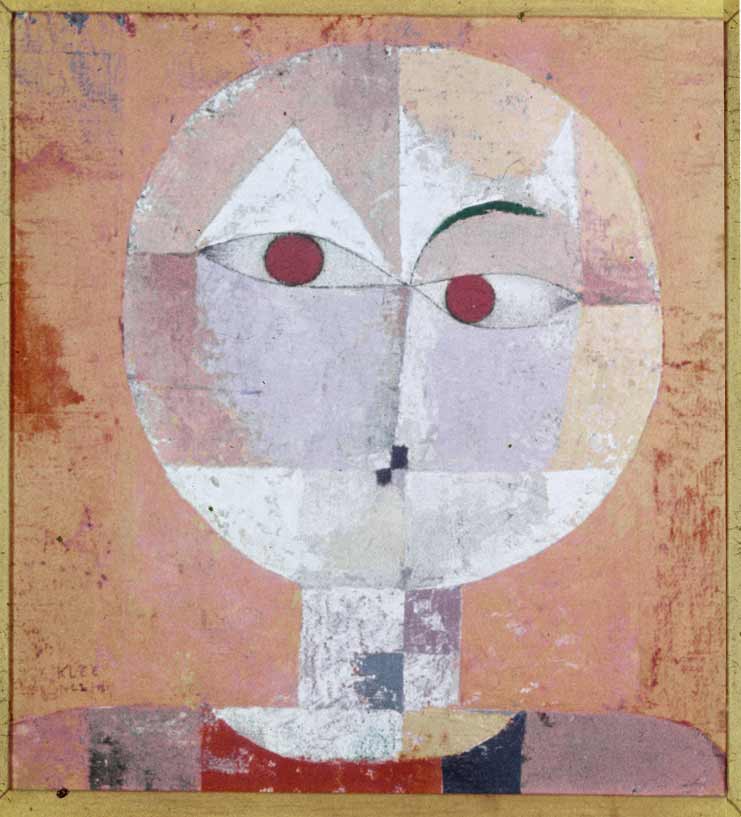
Fig. 6: Paul Klee. Senecio. 1922. Oil on chalk base on gauze on cardboard. 40.3 × 37.4 cm. Kunstmuseum Basel (Wiki Commons)
In the context of art history, the influence of Akuaba Dolls (and many other carved representations from West Africa) on European art of the early 20th century (see Fig. 6) is of interest. [2] The formal similarity to Klee's painting (fig. 6) is striking at first glance, but whether this is a direct reference must first be verified. In the context of art history, it would then be of interest in a next step which aesthetics were of interest to the artists at the time and which they blanked out, i.e. which "image of Africa" they wanted to have and also communicate.
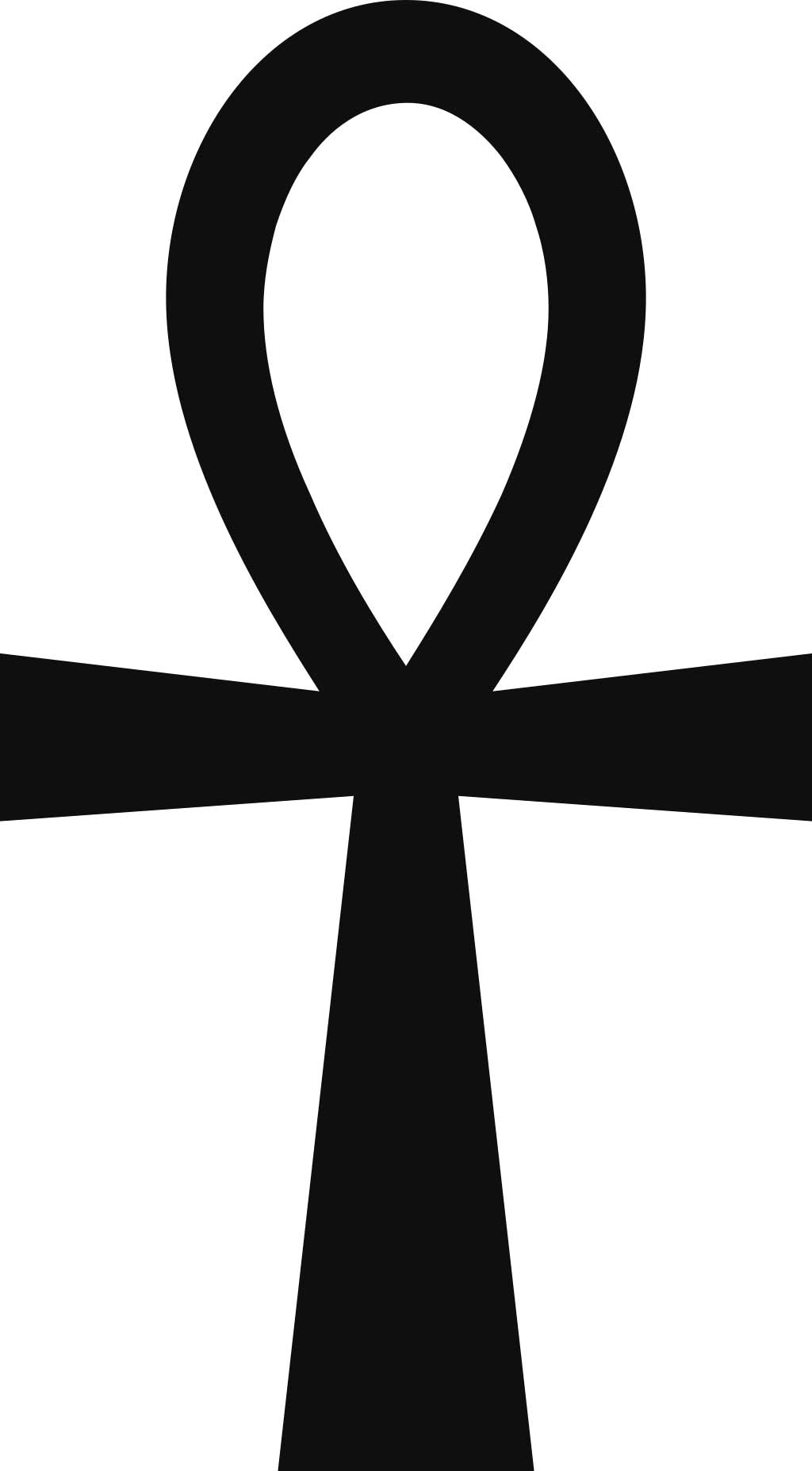
Fig. 7: Hieroglyph Anch
(Photo: https://anthrowiki.at/Anch)
The authors also considered whether the formal similarity of the Akuaba Dolls with the ancient Egyptian hieroglyph ‘Anch’ (the "loop of life" or the "key of life" - see Fig. 7) could have come about through a historical relationship between Egypt and Ghana. This would also correspond to the accentuation of content in Nkrumah's text with regard to the "representation of the woman as the giver of life" (see her chapter). Nevertheless, this association would also have to be examined more closely. To assume a universal archetype in the sense of C. G. Jung appears to be pedagogically misleading in its levelling effect.
In the German educational context, on the other hand, it seems important to link the figure - beyond clarifying its function - to Akua's story and thus include the role of narratives. This prevents another comparison that is also too quick and reductive when it comes to social practices (and not the isolated object), as dolls are also cared for and nurtured in traditional European contexts, but mostly by young children before puberty. So, in Europe, it does not belong to a fertility ritual, even if the child puts itself in the role of a ‘little mother’ or ‘little father’. (Another interesting question, whether Ghanaian women also go to a doctor when they are not pregnant, and whether there are comparable ritualised practices in Central Europe - for example among alternative practitioners or in esoteric circles - would have to be addressed in interdisciplinary approaches.)
Such comparisons appear to be useful, as they can show both similarities and differences, with the aim of better recognising one's own perceptual conventions or stereotypes and thus putting them into perspective. All this still leaves the question of the status of this doll in Munich when it is displayed in a showcase in a European museum (see Lab entry: What is an object? Link). Such a presentation contradicts its ritual and spiritual use. An Akuaba is then no longer an Akuaba. But what is it then?
Sources
This text is based on:
- Contribution by Gertrude Nkrumah: https://explore-vc.org/en/objects/the-akuaba-doll.html
- Talks with the Ghanaian EVC partners in Bayreuth in 2022: https://explore-vc.org/en/activities/archive/april-22-25-2022-joint-workshop-uew-team-and-isb-team.html
- The presentation at the National Museum in Accra, seen in March 2023: Fig. 4.
- Reading: see list of references
References
- Akyeampong, E & Obeng, P. (1995). Spirituality, Gender, and Power in Asante History. The International Journal of African Historical Studies. 28, 3. pp 481-508
- Anderson, Elizabeth L. (1989): The Levels of Meaning of an Ashanti Akua'ba. In: Michigan Academican. 21 205-219
- Annor, I., Dickson, A & Dzidzornu, A. G. (2011): General Knowledge in Art. Accra (Aki-Ola Publications)
- Forkl H. (1997): Healing and body art in Africa. Stuttgart (Lindenmuseum)
- Kecskési, M. (1999): Kunst aus Afrika - Museum für Völkerkunde München. Munich (Prestel)
Footnotes
[1] The number of five neck bulges here (there are also specimens with 3, 8 or 9 bulges) may also be a reference to the sacred number of "Odumankoma", the Akan creator deity, in this context.
[2] On the relationship of the European avant-garde to the aesthetics of West African carvings, see also the discussion of the Blue Rider post on this website (link 1 and 2).
 Christin Winter
Christin WinterMy Encounter with Black Feminism and Womanhood Inspired by the Akuaba Doll
I first came in contact with the Akuaba Doll while reading Bernardine Evaristo’s award winning book Girl, Woman, Other. In the book, the character Nazinga was described as “at least six foot tall with ornamented dreadlocks, large wooden Akuaba fertility doll earrings, red trousers, a cream embroidered caftan and strappy Roman sandals“ (Evarsito 2020, p. 81). I searched for Akuaba fertility doll earrings on the internet, but did not delve further into the topic at this time. A few weeks later, attending a seminar with Dr. Wagner at Friedrich-Alexander University in Erlangen, I stumbled upon the Akuaba Doll again. I knew, I had to take this opportunity to get to know her better. The comment from Gertrude Nkrumah is to be considered my first source of information about the history of origin and the tradition into which the Akuaba Doll is woven.
Through Nkrumah's feminist perspective on the Akuaba Doll, I wanted to dive deeper into the topic of Black Feminism to extend my knowledge in feminist theory. With the Akuaba Doll as my point of departure, I decided to focus on the ability to bear children and the social significance of abortions for Black women.[1]
At this point I move past the Akuaba Doll and her cultural context. Other works of art could have led me to a similar path. I have chosen to look at the Akuaba Doll with categories, which are not directly related to the Akuaba Doll and her cultural context as I questioned whether I have the right to write about the Akuaba Doll considering the colonial past of my own country, Germany. I am a white, European woman, a feminist, who is aware of intersectionality and racist structures within the society I have been socialised in and its way of thinking, but with no cultural connection to the Akuaba Doll other than the colonial impact on African art and culture (cf. Kushinator, Rahman and Dompreh, 2020[2]). Therefore, I chose a topic to which I have access via my role as a student of pedagogy and focus on Black Feminism and Womanhood of Black women living in white-dominated countries.
In white-dominated societies, Black women were excluded from a feminist movement for decades (cf. hooks, p. 216f.). White women systematically utilised the racist hierarchy within women to gain power and thereby forced a specific Black feminist movement to form and uncover the oppression Black women had and still have to face. The prefix “Black” emphases the specific oppression Black women face in white-dominated countries, although, of course, there has been feminist movements in Black-dominated countries before (cf. Roig quoted from Berlin Biennale 2022, 48:00 – 49:50).
In American history, Black women have always had to fight to be seen as women. As bell hooks gets to the heart of it: “the black female was a creature unworthy of the title woman; she was mere chattel, a thing, an animal” (hooks 2015, p. 214). Sojourner Truth[3] had to bare her breasts to prove that she was a woman indeed. Being yelled at “I don’t believe you really are a woman” by a white man represents the contempt and disrespect for Black womanhood (cf. hooks 2015, p. 214). In her famous speech “Ain’ I a Woman” (1851), she argues, that she – as her white women audience too – is indeed a woman. Here she argues with characteristics, that can also be found in the Akuaba Doll. The most important argument is the carrying and bearing of children and the “mother’s grief” (Truth 1851 quoted from hooks 2015, p. 215) she cried out, when her children were sold into slavery.
The ability to bear children has always played an important role in the history of womanhood and was – and still is – utilised to oppress and exploit Black women. In times of slavery, Black women were forced to procreate and bear children, who were worth a lot of money in a perfidious system of human trafficking (cf. Federici 2020, p. 23f.). In the late 20th century, Black men in the U.S. reasserted what they called their “rightful positions as patriarchs” (Taylor 2022) and denounced birth control and abortions as genocide that compromised the future and freedom of Black families by limiting the Black population (cf. Federici, p. 25f.). With the overturn of Roe v. Wade[4] – Black women are specifically affected, as Kwajelyn Jackson, Executive Director of the Feminist Women’s Health Center in Atlanta, Georgia puts it into a nutshell: "Abortion bans are inherently racist because they do not consider the lived experiences of Black people and other communities of colour. Many state policymakers would rather criminalize and endanger Black birthing people than supply them with all of the resources they actually need" (Jackson quoted from Long 2022). Even before the abortion laws were restricted, Black (and other BIPoc) women in the U.S were two to three times more likely to die from pregnancy-related causes than white women (cf. CDC 2019). Being allowed to decide whether you want children or not and furthermore, having access to certain facilities to end a pregnancy or not is still a bound to privileges. It is not only tied to the health care system, but also to cultural beliefs and practices, to the financial and educational background, as well as to class, race and many other factors.
In a world imprinted by patriarchy and privilege, it is important to unravel power structures that dominate our world, uncover where they come from and how different groups are affected differently. As patriarchal patterns of thought are inscribed in nearly all societies of our world, it is a tough task to uncover them in every aspect of our lives and hence require lifelong learning and feminist thought. Nevertheless, it is indispensable in order to build an anti-racist gender-equal society in which every woman can decide herself, if she wants to get children without fearing financial or social consequences.
In this context the Akuaba Doll can be interpreted as an early moment of feminism, where women disrupt the patriarchal system that marginalizes them. As Nkrumah states, by deciding about the gender of her child in a binary system, she chose to bear a girl rather than a boy, which – in the matrilineal line – effects the lineage, inheritance, and chieftaincy succession (cf. Nkrumah 2020). In my eyes, Akua used the power she had to influence her life to her advantage. Yet the worth of women was still tied to her sexual and reproductive abilities, but nevertheless she made a first step by empowering women to stand up for themselves and for their own lives.
References
Berlin Biennale (2022). Panel: Afrofeminism. Bridging the Gap. <https://12.berlinbiennale.de/media/panel-afrofeminisms-bridging-the-gap/> (09/30/2022).
Center for Reproductive Rights (2022). The World’s Abortion Laws. <https://reproductiverights.org/maps/worlds-abortion-laws/> (09/30/2022)
Evaristo, B. (2020). Girl, Woman, Other. UK: Penguin Books.
Federici, S. (2020). Jenseits unserer Haut. Körper als umkämpfter Ort im Kapitalismus. Münster: Unrast.
hooks, b. (2015). Ain’t I a Woman. Black Women and Feminism. New York: Routledge.
Kushiator, G., Rahman, A. and Dompreh, H.-O. (2020). The Influence of Western Culture on Traditional Art Forms and Cultural Practices: ‘Akuaba’ doll among Akan Women in Africa. ADRRI Journal of Arts and Social Sciences, Ghana: Vol. 17, No.6 (5), S.59 – 71.<https://www.researchgate.net/publication/344438737_The_Influence_of_Western_Culture_on_Traditional_Art_Forms_and_Cultural_Practices_%27Akuaba%27_Doll_Among_Akan_Women_in_Africa> (09/30/2022).
Long, S. (2022). Abortion Bans pose a Danger to all Mothers. For Black Women, they’re especially damaging. <https://www.refinery29.com/en-us/2020/10/10015405/abortion-ban-racism-black-women-effects> (09/30/2022).
Nkrumah, G. (2021). Inversion of Hegemony with Ideas of Feminity. <https://www.explore-vc.org/en/objects/the-akuaba-doll.html> (09/30/2022).
Taylor, K.-Y. (2022). How Black Feminists defined Abortion Rights. <https://www.newyorker.com/news/essay/how-black-feminists-defined-abortion-rights> (09/30/2022).
Footnotes
[1] In this context, I will delve into the topic of reproductive abilities and use the term "woman" throughout my text. However, I want to clarify that the ability to bear children is not a defining characteristic of womanhood. Not all women have a uterus, and not all women are able to bear children. Furthermore, one's physical appearance is not a determining factor of one's gender identity. Despite this, the reproductive ability is instrumentalised in our society and can lead to harmful stereotypes, which many women are confronted with at some point in their lives.
[2] In addition to exploring the different forms and cultural backgrounds of Akuaba Dolls, this article delves into the ways in which culture, religion, and artistic expression are intertwined in African cultures. The article points out how the colonization by white, western, and Christian men and women caused a change in function and values of the Akuaba Doll.
[3] Sojourner Truth lived from 1797 to 1883. She was an American abolitionist of New York Dutch heritage and a women’s rights activist. She was born into slavery, but escaped to freedom in 1826. In 1851 she joined George Thompson, an abolitionist and speaker, on a lecture tour through central and western New York State. At the Ohio Women’s Rights Convention in Akron, Ohio, she gave her speech with later became famous as “Ain’t I a Woman?”
[4] Roe v. Wade is a legal case in which the U.S Supreme Court ruled that unduly restrictive state regulation of abortion is unconstitutional and that the Constitution of the United States generally protects a pregnant woman's liberty to choose to have an abortion. This decision from 1973 was overturned by the U.S. Supreme Court in 2022.

-
 Esther Kibuka-Sebitosi
Esther Kibuka-SebitosiThe discovery of gold in South Africa in the mid 19 thcentury brought about a gold rush. In particular, the discovery of gold at the Langlaagte farm in 1886 attracted fortune seekers from all over the world. With the main gold deposits far below the surface, the need for mining engineering skills increased and resulted into the growth and development of the Johannesburg City Witwatersrand gold reef. Soon mining companies like Hermann Eckstein, Cecil Rhodes and Charles Rudd Gold Fields were established, resulting into mining shares as the trade with precious metal escalated. The traders from various corporations expanded their businesses. The mines however, were labelled as “dangerous” and proved risky for the mainly black miners. This prompted the recruitment of the Chinese to work in the mines in the early 1900s. The struggle of black miners continued over the years, as well as the forced displacement from their land, resulting into the emergence of townships such as Soweto. The disappropriation of their land left the people devastated and the land degraded.
The image shows what is left behind - barren land; land that was degraded after the mining. Sometimes the blessing of minerals can be turned into a “curse of resources” if not handled well. In the rest of Africa, Angola, for instance, the forceful banishment of native people from their land in order to make way for gold, copper, oil and gas exploitation has similar destructive consequences as in South Africa. Similarly, Ghana has had its share of the mineral deposits that have led to expropriations and displacements of landowners and farmers. All these challenges that Africa is facing today need urgent solutions.
Land is the mother of nature. In order to create true sustainable wealth, we need land. Arable land is crucial for food production and safe living. In the 21st century, human development, technology development, industrialisation and urbanization have changed the land use.
Land use conflicts among large multinationals and local communities have increased in Africa. However, only few proper planning of peaceful co-existence is done. In September 2015, the UN member states agreed on a set of 17 Sustainable Development Goals (SDGs), which represent the global agenda for equitable, socially inclusive, and environmentally sustainable economic development until 2030. Mining companies have the potential to become leading partners in achieving the SDGs. Through their direct operations, mining companies can generate profits, employment, and economic growth in low-income countries. Through partnerships with government and civil society, mining companies can ensure that benefits of mining extend beyond the profit of the mine itself, so that the mining industry has a positive impact on the natural environment, climate change, and social capital.
Land use-related impacts and environmental impacts affecting human health and human rights continue to be important social aspects in the mining sector long after the discovery of gold in 1884. The benefits from the revenue are great and raise of employment is positive. However, the demographic changes and migration due to the presence of mines as well as the land use impacts are key challenges to sustainability. In evaluating the mining sector's contribution to society, the negative effects are often underscored. The economic values added in general are portrayed as the positive impacts leaving out the land degradation and resulting demographic dynamics. Consequently, the sector has been involved in controversies over the years.
Most of the arable land has been damaged and polluted especially due to mining. This in turn has resulted into food insecurity and lack of descent housing, among other challenges. The burning of coal as an energy source has resulted into massive increase of global warming. The destruction of arable land is serious. The effect of mineral exploitation on arable land is multifaceted ( Mancinia & Salab. (2018). It causes large areas to be left unproductive but also degradation of water supply. These factors lead to socio-economic structural issues in mining areas. Such areas with hidden cracks would inevitably lack future sustainable development. Without proper compensation for the withdrawal from the cultivated land, the sustainable development of mining areas becomes a complex issue that hovers for generations.
Sustainable development would require partnerships at all levels and sectors. This article is a call to the mining giants to act responsibly to compensate the landowners, put sustainable mining practices into place and give back the land. According to South Africa History Online (https://www.sahistory.org.za/article/land-labour-and-apartheid) land, labour and migrant systems created by the apartheid era continue to disadvantage black society. Firstly, the communities were broken up, families dismantled and people left in abject poverty. Secondly, the policies of the Land Act of 1913 followed by the Land Act of 1933, left little to be desired over land. Coupled with the Bantu education systems, black South Africans still struggle to acquire land.
The images portray the left behind in spirit, soul and body.
References
- Land, Labour and Apartheid. South African History online. Retrieved from https://www.sahistory.org.za/article/land-labour-and-apartheid
- Ka, J., Ayitey J. Za, Kuusaana E.D and Gavu E.Ka. ( 2015). Who is the rightful recipient of mining compensation for land use deprivation in Ghana? Kidido Resources Policy 43 (2015) 19–27
- Mancinia, L. & Serenella Salab, S. (2018). Social impact assessment in the mining sector: Review and comparison of indicators frameworks. Resources Policy 57 (2018) 98–111
- Yong-feng, L., Yuan-hua, L., Zhuan-ping, D. & Jie, C. (2009). Effect of coal resources development and compensation for damage to cultivated land in mining areas. Mining Science and Technology 19 (2009) 620–625.
published May 2020
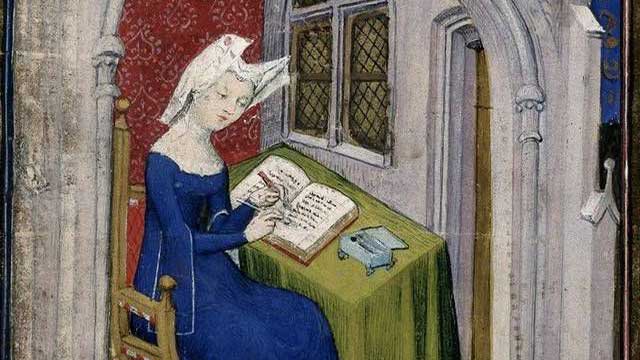
-
 Bea Lundt
Bea LundtThe picture of Christine de Pizan and our knowledge about her life show that this is not true. Christine de Pizan (1364 – c. 1429), born as Cristina da Pizzano in Venice, was a poet and author at the court of King Charles VI of France. Christine produced a large number of vernacular works, in both prose and verse. Her works include political treatises, mirrors for princes, epistles, and poetry.
This very famous miniature is an illustration from a book, handwritten in the years between 1410 and 1414 and preserved at the British Library in London (Harley MS 4431, Vol. 1, fol. 4 r). This manuscript contains texts by Christine de Pizan and is called The Book of the Queen, as it had been produced on behalf of and dedicated to Isabeau of Bavaria, wife of King Charles VI of France. There is another miniature showing Christine on her knees dedicating the book to the French queen. Christine can be identified by her facial features and style of dress.

Detail of: Master of the Cité des Dames and workshop, 1413 - 1414, parchment, 36,5 cm x 28,5 cm, British Library, London. © British Library, London. Photo: the author
In the centre of the aforementioned picture, a woman is shown sitting at a table and writing into a voluminous book. With her left hand, she is erasing coloured letters with a knife and with her right hand correcting them. This dynamic gesture of self-correcting fills her working situation with life. On her head is a headdress typical for a widow, the guimpe/wimple. Around the desk, we see some fictive architecture with a broad symbolic meaning: it shows a room which is specifically tailored to an intellectual working woman but also opens to the outside, as there are windows, an arch, and entryways. The roof of another storey marks the building as a town house. Though the scene is an interior one, the colours on the woman are bright, and there are warm red colours around her. This is different from older pictures showing clerical female authors in the narrow, closed rooms of a cloister.
‘Je, Christine’: An independent author defining her role in society
The picture shows a professional female author in an urban context in the process of writing a book and working for the public, where she is honoured as being part of the highest level of society. There are similar pictures with Christine sitting behind her desk with an open book and people coming and arguing with her in a lively manner. In one, a young man, who has been identified as her son, stands in front of her and speaks to her. Another one shows four men visiting her in her room and discussing her writings with her. Sitting Christine, standing men: the arrangement shows that the guests will leave soon. Such encounters are also atypical for a cloister, which is said to be the usual space for educated women.
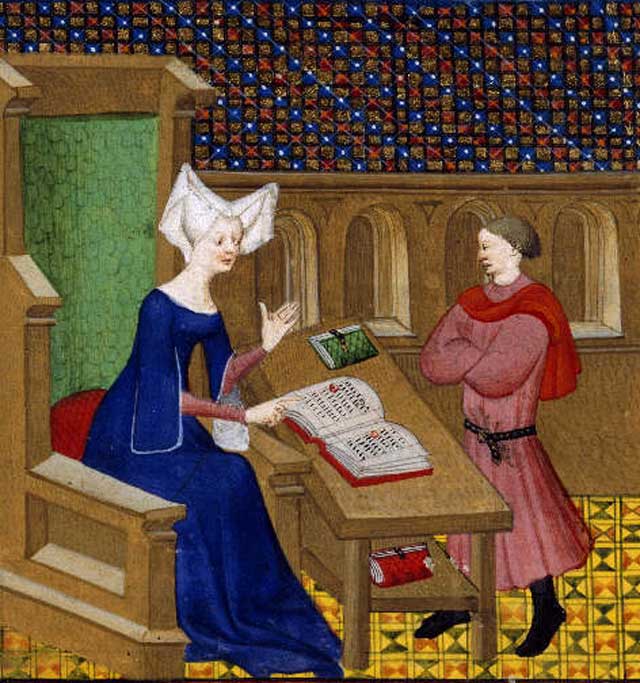
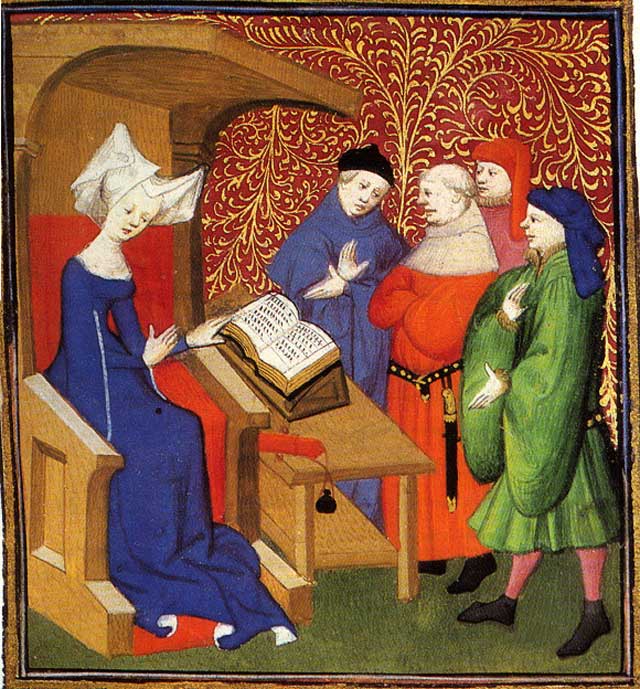
Detail of: Master of the Cité des Dames and workshop, 1413 - 1414, parchment, 36,5 cm x 28,5 cm, British Library, London. © British Library, London. Photo: the author
As experts see it, it was Christine herself who ordered the illustrator to characterise her in this manner. Several autobiographical comments of hers document that she liked to show herself living this individualist intellectual lifestyle. Traditional scholars call this typical for the Renaissance, which began a bit after Christine’s lifetime. Very often in her books we find ‘Je, Christine’ (‘I, Christine’), at the beginning of a chapter.
Christine’s life story
Christine was born in Venice in 1364 as the daughter of a doctor of medicine and astrology. He was called to the French court in Paris. Christine married a royal secretary and had three children. But then her father, her husband, and the king who had supported the family died. Christine was 25 years old and had to care not only for her children but also for her old mother and younger relatives living with her. She decided not to marry again but to support her living by writing. Her oeuvre contains poems alongside utopian, philosophical, historian, didactical, allegorical, and autobiographical texts. Noble families ordered her books and paid her well. In her old age, she escaped from the civil war in Paris to a cloister nearby where she died around 1429.
The first secular female author in Europe
With her Italian-French background, Christine is an example for the migration of intellectuals in southern Europe in the late Middle Ages and early Renaissance. She was not herself noble but came from an academic family and remained near the court. She was privately educated, mostly by her father, and also educated herself using the offer of the erudition centre in France. Living within a totally Christian cosmos with a spiritual way of thinking, she was not a clerical but rather a secular woman. In her books, she fought for gender equality, especially in education, as well as for recognizing the extraordinary performances of women in the past and in her own time. She wanted this knowledge to be part of a new understanding of history. She sharply protested against texts which reduce women to sex objects. With her pugnacious notes, she provoked the first literary quarrel about femininity and masculinity in Europe, the ‘Querelle des Femmes’.
The masculinisation of literacy and education in the modern era
In premodern Europe, competencies in literacy were considered more or less ‘feminine’. Girls learned to read at least the Bible to their families; noblewomen were taught languages and literature to be able to marry into different countries. The ideal for masculinity was fighting strength; sitting with books seemed to be viewed as non-masculine. Many kings and noblemen were illiterate. This changed in modern times. Literacy became part of the public world and school education developed as a privilege of men.
In the colonial period, Europeans attempted to impose this central European order on the African colonies: women were relegated to the private sphere, while men had the privilege of acting in public, which was more valued. The colonisers argued these gender roles were anthropologically fixed constancies, and they had the civilising mission of transferring this pattern to their colonies. But African scholars insist that in precolonial times, polar structures of different worlds for men and women did not exist, exactly as they had not in premodern Europe.
Conclusion: Confirming non-dualistic, fluid gender concepts
As we still need to fight against the discrimination of women and girls in educational systems worldwide, the message of the picture might be encouraging. This visual icon helps to deconstruct a common myth about Europe and to reject static ideas about continuities of bipolar gender structures. Even in the European Middle Ages, independent female authors were shown, combining inside and outside worlds. To see that it was different in history motivates us to see the hybridity of gender structures on both continents, which do not merely follow the dualistic scheme of men working in public professions and women working as housewives.
References:
- Christine de Pizan: Le Livre de la Cité des Dames. Stock 1986 (French).
- Christine de Pizan: The Book of the City of Ladies (Penguin Classics) rev. 2000 (English).
- Christine de Pizan: Das Buch von der Stadt der Frauen. Originally in Middle French. Translated and with commentary and an introduction by Margarete Zimmermann, Orlanda Buchverlag Berlin 1986, dtv 1999 (German).
- Roberta L. Krueger: Towards Feminism: Christine de Pizan, Female Advocacy, and Women’s Textual Communities in the Late Middle Ages and Beyond. In: Judith M. Bennett, Ruth Mazo Karras (eds.): The Oxford Handbook of Women and Gender in Medieval Europe. Oxford University Press 2016, pp. 590-606.
- Henry Kam Kah: The Sacred Forest. Gender and Matriliny in the Laimbwe History (Cameroon), c. 1750-2001. Berlin 2015.
- Oyewumi, Oyeronké: Colonizing Bodies and Minds. Gender and Colonialism. In: ibid (ed.): Invention of Women. Making an African Sense of Western Gender Discourses. Minneapolis, MN 1997, pp. 121-156.
Edited by Kelly Thompson.
published August 2020
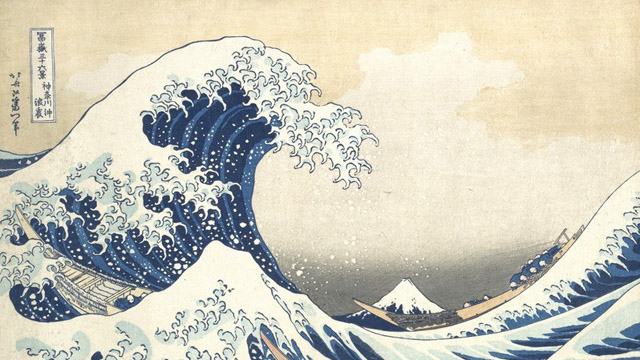
-
 Nobumasa Kiyonaga
Nobumasa KiyonagaKatsushika Hokusai, Nami-ura
Many Japanese feel astounded when they know that Hokusai is considered as the most famous Japanese artist in the Western countries. The art-historical assessment in Japan also turns out differently than one would probably expect from a Western perspective. For example, it was only in 1997 that one of his works was admitted as Japan’s cultural heritage for the first time by the Japanese Ministry of Culture.
In order to understand this understatement, one needs to understand the socio-historical context of the time of the period when Hokusai produced this work: In the Hokusai's lifetime, an ukiyo-e master was considered as a mere craftsman. This, for example, represents a strong contrast to the Kano school artists, whose focus was primarily on Chinese painting. Many of the Kano school artists worked as the shogunate’s official painters, which enabled them to be part of the warrior class. In feudal society there was an unbridgeable clear class difference between those artists and ukiyo-e masters. Moreover, ukiyo-e was considered vulgar, as it was a medium for common people and some were even pornographic. Today “ukiyo-e” specially represents Japanese woodblock prints of the later Edo period. But actually the term ukiyo originally has a Buddhism-originated, rather pessimistic meaning, namely: “transitory world”, which contrasts to the word jōdo as “pure land” or “paradise”. “Ukiyo-e” in this context would mean “images from this world”. However, it was precisely in the Edo period mentioned about the attempt of reinterpretation, especially among townspeople, to perceive, affirm and even enjoy this temporary, worldly world as something positive. Accordingly, despite its originally negative meaning of the word, motifs that came to mean everyday, life-affirming, bourgeois life were often chosen for “ukiyo-e”.
In the Hokusai's lifetime his artistry1 in this sense certainly met with positive response and interest from the townspeople in Edo (today Tokyo). But it was French art critics and modern artists at the end of the 19th century who gave Hokusai “world-class” status. With the style of the so-called Japonisme they hoped to get impulses or artistic suggestions from the color woodcuts or lacquer works to overcome the hopelessly frozen academic European art from their viewpoint; bold, asymmetrical compositions, spontaneous drawing, strong colors, overcoming the central perspective. It seems clear that the view of these Europeans on Japanese works of art was from the beginning selective. And obviously Hokusai was an ideal projection here.
In Hokusai's extensive oeuvre the “Thirty-six Views of Mount Fuji” is regarded as his main work. Among all of Hokusai’s works, “The Great Wave off Kanagawa” particularly has attached special attention in the West until the present day. Already in 1897 Camille Claudel (1864-1943) created her work “La Vague”, which was inspired by “The Great Wave” and in 1888 Vincent van Gogh (1853-1890) pointed out the special nature of this work in a letter to his brother. Eventually “The Great Wave” established itself as an “global icon” as one acknowledged today.2 According to the English art historian Christine M. E. Guth, it was decisive for the enormous spread of the picture that in the West, “The Great Wave” was chosen as the title to differ from the original “The Backside of the Wave”. In this way, the image has been separated from the original context.3
The fascination, which this work still holds globally today, certainly lies all in the geometrical or typically Japanese asymmetrical composition and the dynamic representation of the big waves. Thereby the horizon is set unusually low, which additionally serves to increase the effects. The position is actually very unnatural and almost impossible. Here it is important to point out that this perspective representation was a result of Hokusai's attempt to appropriate or interpret the European central perspective. It was in the early 18th century that the Japanese began to deal intensively with this Western style of painting. By directly connecting the foreground and the distant view without a middle ground, they found a particularly effective means of dramatic representation, which in reality deviated from the actual Western painting principles. The Japanese art historian Shigemi Inaga calls this typical Japanese expression “chūkei-datsuraku (falling out of the middle ground)”.4 Many ukiyo-e masters liked to make use of this manner. Also in Hokusai's “The Great Wave” it seems to have succeeded impressively. As already expressed in the original title “Nami-ura” (the backside of the wave), the picture draws the viewer's gaze deep into the inner side of the devouring movement of the waves. Thereby a literally sublime feeling is awakened in the observer. In front of this mighty natural phenomenon, the people in the picture look powerless, as if they were merely driven by the waves. The holy Mount Fuji silently watches all this sight from far away.
Mount Fuji, a 3776 meter high volcano, is not only the highest mountain in the country, but has been worshipped as a religious object in ancient Japan. On the one hand, Fuji with its rich water reservoir provided fertility, but on the other hand its eruptions caused great damages to the population. Accordingly, it was always regarded with a certain reverence and in the 9th century the first shrine for the fire god “Asama” was built on it. The mountain then also became a holy place for Buddhists. The Mount Fuji worship became especially popular during the Edo period. The most eloquent example is Hokusai’s “Thirty-six Views of Mount Fuji”. Otherwise Mount Fuji was chosen as subject of the painting again and again since the 11th century at the earliest. Later, at the peak of nationalism in Japan, especially during the second Sino-Japanese War and the Pacific War (1937-1945), the mountain was identified with the nation “Japan” per se and eventually became an authentic “national symbol”. After World War II it was then seen as a symbol of the new, revived Japan. Based on these historical backgrounds it seems obvious that many Japanese perceive something particularly familiar in the depiction of Fuji in the work “Nami-Ura”. In this sense, it is quite significant that Mount Fuji was recognized by UNESCO as a World Cultural Heritage in 2013, as a “sacred place and source of artistic inspiration”.
Today, the image “The Great Wave” is often used for merchandising products of museums, such as coffee mugs, plates, notebooks, ties, T-shirts, wristwatches or umbrellas, and is extremely successful. The Japanese government finally jumped on this trend at the beginning of the 21st century when it developed a state-sponsored marketing strategy based on “Cool Japan”, a neologism created by the American journalist Douglas McGray, in which the Japanese subculture such as manga or anime would play a major role. The motif was also used for the “Cool Japan” project. Guth sees this as the final recognition of Hokusai on the Japanese side.5
Inaga writes that Hokusai was an artist who had gained his unique historical significance in the international context of Japonisme "as a sociological phenomenon“.6 The shift in Hokusai's evaluation for over a century makes his creative approach a complex construct of the artistic, cultural and social development of the Edo period. Inaga notes that “many things that today are considered the essence of Japanese aesthetics were actually refined in dealing with imported culture. […] Cultural characteristics are not revealed in isolation, which shields itself from foreign influences, but rather through curiosity about the outside world“7. Especially Hokusai's art is a prime example of this statement.
Download a more detailed version of this essay by Nobumasa Kiyonaga (in German).
Footnotes
1 The concept of art with the European sense did not exist in Japan at that time yet. For this reason the author avoids the term “art“ at this point. It was only after the opening of Japan to the Western countries in the 1850s that the term was newly introduced from Europe as a translation word.
2 Christine M. E. Guth (2017): 21 Seiki no Yōroppa · Amerika bunka no naka no “Ōnami” (eng: The Great Wave in Twenty-first Century Euro-American Culture), in: exh.cat. Hokusai and Japonisme, Tōkyō: Kokuritsu seiyō bijutsukan (The National Museum of Western Art) und Yomiuri shinbun Tōkyō honsha, p. 296.
3 Guth (2017): Ibid.
4 Shigemi Inaga (1999): Kaiga no tōhō – Orientarizumu kara Japonisumu e (eng: The Orient of the Painting: Orientalism to Japonisme, Nagoya: The University of Nagoya Press, p. 90ff.
5 Guth (2017): pp. 298-299.
6 Inaga (1999): p. 174.
7 Shigemi Inaga (2018): Nihon-bijutsu-shi no kindai to sono gaibu (eng: The modernity of Japanese art and its outside) Tōkyō: Hōsōdaigaku kyōiku shikōkai, p. 33.
published June 2020
 Ernst Wagner
Ernst WagnerHokusai, The Great Wave off Kangawa
A raging sea, mighty waves, spray falling like snow from their crests. The waves form huge claws that hover precariously over the fishermen in their fragile boats. Adapting to the shape of the mighty waves, the boats’ bows thrust their way ahead towards the left. The energy of the boats speeding forward is compositionally absorbed by the propulsive force of the water pushing to the right. Hypothetically, the viewer is positioned in the water and is in just as much in danger as the oarsmen.
In the centre of the wave trough’s mighty movement, we see the static Mount Fuji diminutive in the distance. Although one could almost overlook it due to its size and similar colour to the water it is the central subject of this woodcut, one in a series of “36 views of Fuji”, completed by Hokusai. Fuji’s peak lies in the golden section and serves as a stabilising element. The mountain, holy in Shintoism[1], appears like a vision, promising (unattainable) security. A pale white cloud above it takes on the shape of the wave adding to the threatening atmosphere. It is somewhat irritating how Mount Fuji and the waves approach each other through colour, form and lines. Even the drops of water coming out of the spray look like snow falling on Fuji’s peak. The small rowers crouching in their boats do not even see the mountain. In comparison with the other pictures in the series, this sheet displays the most dramatic representation in juxtaposition to the calm steadfastness of Fuji. The other 35 sheets mostly depict Fuji in idyllic everyday scenes or in quiet, monumental sublimity. (The great differences in style show that the series was published over a span of several years.)
The composition is like a snapshot of a scene at its dramatic climax. We, the observers perceive it from the distance and, at the same time, we are right in the middle of it. The giant wave is about to crash over the boat on the left, while the other two boats, swift as arrows, are heading right into it as well. According to historical accounts, they are fishing boats that are on their way back with their catch to the mainland, to Kanagawa, a place in the bay of Edo, today's Tokyo. But none of this is visible in the print. Instead, Hokusai illustrates a powerful and dangerous nature in which men must integrate themselves in order to survive. The picture displays the fishermen nestled within the frame of the wave. In this way, Hokusai creates a timeless and emotionally moving metaphor for man at the mercy of nature. He thus takes a specific artistic position that makes him interesting in comparison with European paintings by e.g. Caspar David Friedrich or William Turner who address a similar experience.
The title and Hokusai’s name appear in the upper left corner of the print in Japanese script. The concept of combining image and script is typical for Far Eastern traditions. We can find more features that can be considered as typical for Japanese woodcuts: flatness, reduction of colours, graphic patterns (e.g. the light and dark stripes in the water) and black lines outlining or defining the objects. Hokusai uses these means with expressive exaggerations, which often take on caricature-like features, for example in the representation of the spray or the frightened fishermen in their boats.
However, since Hokusai also uses Western pictorial principles, especially the conception of space and the idea of a dramatic climax, he created his own visual language, based on his reception of Western painting. This is significantly demonstrated by his treatment of spatial depth. Looking through the waves at the central motif – in this case Mount Fuji – from an observer's point of view is committed to the Western concept of perspective formulated in the Renaissance: the picture as a window to the world, which appears in perspective. In Hokusai's work, this European concept of space merges with the traditional Japanese art of colour woodblock prints, which was characterized by emphasized two-dimensionality, contrasting empty spaces, ‘abstract’ pictorial structures, and dynamic linearity. Hokusai's mediation between two culturally different pictorial conceptions ultimately led to his being more popular in the West today than in Japan itself.
The opening of Japan after 1853, forced by US gunboat politics – and supported by European governments – triggered trade between Japan and the world. At first, some Japanese woodblock prints were used as packaging material, which may seem surprising to lovers of this art form today. Fortunately, they were discovered and enthusiastically received by artists in France. Among those were Hokusai’s prints and his popularity grew rapidly throughout Europe and elsewhere. The collecting frenzy of Japanese art (Japonism), which was also triggered by this, influenced Post-Impressionism, Art Deco and Art Nouveau and, in particular, architecture and design such as was taught at Bauhaus. Just as Western visual language came to Japan, Asian visual concepts now influenced art in Europe.
Ukiyo-e
Hokusai, trained in painting and woodblock printmaking, is considered a master of the multi-coloured ukiyo-e woodblock prints. From the early black and white prints, an extremely refined multi-colour printing process with up to fifteen woodblocks was developed during his lifetime. For the production of the plates and complicated printing process there were highly specialized workshops, for which – in our case – Hokusai provided the templates. Compared to other prints, however, relatively few plates were needed for the 'Great Wave': three for the different shades of blue, one each for the colour of the boats and the sky, and black and grey. As some of the prints found today show considerable traces of wear on the plates, we can assume that hundreds or thousands of prints were printed from the same plates. The peaceful Edo period (1603 - 1867) had led to new forms of expression as well as to the mass production of woodblock prints, such as those by Hokusai.
[1] At 3776 m, this volcano is Japan's highest mountain. Its shape is elegant and at the same time monumental, memorable and easy to recognize. In Shintoism it is a holy place. Moreover, as it has repeatedly been a "source of artistic inspiration", not only for Hokusai. It was recognized by UNESCO as a World Heritage Site in 2013.
published September 2020
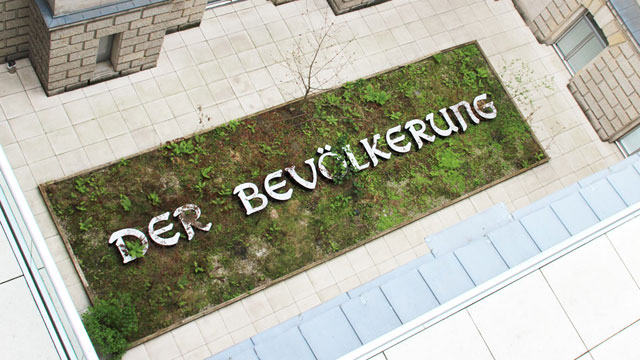
-
 Ernst Wagner
Ernst WagnerBased on the Ghanaian interpretation, it quickly became clear that certain ideological or political positions are immediately connotated with the respective image selection. These in turn are linked to historical and social experiences, which Winkler (2021) recently elaborated on the basis of the history of Germany. In our case, the West German, left-liberal intellectual milieu is of particular interest, since all the German project partners involved in the discussion can probably be assigned to such a milieu. "In the 1970s, the view prevailed among liberal and left-wing intellectuals in former West German, which objectively was not a nation state, did well to see itself as a >post-national democracy<. In the 1980s, this led to the conviction among many that the time of the nation state had passed and that Europe only had a future as a post-national union. [...] The self-destruction of one's own nation-state [in Nazi Germany - author's note] led to the conclusion that the nation-state as such had outlived its usefulness, and the term ‘national’ was equated with nationalist. [...] In Germany the idea that the nations had to merge into a European republic found a broader public echo." (Winkler 2020 p.186)
For art educators, the majority of whom probably feel committed to this idea of Germany as a post-national democracy, the question of a current symbolisation of national unity[1] is therefore obsolete. It cannot therefore be relevant to art education. A consensus in the German team on how at least the general topic could be addressed could be reached by the proposal to deal with the topic on another level, and to use Hans Haacke's installation "Der Bevölkerung" (2000, courtyard of the German parliament in Berlin) to deal with the topic of "national unity" in a contemporary art lesson.
Hans Haacke (*1936) is a German-American artist who has lived and worked in New York since 1965 and whose conceptually influenced works primarily address art-political processes.
Figure 2: View into the courtyard of the Reichstag building. © Hans Haacke / VG Bild-Kunst.Haacke's installation "Der Bevölkerung" is located in a courtyard of the Reichstag building. This architectural context is part of the work. The building was constructed at the end of the 19th century, during the Second German Empire (1871-1918). In neo-baroque style, it paid homage to the national pomp under emperor Wilhelm II. Damaged by fire in 1933, it was further damaged during the Second World War. Located directly on the Wall to East Berlin, the dome was finally blown up in 1954. In reunified Germany, however, a new function was found for the building. Rebuilt according to plans by Norman Foster in the 1990s, it now serves the German parliament, the Bundestag.

Figure 3: View of the façade of the Reichstag building with the inscription "Dem Deutschen Volke" © Hans Haacke / VG Bild-Kunst.
Hans Haacke built a 21 x 7 metre rectangular, flat wooden enclosure in this building. He then asked the MPs to gradually fill it with soil from their respective home regions. In the middle of the box, the inscription "Der Bevölkerung" (To the People / Population) can be read, in white letters illuminated from the inside. The typeface corresponds to the inscription "Dem Deutschen Volke" (To the German People / Nation), which has been on the outside of the building's west portal since 1916.[2] According to the initiator, the invitation to bring soil from the constituencies is valid as long as members are democratically elected to the German parliament. A webcam, belonging to the installation (www.bundestag.de), takes a picture every day at 2 p.m. and 8 p.m. and thus allows a take a look at the development of the project since 2000 and at the current situation.
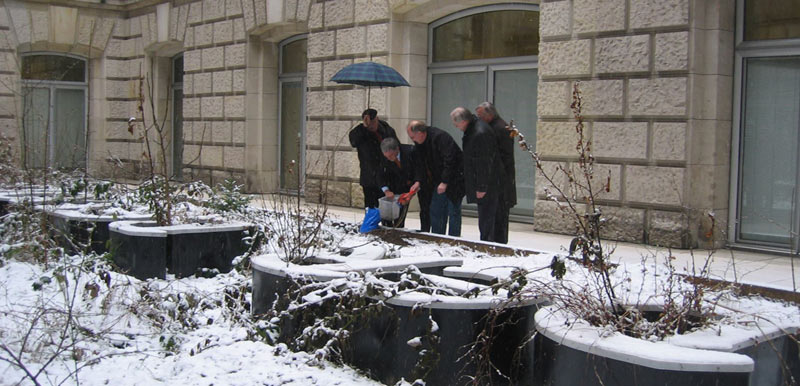
Figure 4: An MP distributes the home soil from his constituency in Haacke's installation. © Hans Haacke / VG Bild-Kunst
When Haacke proposed to install this large-scale installation in the new parliament in 1999, ten years after German reunification, it triggered a heated public discussion. Many MPs found the words "Der Bevölkerung" (To the People / Population), which appeared to be a dedication, inappropriate and provocative. Haacke was deliberately alluding to the older inscription "Dem deutschen Volke" (To the German People / Nation) on the outer façade. In contrast to this, he used the term " Bevölkerung - population" to refer to all the inhabitants of Germany, including people who do not have German citizenship and live here. According to his own statement, Haacke was inspired by Bertolt Brecht when deciding on the lettering. Brecht had written in 1935 in exile that whoever said population instead of people would avoid many lies (Brecht 1935). Haacke is obviously also concerned with the question of how words can and should be used in the context of a national parliament to designate the basis of this democratically elected representation of the people/population. Does the term "Volk" fit, a traditional, conventional but loaded and perhaps not at all accurate term? Or would be the term "population" better, a word that sounds unfamiliar and strange at first, but perhaps makes more sense. The discussion intended on such questions is part of Haacke's work.
Similar discussions were triggered by the idea of having MPs bring home soil. For many, this was reminiscent of the National Socialist blood-and-soil ideology. Or they criticised it as "kitsch" because of the well-intentioned but overused symbolism. Obviously, the work here plays with this iconographic tradition (“Heimaterde”), but reinterprets it just as it reinterprets the lettering. At the same time, the installation is constantly changing as a result - both through the ever-changing soil and through the growth of the plants over the course of the year.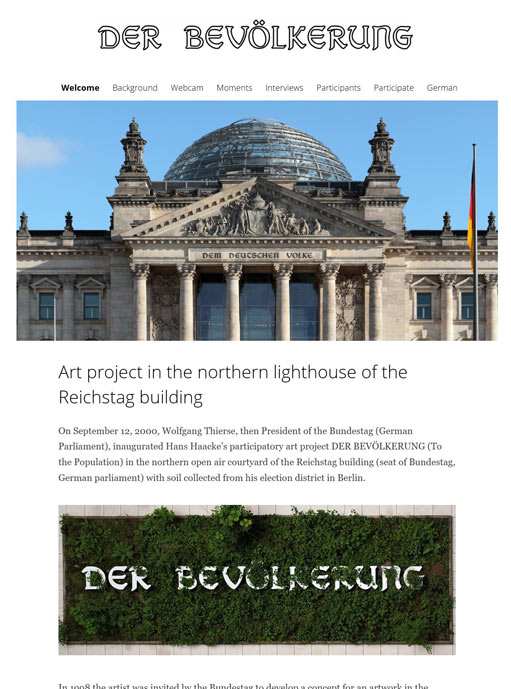
Figure 5: Screenshot of the project's website https://derbevoelkerung.de
© Hans Haacke / VG Bild-Kunst.
The installation is thus in constant dialogue with the population designated in the inscription, tries to involve the MPs and responds as a living piece of nature to the stone surroundings of the parliament building. The work of art is thus never fully completed. Haacke's art project was particularly controversial in parliament; only by a narrow majority did the MPs finally vote in favour of the realisation of the artwork in 2000 after a specially scheduled debate in the Bundestag. The entire debate is documented on the project's website - as another part of the work (Bundestagsdeabtte 2021).
[1] I.e. a "small German" solution after 1990 and with shifted borders after 1945.
[2] It was designed by the Art Nouveau artist Peter Behrens.
References
- Brecht 1935: Bertolt Brecht. Five Difficulties in Writing the Truth. www.literaturwelt.com/werke/brecht/wahrheit.html (13.10.2021)
- Bundestagsdeabtte 2021: https://derbevoelkerung.de/bundestagsdebatte/
- Kaernbach 2011: Andreas Kaernbach. Projekt „DER BEVÖLKERUNG“ im Reichstagsgebäude. https://www.bundestag.de/besuche/kunst/kuenstler/haacke/haacke-198996 (13.10.2021)
- Winkler 2020: Heinrich August Winkler. Wie wir werden, was wir sind - Eine kurze Geschichte der Deutschen. Munich (Beck)
- Winkler 2021: Heinrich August Winkler. Das widerspruchsvolle Erbe des Otto von Bismarck. In: FAZ of 18.1.2021, p.6
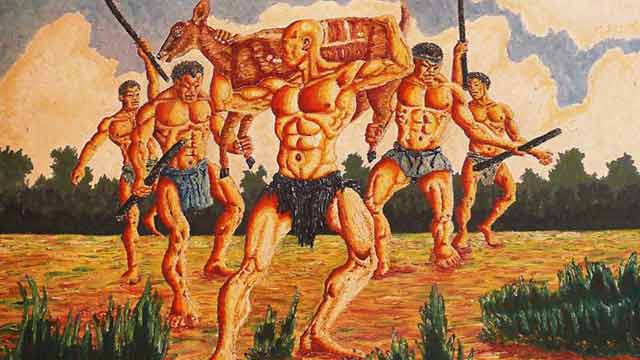
-
 Emmanuel Aklasu
Emmanuel AklasuOwusu-Ankomah’s painting at first glance reveals a foreshortening company of energetic warriors, muscular framed with broad shoulders, muscled chest, and a narrow waist in a chiselled physique. The hunters were portrayed with huge hands, clenched fist, knuckles, strong legs visibly revealing biceps brachiis and dabs of varicose veins on the arms, thighs and legs evident of powerful and efficacious men. Before modern society, the average male spent most of their time hunting, protecting, and engaging in physical activities that increased their muscle mass and maximize their muscular proportions. Owusu-Ankomah’s production exhibits masculine competitiveness and a sense of adventure – the brave team were a-fire with passion, armed with sticks in a leopard-like graceful movement as the captain leads carrying a captured antelope shoulder high.
The warriors are noticeably naked with only a string of grass costume wrapped around the private parts which is the formal and ceremonial attire for the ancient culture. Owusu-Ankomah’s choice of colour in rendering the human figures lends credence to the fact that colours have a strong position in identifying humans while hunting. Wearing hunter orange is the best way to ensure other hunters see you and don’t accidentally mistake you for game in complex backgrounds that are often green or brown. The artwork reveals harmonizing brown colours which tend to create a central focal point in the entire picture frame to evoke earthiness, emotions, security and safety related to the natural world. The tints and shades of hues enhanced the main features in the painting to vividly communicate the intended message as well as create an illusion of depth.
A thick flora forms the background of the painting evident that the hunting expedition was carried out in a thick forest. As the fearless, able-bodied men advance through shrubs in high spirit of mission accomplished, an earthly scent swirled around them coupled with a sense of eagerness to meet a welcoming, expectant and jubilant community. Hunting is an extremely important mode of human-nature interaction closely linked to culture patterns and value systems. This engagement with wild animals is thought of as part of a deeper unity with nature, which means being part of nature in physical sense (Lowassa et al., 2012). Sustainable hunting prescribes taking as much as needed and as much as the habitat and the population can regenerate. Suffice to say, when hunting for a game form the basis of a year-long survival of a people, it calls for a deeper reflection. Owusu-Ankomah’s painting comes on the back of an ancient heritage of a distinct tribe in Sub-Saharan Africa.
‘Aboakyir’ translated ‘deer hunt’ is a festival uniquely celebrated by the Effutu (Simpa) people of Winneba in the Central Region, southern coast of Ghana, West Africa. The festival which is celebrated annually on the first Saturday in May has the historical antecedent of the replacement of a human sacrifice to a tribal god with a leopard – an alternative which resulted in the loss of many more lives than the sacrifice of a single slave. Consultations with the deity for a more humane alternative resulted in the “Wansan” (the deer) as a practicable and most acceptable substitute. The capture of a live deer, like the leopard, required many more hands than the members of the royal family could find. The additional hands required were solicited from the local militia as a service to ‘the stool – a symbol of chieftaincy, royalty, custom and tradition’. It was this change in form; that is, the involvement of the local militia, that the annual consecration and appeasement of the deity became a public, state-wide affair. This marked the birth and hence the origin of the “Aboakyer” festival.
The design of the Effutu State emblem tells this story; the ‘stool’ on which the King is installed sits on the “Wansan” (the deer).

Emblem of the Effutu state (Source: Palace of Oma Odefe)
The festival is therefore important for the ‘stool’, its occupant and the entire royal stool family. It is a religious duty and an obligation for the general citizenry to ensure its celebration annually is sustained to honour the ancestors and protect their historic culture for posterity on the back of removing evil and predicting a good harvest for a prosperous life in the coming year. The week-long activity begins with two traditional warrior groups known as the ‘Asafo’ companies consult their shrines for clearance, protection and early catch. The warrior groups clad in distinct costumes with distinct musical instruments — the ‘Tuafo' and ‘Dentsefo’, move to their respective hunting grounds at dawn on Saturday, wielding sticks and clubs amid chanting of war songs. No weapons, other than clubs and sticks are used to catch the deer, as it must be brought back alive.
By far, the relevance of Owusu-Ankomah’s painting is not in doubt as it fosters a deeper understanding of the historical and societal roles of hunting within Ghanaian communities. The painting holds both cultural and educational significance which sparks discussions on conservation, sustainable practices, and the preservation of cultural heritage. Consequently, bridging the gap between present generations and the rich tapestry of cultural and environmental history. The sight of the painting in Ghana’s National Museum serves as a poignant reflection of the nation’s cultural heritage and connection to nature. In this visual narrative, the core of historical period of a distinct society is unearthed.
References
- Lowassa, A., Tadie, D. & Fischer, A. (2012). On the role of women in bushmeat hunting – Insights from Tanzania and Ethiopia. Journal of Rural Studies 28(4):622–630.
Further Reading
- Anane-Frimpong, D. (2022). Aboakyir: Deer hunt festival. Link Retrieved on April 10, 2023
- Rubiano, W. (2017). Planting trees for the aboakyer festival 2017. Link
Published March 2024
 Barbara Lutz-Sterzenbach
Barbara Lutz-SterzenbachAn energetic scene. Five men in a flat landscape approach the viewer. Their bodies are naked - except for their loincloths - their faces grim. Muscles in the bright light stand out under the skin, their chests bulge voluminously - they are timeless heroes. The men do not look at the viewer of the picture. With their long, dark sticks firmly in their strong hands, they gather symmetrically around the bald man in the foreground. He presents himself with an antelope in his raised arms. His bald skull points to the left, as does the antelope's head.
On closer inspection, some things are irritating. Are the men dancing or walking? Where is the animal spatially located? Somehow it is on the shoulder of the man, but the legs are captured by the men behind, who would be much too far away for that. Is an event, an episode (as in a photograph) depicted? Or does the symmetry of the composition speak more of a constructed symbol, a sign, as in an emblem? The latter would support the strict division into horizontal planes: with the islands of grass in the foreground, the flat, ochre-coloured plane in the middle ground and the forest with sky in the background. But then again many design principles undermine this order: the tense, energetic movements of the figures, the strong brushstrokes, the irregular shapes of the white clouds and the tufts of grass, the dynamic accents of the sticks.
We know from our Ghanaian colleagues that what is depicted here, the catching of the animal, is part of a ritual celebration and a festival (the Aboakyer Festival). Here the moment is shown when the men have stepped out of the dark, hermetically sealed forest in the background with their prey and now present themselves in the bright light with their success. A comparison with the results of an image search on the internet for “Aboakyer festival” (Fig. 2) shows that this is the iconic moment. Here the idea of the festival seems to be condensed. And this also explains the emphasis on muscles: the hunters must be well trained to match the animal's speed and strength.
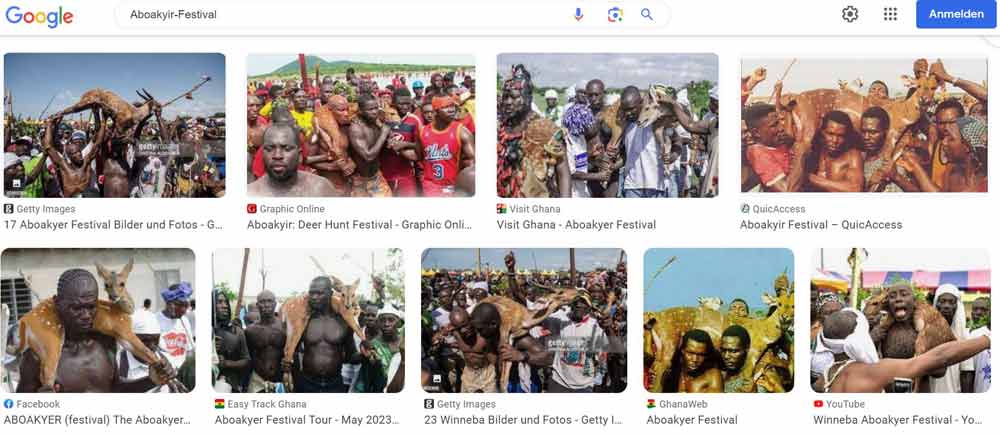
Fig. 2 (Google search for "Aboakyer Festival" on 9.9.2023 - the first page of results) Screenshot: Ernst Wagner
Owuso-Ankomah's painting focuses on the men with the animal. At first glance, the painting shows above all the strength of the men. The space thus becomes the backdrop for their performance. Their bodies are not only idealised but theatrically exaggerated, their muscles as if illuminated by a spotlight. The geometric centre of the picture, through which the horizon also passes, brings the loincloth of the leader into focus (see fig. 3) - perhaps an allusion to male potency?
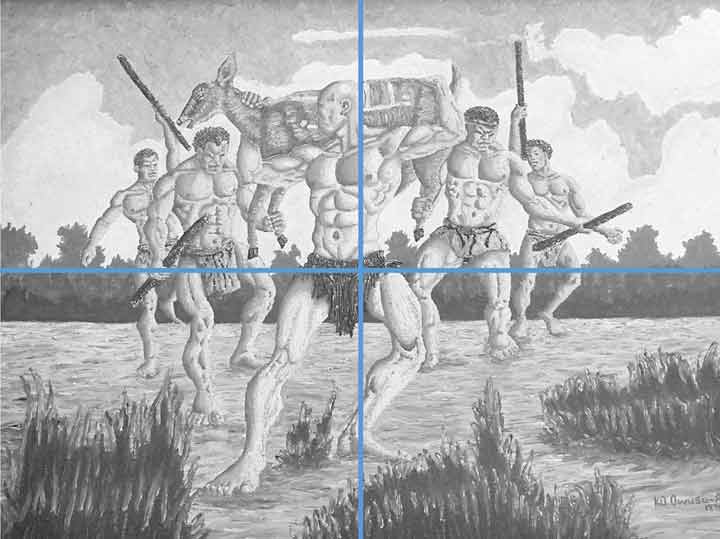
Fig. 3: Composition sketch (horizon and geometric centre) Photo: Ernst Wagner
A comparison with photos on the same theme from the Heritage Centre in Winneba (see Fig. 4-6) shows clear differences to the depiction in Owusu-Ankomah's painting. In the artwork, both animal and hunter have their mouths open, exhaustion is evident in both. In this way, too, man, animal and landscape are connected - despite hunting and death. The artist uses the warm ochre tones in such a way that the earth, the human body and the animal hardly differ in colour. Since the animal is still alive, its head does not have to be held. Thus, visually, it seems to elude a depiction of "being trapped", also due to the ambiguous spatiality described above. It could almost just as easily be understood as a triumphant appearance of the animal, to which the men are subordinate as bearers and assistant figures - comparable, for example, to Jan van Eyck's depiction of the lamb (see fig. 7), which also marks a mediating position between victim and victor, between human beings and God.

Fig. 4-6: Photos from the Heritage Centre Winneba Photos: Ernst Wagner
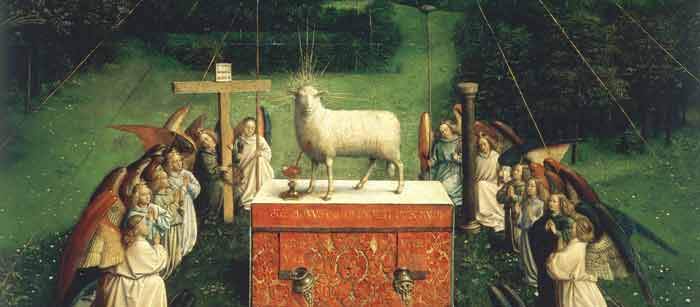
Fig. 7: Van Eyck, Lamb of God, Image Detail: Ghent Altar. Oil on wood, 350 x 461 cm
Cathedral of St Bavo, Ghenthttps://commons.wikimedia.org/w/index.php?curid=109213 [28.10.2024]
This image sets against each other contradictory concepts: static-symmetrical-ordered vs. dynamic; accidental situation vs. deliberate staging; documentation vs. sign; hyperrealism in body and space vs. symbolic charge. It sets these contradictions against each other in the unity of the painting.
Reference
Published March 2024

-
 Kerstin Pinther
Kerstin PintherAs a miniature, the sculpture Indépendence Tchao (2014) by the Franco-Algerian artist Kader Attia refers to the Hôtel de l'Indépendence in Dakar, Senegal. At the beginning of the1970s – a little over ten years after the independence of the west African country under Lépold Sédar Senghor and a few years after the first Festial Mondial des arts nègres (1966), the hotel was built by Henri Chomette and Roland Depret. Since the end of the 1940s and into the 1980s, the office of the French architects had built governemental and private buildings and others in numerous African countries. Indépendence Tchao was initially created as a site-specific installation on the occasion of the 11th Dakar Bienniale in Senegal. It refers back to the hotel high-rise with the sculpture; the ‘borrowing’ can immediately be recognized, above all by its characteristic brise-soleil façade. Kader Attia used discarded and somewhat rusty inex index boxes, stacked on top of each other. The inventory of the archive itself came from a dissolved administration in Algeria. Only a few kilometres away from the central exhibition venue of Dak'Art, the hotel still forms a striking, decidedly 'modern' architectural antithesis to the flat neo-classical colonial administrative buildings - an aesthetic incunabulum that symbolized the future in its outstanding verticality and modern furnishings. However, the former architectural icon is now empty and in a state of decay. Indépendence Tchao (the title is a reference to the famous song Independence Cha-cha from 1960/Kalle) thus refers both to a utopia that has grown fragile, the bursting of a dream; as well as to the persistence of colonial archiving and (also structural) standardization practices, to old and new (architect) networks in the postcolony.
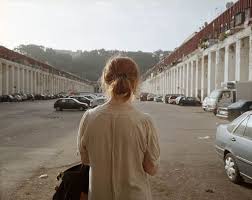
Attia, Kadar. Pascale, Fernand Pouillon, Alger. 2012
https://inferno-magazine.com/2012/06/23/kader-attia-le-corps-utopique/ [Stand: 28.10.24]
Two further - this time photographic - works by the same artist also address the ambivalences and potentials of modern architectural promises: In the case of the photograph of a woman, seen from behind, surrounded by the mighty arcades of the 200-column courtyard, the connection between the body as the 'first architecture' and the 'built' architecture is central. Not least through the title Pascale, Fernand Pouillon, Alger (2012), it becomes apparent that the person is a transsexual. According to Attia in an interview, the strangeness in one's own body corresponds to the 'architectural' alienation that the inhabitants of the 'Climat de France' who had resettled from the Kasbah in Algier must have felt in the 1950s; the necessity of appropriation, re-territorialisation or even 'becoming at home' applies to both bodies (the human and the architectural).
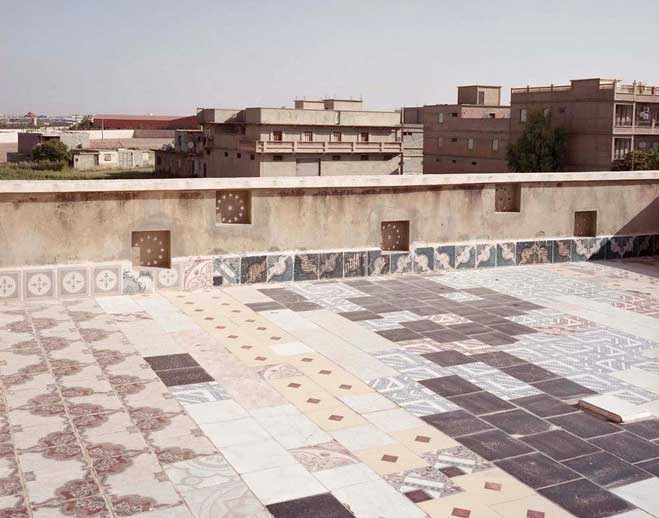
Attia, Kadar. Déconstruir - Reinventer. 2012
https://slash-paris.com/en/evenements/construire-deconstruire-reconstruire-le-corps-utopique/sous/3669 [Stand: 28.10.24]
A reflection on transgression and imagination also lies at the centre of another photo: Déconstruir - Reinventer (2012) actually shows only the results of a minimal intervention in the standardized construction method, and yet these traces of spatial action are marked here as meaningful in the sense of aesthetic place-making.
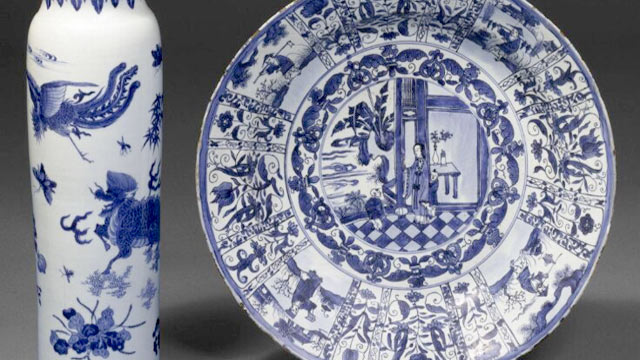
-
 Dong Xiaoling
Dong XiaolingIn the 13th century, when traffic and information were sparse, Marco Polo, a Venetian, came to China by land and served the Chinese Yuan imperial court from 1275 to 1295. The white Chinese porcelain vases, which he took back to his motherland and which are archived at San Marco Museum in Venice today, are reputed as a symbol of the Chinese vogue that went viral in Europe 300 years later. The Travels of Marco Polo has stirred European’s imagination of China[1] , and also promoted Europe's maritime exploration.
However, before the opening of the new sea route between China and Europe in the 15th century, Chinese porcelains were rarely exported to the European market as a commodity. The trade of Chinese porcelains to Europe was monopolized by Arab merchants, while European merchants could only obtain fewer Chinese porcelains from West Asia and Egypt in the form of intermediary trade. Unlike silk and spices, which were easy to carry and transport, Chinese porcelains were mostly sold locally by means of land transportation because of their fragility and weight. They were closely connected with local culture, after which they were imprinted with local aesthetic characteristics and shipped to Europe. However, Chinese porcelains were not what they had always been. Forerunner of great geographical discoveries as he was, Zheng made seven large-scale ocean voyages during Ming Dynasty from 1405 to 1433, but did not establish direct contact with Europe.
Comparatively, European humanism and capitalism were at an embryo stage. From the 15th century to the 17th century, European fleets represented by Portugal, Spain and the Netherlands carried out sailing explorations in order to seek new trade routes and trading partners as well as develop the capitalism in Europe.
First, Chinese porcelains were shipped to Europe as ballast. However, the European upper class favoured them by virtue of their smooth texture, delicate and hard casing and exquisite emblazonment. European royal nobles and bishops all were keen on owning Chinese porcelains to show off their wealth and status. European royal families’ love to Chinese porcelains did not ease in spite of the fact that they had little understanding of the materials and techniques and far away China. Philip II of Spain (1527-1598) had a collection of 3,000 pieces. Although Europe started importing Chinese porcelains on a big scale, a mysterious atmosphere always clung to these exquisite utensils. At that time, some people in Europe even thought that Chinese porcelains could play an anti-virus effect.
The French doctor Loys Guyon (1527-1617) and Sir Thomas Browne (1605-1682) of England studied Chinese porcelains. Père Francois Xavier d'Entrecolles (1664-1741), a French missionary, was in Jingdezhen, China, for 7 years during the 17th century. In 1712 and 1722, he wrote reports on the details of Chinese porcelains making which he observed and inquired into and mailed them back to the Jesuits in Europe, making it possible for French to imitate porcelains locally.
Already in 1575, Italian Medici Grand Duke Francesco's factory made an attempt to produce porcelains, which was the first imitation recorded in Europe. Such a kind of Medici pottery bottle with blue and white patterns is collected in the Louvre. Both the white glazed blue painted pottery in Delft, the Netherlands, and the Nevers kiln in France have imitated the decorative style of Chinese porcelains. However, in terms of materials, they came in pottery or soft porcelain. The alchemist Bottger did not calcinate the earliest European porcelain at Meissen, Germany until 1709. In this process, the aesthetic taste in Europe had gradually changed. The fashion of loving oriental artifacts had gradually spread from nobles to rich bourgeoisie. As the demand for relatively cheap goods had also become more and more vigorous, porcelains had gradually turned a part of the daily life of the common. The nature of Chinese porcelain had gradually changed from collectibles to daily commodities.
In order to meet the needs of European society, East India Companies in European countries imported a large number of porcelains from China in the 17th and 18th centuries. In China, this kind of porcelain for export was called export-purpose Chinese porcelain.[2] From the change of shape and pattern the export-purpose Chinese porcelains can be roughly classified into traditional styles, hybrid styles and foreign styles.
1. Traditional styles (The shape and decoration of porcelain have not been influenced by foreign styles, and are no different from products on the Chinese market.)
From the opening of the new sea route in the 16th century to the lift of the ban on maritime trade in 1684, it was illegal for Chinese to export porcelains. As per the ban on maritime trade in the Ming Dynasty, non-governmental maritime trade was strictly prohibited, while official tribute trade was allowed with strict restrictions. Foreign countries could only conduct limited official trade with the Ming authorities. Since then, the Qing authorities have repeated the ban on maritime trade. The production and shipment then were at great risks.
Merchants usually purchased Chinese porcelains in Guangzhou and then shipped them abroad from Macao, making the export-purpose Chinese porcelains dominated by traditional Chinese style at this stage. It influenced the early stage of the Chinese style in Europe as well as the reproduction and imitation of Chinese porcelain with soft pottery in Europe. Chinese porcelains were mainly used as daily necessities, such as dishes, bowls, bottles and pots. But there were few ornamental porcelains as well. The decorative patterns mostly came in cloud-dragons, deer, horses, cranes, monkeys, flying butterflies, birds and insects, folding branches and flowers, fairy ladies with babies, city walls with mountains and waters, auspicious characters, etc.
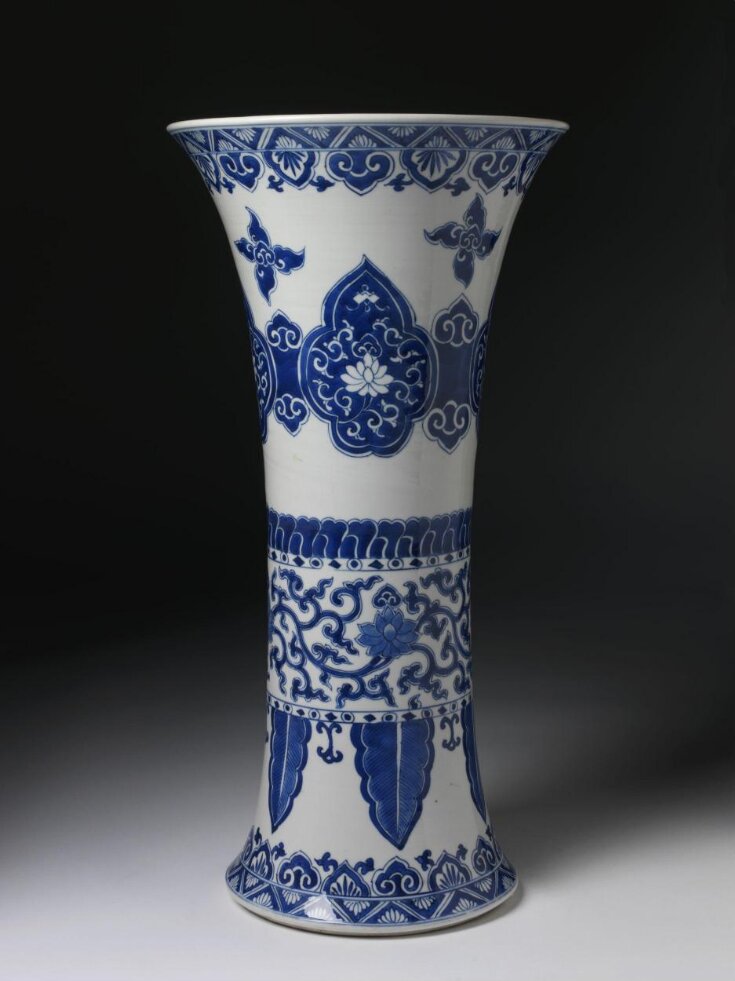
Unknown, Blue and white porcelain vase, 1700-1710, Victoria and Albert Museum London.
The style of blue-and-white porcelains represented the life of the easterners to Europeans. A great number of Chinese porcelains of this kind are recorded in the archives of Dutch East India Company.
On the one hand, few Chinese porcelains were exported to Europe with a higher price; on the other hand, the pure oriental shape made Chinese porcelains deviate from the daily needs of Europeans. For example, easterners’ habit of eating rice and using chopsticks makes bowls the most common utensils in the East, while westerners’ custom of eating bread and using knives and forks has not made bowls, with a deep-walled shape, the mainstream of European tableware by far. Because the typical Chinese tableware consists of fewer parts compared to Western dining habits, Chinese porcelain dishes could only be used for holding cakes and pastries in Europe. For example, porcelain pen containers were used as wine cooler, and porcelain fish tanks were used as flowerpots... Chinese porcelains were constrained in terms of use, and often modified or displayed as ornaments. Therefore, a new style came out in the course of development.
2. Hybrid styles. (Chinese traditional style couples with foreign ornaments and vise versa, or Eastern themes couple with Western ones for hybrid ornaments.)
It is the stage of free transformation of Chinese style porcelains. Among this type, porcelain with traditional Chinese themes, or a mixture of different themes from China and Europe, combined with European shapes is the most representative. Part of the changes in the shape of European porcelain came from metalware, and part from the changes in lifestyle brought about by trade. For example, since the 17th century, Europeans have been importing black tea and coffee from the East and chocolate from Mexico. These hot drinks come brown in color after brewing, and white Chinese porcelains serve as the most suitable drinking utensils. The emergence of new eating habits has promoted the transformation of Chinese porcelain utensils. The Dutch enlarged the size of traditional Chinese small teacups and designed a lug.[3] Kraak porcelain[4] and Mandarin style were the most representative.
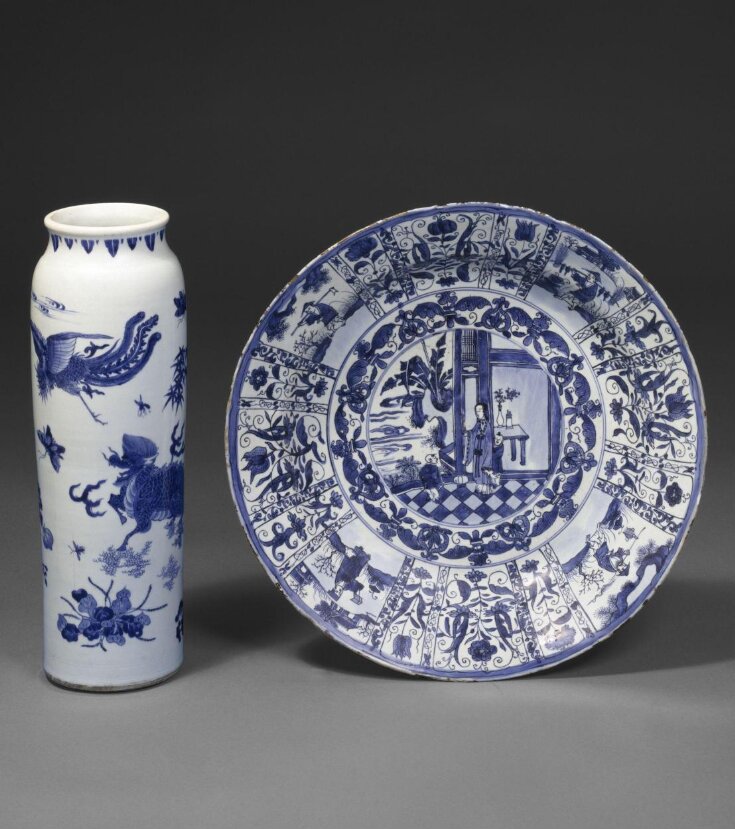
Unknown, Dish, ca. 1635-1655, Kraak Porcelain, Diameter: 47,5 cm, Bibliographic Reference: Clunas, Craig (ed.). Chinese Export Art and Design. London: Victoria and Albert Museum, 1987, p. 38, fig. 16.
Kraak porcelain is a form of blue and white porcelain exported from Wanli Period of Ming Dynasty (1573-1620) to early Qing Dynasty. It was mainly shaped in dishes, bottles and bowls, and represented by trimmed patterns. These patterns came round, diamond-shaped and lotus petal-shaped, with designs of flowers, birds, fish and insects, landscapes, figures and auspicious mascots commonly seen in Chinese porcelains. Later, exotic religious myths and social life themes appeared in trimmed patterns. In terms of techniques, the traditional way of drawing the outline of the pattern on the surface of the porcelain body with a writing brush and then filling it in with color was adopted. Kraak porcelain is a kind of export-purpose porcelain with the largest quantity and the longest influence period of more than 100 years. After that, blue and white porcelain in Kangxi Period (1662-1722) of Qing Dynasty came in western rendering techniques in drawing, showing a maximum of eight or nine color gradations on the porcelain body. And it drew much popularity among westerners.
The word “Mandarin” was a name for Chinese officials when Portuguese traded with Chinese merchants in the 17th century. In the 17th and 18th centuries, many missionaries and painters came to China and recorded their experiences there, including their life and work with Chinese officials in addition to preaching.
Most of the decorative patterns depicted the life of officials and wealthy merchants in Qing Dynasty, who enjoyed a rich and leisurely family life. These descriptions and landscape paintings further aroused European‘s curiosity about live in China. Aiming at this market opportunity, Guangzhou Porcelain Workshop launched Mandarin style products for European and American markets. Some patterns use the perspective technology of European oil paintings, and the expressions of the characters are vivid, which conforms to the aesthetic orientation of Europeans. These patterns presented a desirable pastoral oriental atmosphere for westerners. Playing in picturesque courtyard gardens, hunting in enchanting springtime, harmonious coexistence between human beings and nature, and vivid home life scenes embodied elegant Chinese costumes, fascinating home decoration, exquisite garden scenes, and charming family happiness. These themes greatly satisfied Europeans’ curiosity and yearning for the East.
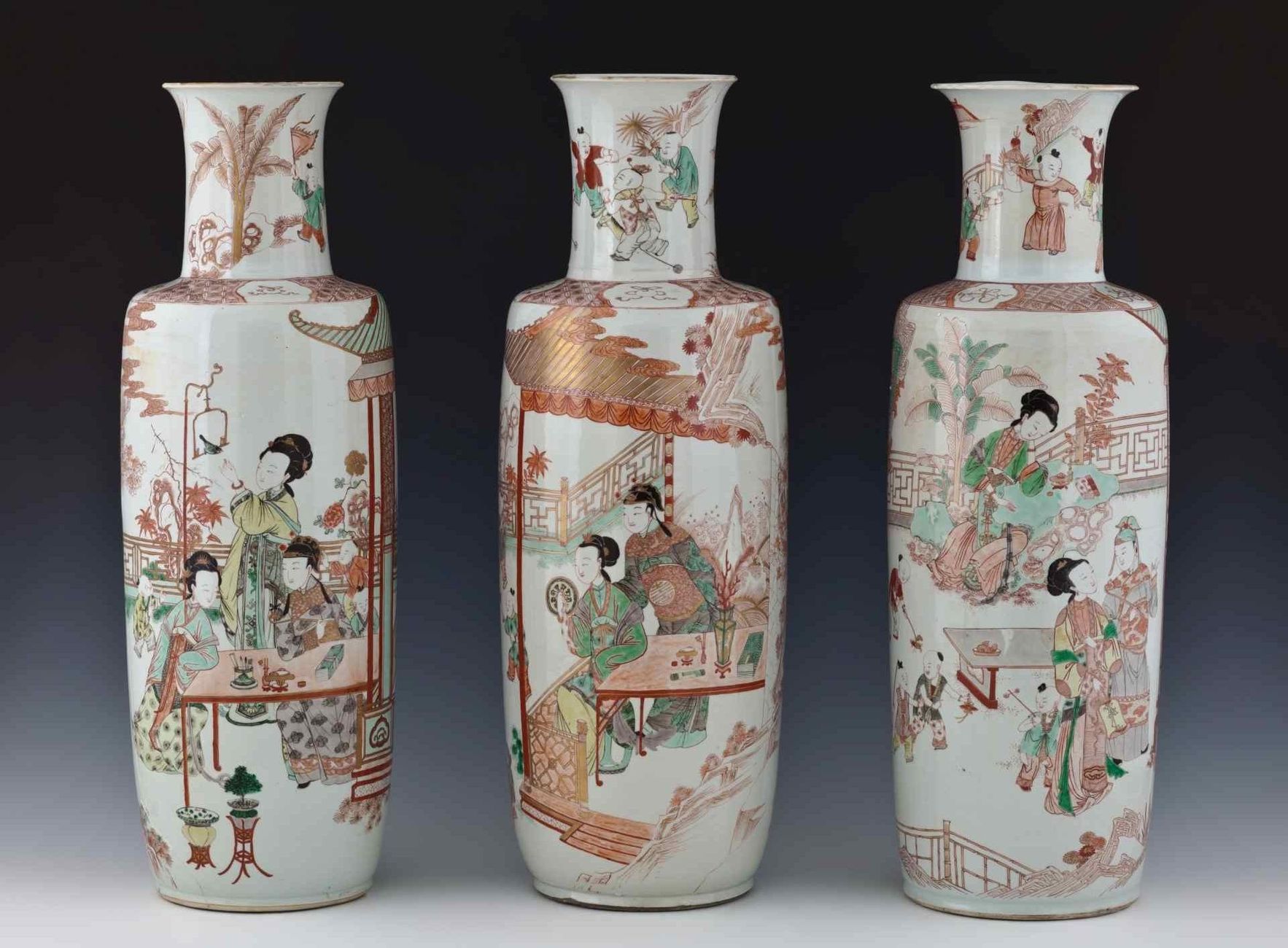
Unknown, Three Vases, 1700-1720, Procelain, Jingdezhen, Staatliche Kunstsammlungen Dresden.
3. Foreign styles. (Chinese porcelains satisfying the requirements of European merchants in terms of shapes and patterns, calcined elaborately to serve European consumers’ needs. Most of the patterns were drawn in strict accordance with the prints and patterns as required by customers, so they were usually called custom-made porcelains.)
One type was produced in the 17th century. Since Europe had not yet mastered the technology of porcelain-making, Chinese porcelain workers imitated the pottery of European style according to the requirements of European merchants. Chinese Porcelain competed with European pottery in this way and earned a lot of silver used as currency.
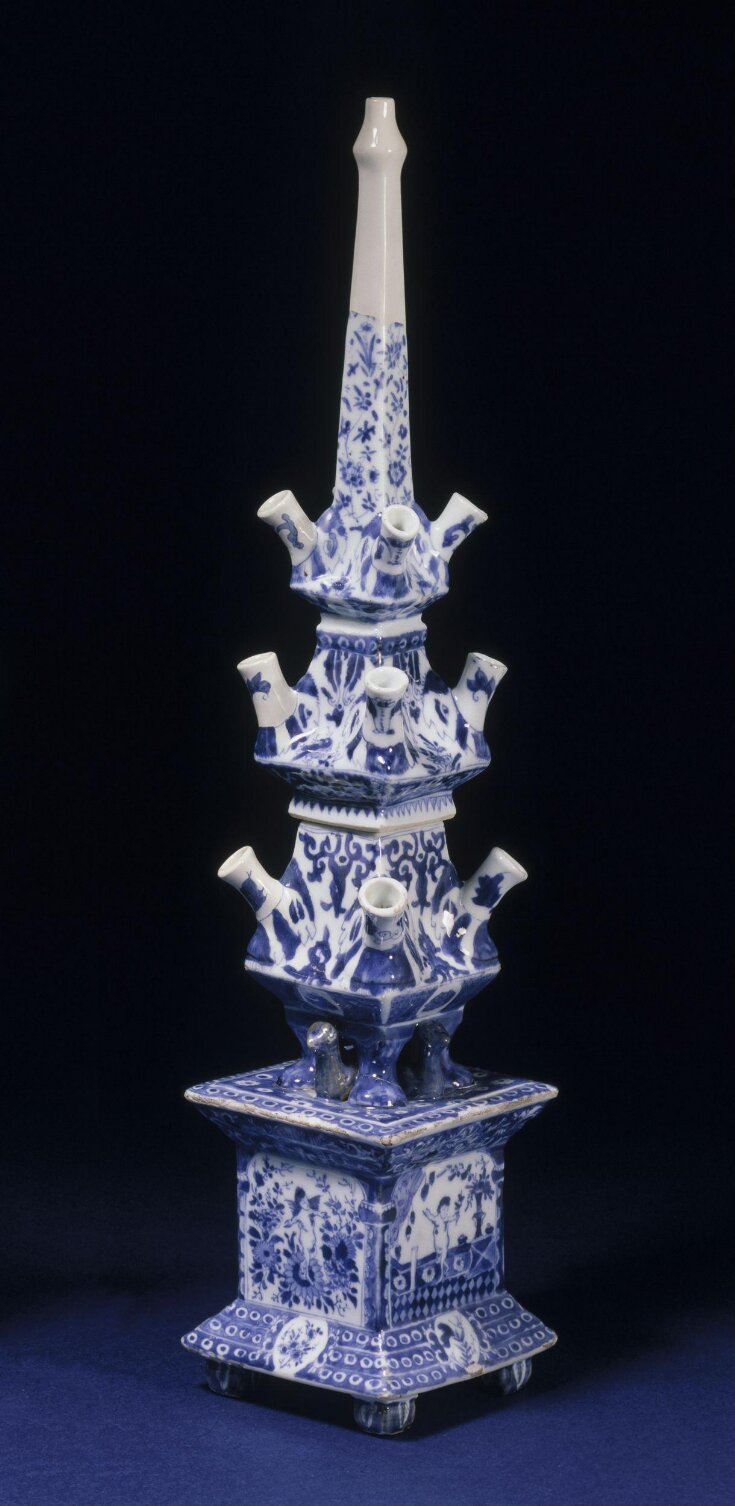
Unknown, Vase with Angel, 1700, Porcelain, H: 36cm, Victoria and Albert Museum London. Bibliographic Reference: Clunas, Craig (ed.). Chinese Export Art and Design. London: Victoria and Albert Museum, 1987, p. 60, fig. 40.
Another type emerged when the Chinese style in the West reached its peak in the 18th century and Chinese characters and landscapes imagined by Westerners appeared in the patterns. The pictures are humorous and interesting, while the number is quite limited. In addition, there were porcelain carvings, figures and animals.
The pattern was typically formed by heraldry (the special signs of European and American aristocratic guilds, groups, etc. In the 18th century, China sold up to 600,000 kinds of heraldry porcelain to Europe). In addition, characters (out of Greek or Roman fairy tales, the Bible, European customs-based sketches), ships, landscapes, flowers, etc. used to be popular themes among Europeans. Besides, European living habits were taken into consideration in terms of modeling.
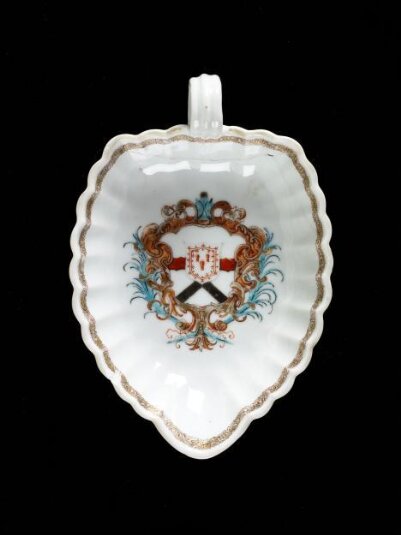
Unknown, Souceboat, ca. 1740, Porcelain, L: 18,4cm, Victoria and Albert Museum London. Bibliographic Reference: Howard, David Santuary. Chinese Armorial Porcelain. London: Faber and Faber Limited, 1974, p. 295.
Apart from blue and white, multicolored and famille rose ones were among this kind of style. Because of the higher cost, longer period of capital occupation, more complicated procedures and greater commercial risks, this variety did not turn a mainstream among export-purpose Chinese porcelains in spite of their distinctive features. Especially in 1769, the first production line of British Wedgwood Porcelain Plant rolled off, when European porcelain production began to leap from the handicraft era to the industrial era. Since then, importing Chinese porcelains has grown unprofitable, and the porcelains in Chinese style turned gradually out of date.
In the course of trade development for nearly 300 years from the 16th century to 19th century, from “Made in China” to “Making Chinese Porcelains”, the Chinese vogue going viral in Europe represented a process of Europeanization of Chinese cultural practices. In this process, lacquerware, woven carpets, clothing, furniture, wallpaper and garden architecture were as well used for reference, quotation and modification in Europe, and finally integrated into the social context of Europe, influencing and even changing the artistic outlook of Europe. Nowadays, the shortened distance and accessible information across the world enable us to see the diversity of cultures more quickly and accurately. More possibilities for cultural exchanges will definitely be springing up in the future.
FOOTNOTES
[1] China in the 13th-19th centuries was only a Far East country geographically along with India, Southeast Asia, South Korea and Japan
[2] Due to the limited space, the export-purpose Chinese porcelain in this paper refers specifically to the exported ones to Europe.
[3] Lin Lin's, Research on Porcelain Trade of Dutch East India Company in the 17th-18th Centuries, pp 31-34.
[4] Its name probably originated from Portugal Caraack, meaning “giant merchant ship”.
REFERENCES
- WangYong, A History of Art Exchange between China and Abroad, Beijing, 2013
- Shanggang, A new compilation of the history of Chinese arts and crafts, Higher Education Press , 2007
- Etiemble, L’Europe Chinoise. The Commercial Press, Beijing, 2013
- Liwei, Through the silk Road, Beijing, 2018
- Hugh Honour,Chinoiserie: The vision of Cathay, Peking University Press, 2017
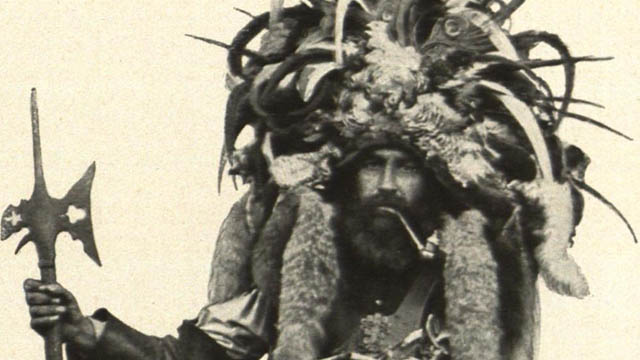
-
 Werner Bloß
Werner BloßAdministrative, esoteric and patriotic purposes until the first half of the 19th century
After an initial sighting the clothing can still prove to be expectable in the context of its time and regionality. While the medieval weapon seems useful for the guard's task, the hat's purpose can be seriously doubted. But peculiar as the outfit might be, it must have identified its possible former wearer as a civil servant, who was authorized, e.g. to punish violations of the rules. To protect the vineyard, a Saltner had to be reliable, vigilant, fearless, persuasive and loud. In addition to this executive function, there was also an esoteric one: Myths have developed claiming that a Saltner is able to defend himself successfully not only against thieves and ravenous animals, but also against attacks from the otherworld. Thus, the formerly more modest hat might have taken on a fetish-like function as well, alongside an expectedly Christian context — similar to the magic „Hexenkreuz“ (a shoe-length iron forged in the shape of a cross, von Hörmann 1872, p. 41-47) which should be part of the equipment of a Saltner too.
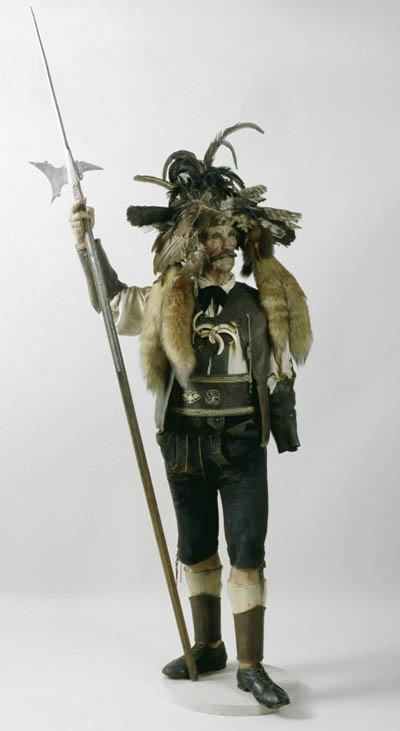
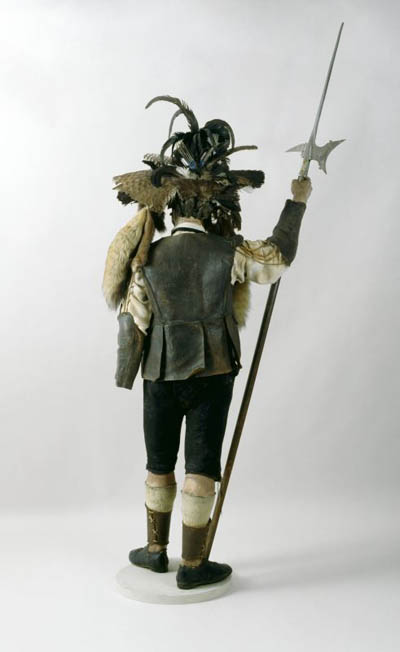
Fig. 1, 2: Meraner Saltner, Germanisches Nationalmuseum, 1875/1899 © Germanisches Nationalmuseum
In addition, there are other striking features of the costume. Apart from the hat, many handed down costumes of vineyard keepers look very similar to that of an outstanding Tyrolean folk hero. As to the beard, most vineyard keepers on contemporary pictures also come very close to Andreas Hofer, the leader of the Tyrolean popular uprising of 1809 (fig. 3). Thus, two hero constructions could be woven into the image of these objects: the brave guardian with supernatural powers and the defiant folk hero who successfully defended his country against the Bavarian occupiers (at least for a short time).
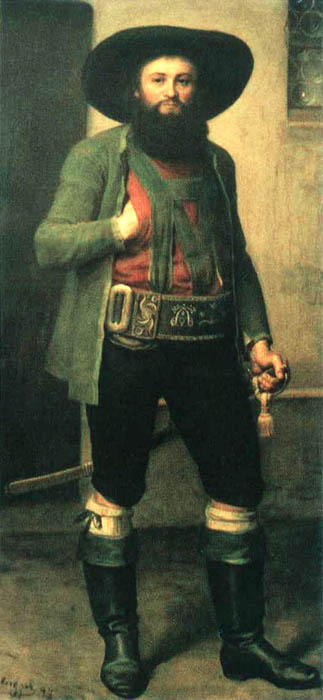
Fig. 3: Franz Defregger: Andreas Hofer, 1894, oil on canvas, Tiroler Kaiserjägermuseum, Innsbruck (© CC-BY-4.0 CC)
Tourist purposes in the course of 19th century
A steady evolution of this appearance towards hypertrophic splendor (cf. Ramming 1997, p. 119) could be observed. Whom did the vineyard keepers want to impress? Did the scary outfit or its models also have the function of a lure, even a courtship dress? One could speculate a lot about this, as well as the question of the addressees and the success of this posing in the rural environment. Indeed, there were harsh rules that state how vineyard keepers had to behave towards women (cf. von Hörmann 1872). Like the myths of nocturnal seduction attempts by witches in the vineyard, they also point to the possibility of their transgression (Matscher 1933, p. 217). The clearest indications of courtship even in the sexual are found indirectly where the vineyard keepers discovered their tourist attractiveness in the later 19th century. Here it was not only a matter of inspiring the exoticism expected from the outside. The Saltner in the role of „Papageno“ (Halbritter 2005, p. 88) offered a masculine performance to a changing — even female — audience, too. And the public, frightened by the wild man in the vineyard, gladly paid for this thrill with the usual, officially regulated tax for trespassing — and then sent a postcard with a picture of such a strange imposing guy out into the world (op. cit. p. 88-104, fig. 4).
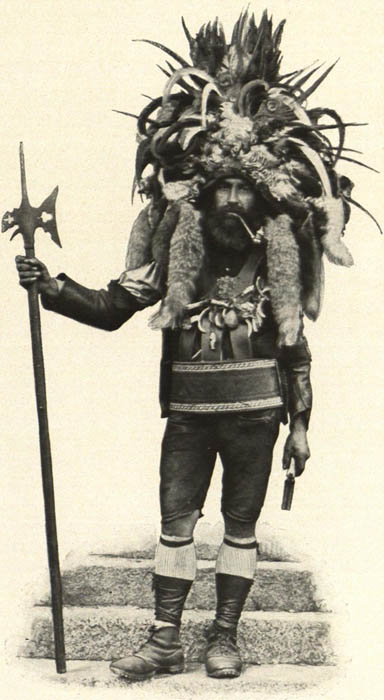
Fig. 4: Meraner Saltner. Postcard sent 1907. © CC-BY-4.0 austria-forum.org
Use in the attempt of nation building until after 1900
The emergence of traditional costumes in the 19th century was due to an increased interest in regional distinctiveness. The dependence on supra-regional trade, a corresponding desire for a special appearance and the burgeoning tourism in picturesque South Tyrol drove this development further. The purchase of the object by the GNM in 1899 was completely in line with the museum's historistic concept. Unique characteristics were to be collected to support the idea of nation-building in the German-speaking area which includes parts of South Tyrol (Austria till 1918, then Italy) too. The interest in the costume can thus be attributed to an implicit concept of „Großdeutschland“, the desire for identification even far beyond the national borders of that time (and also today). In 1905 the Saltner-figurine became a part of a multi-figure panorama of German traditional costumes in the museum. But 100 years later Jutta Zander-Seidel, curator of the exhibition „Kleiderwechsel“ (that means "change of clothes") at the GNM judged harshly about the former exhibition practice: Neither does the object represent the peasant costume of the past in its historical authenticity, nor does it reach beyond documents of historicized festive culture at that time (cf. Zander-Seidel 2002, p. 76).
From carnival use to cultural appropriation and appreciation
On top of that, the object wasn't even bought in South Tyrol at all, but from a Munich costume fund. The painter Franz Defregger is said to have worn it at a Munich artists' masked ball in 1883 (Ramming 1997, p. 16-18). Was it merely a product of his imagination, made to poke fun at the strangers across the near borders, at those archaic mountain people with their culture, which at the time was perceived as weird, backward, even exotic? There is evidence that Defregger designed costumes too (Irgens 2010, p. 14).
Then it would also be possible that parts of the costume were actually copied, e.g. by using early photographs of Native Americans, perhaps to make the appearance seem even more exotic. The foxtails hanging down on both sides of the face, the necklace of wild animal teeth or the splendor of the feathers come quite close to such cliché images. And Franz Defregger showed great interest in Chief Rocky Bear, for example, whom he met and portrayed in 1890. Rocky Bear had come to Munich (Bavaria) with Buffalo Bills' Wild West Show as a living exhibit (Assmann e.a. 2020, p. 123). But this was seven years after the masked ball. In addition, the object at the GNM is said to have been touched up in the early 20th century, so that it could fit the cliché of the pictorial and written sources of the 19th century even better (Selheim 2005, p. 274).
In the same supposedly colonialist view, Defregger made a painting for an Austrian encyclopedia called „Kronprinzenwerk“ (1885-1902, fig. 5). In this illustration, the figure of the Saltner is used just as clichéd and exoticizing for his country, Tyrol, as we know it, e.g. from images of snake charmers and the Indian subcontinent. But the picture shows a man who looks much like both the Nuremberg specimen – and the artist himself. Could this still be a form of self-exaltation, an act of othering (Said 1985)? If we take into account that Defregger himself was a native Tyrolean, this perspective escapes its chauvinistic dress and shows us a completely opposite form of individual expression and a corresponding search for identification: When abroad, the successful painter dressed like a person of status in his native country.
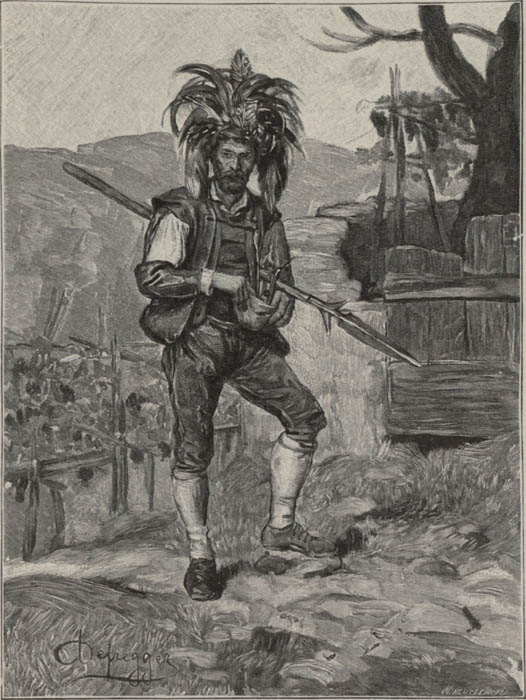
Fig. 5: Franz Defregger: Ein Saltner bei Meran. 1890, Xylography by M. Kluszewski. © CC-BY-4.0 austria-forum.org
Conclusion
It has taken one century for this change in function to be clearly named in the GNM (cf. Zander-Seidel 2002, p. 148): from an uncertain practical object of use to a product of tourist expectations, from a carnival costume to a decided construction of national identification and back again. The outfit of the vineyard keeper is neither particularly artistic nor valuable. But the questions it is able to generate lead far into a dense field of visual communication across times, national borders and continents, to ideas of foreignness and (self-) exoticization and ultimately to the question of how we deal with them today. The costume of the Saltner and its related outfits seem to come from the supposedly “good old time“. But they illuminate a rather fleeting moment in which historical upheavals in Europe (e.g. early globalization, increased emigration, advanced secularization, consequences of colonialism, desperate search for identity and nation building) are reflected in a peculiar object. They can lead to the question of how to deal with other traditions on the one hand or with the individualization of (male) appearance (e.g. in the later star cult) on the other. The fact that a whimsical hat can still serve an extremely dubious yet visually powerful purpose today was demonstrated by the million-fold shared footage of the self-proclaimed "shaman" storming the Washington Capitol in early 2021.
Special thanks to my students at Gymnasium Wendelstein who enriched this analysis with plenty of valuable questions and discoveries.
References
- Assmann, Peter/Irgens-Defregger, Angelika/Hess, Helmut. 2020. Defregger. Mythos — Missbrauch — Moderne. Innsbruck, München: Hirmer.
- Ramming, Jochen. 1997. Weinberghüter und Heimatwächter. Der ‚Meraner Saltner‘ zwischen Amt und Emblem. In: Jahrbuch für Volkskunde 20. Paderborn. München. Wien. Zürich: Schöningh. p. 116-141.
- Halbritter, Roland. 2005. Saltner – Weinberghüter – Touristenschreck – Vogelscheuche – Papageno – Alpenindianer. „Ihm gebe Kreizer a comprar tabacco; dann still sein gut Freund“. In: Der Schlern, Bozen. August edition 2005, p. 88-104.
- Irgens, Angelika. 2010. Was Tiroler und Indianer im Herzen verbindet, Bayerische Staatszeitung (BSZ). 23.04.2010 (ePaper) and: Unser Bayern 4/2010, München (Verlag Bayerische Staatszeitung)
- von Hörmann, Ludwig. 1872. Die Saltner. In: Der Alpenfreund, Monatshefte für Verbreitung von Alpenkunde unter Jung und Alt in populären Schilderungen aus dem Gesammtgebiet der Alpenwelt und mit praktischen Winken zur genußvollen Bereisung derselben. Dr. Eduard Amthor (ed.), Volume 5, Gera, p. 41-47, proofread for SAGEN.at by Mag. Renate Erhart, august 2005. Spelling carefully reworked and brought up to date: http://www.sagen.at/doku/hoermann_beitraege/saltner.html. Called on 7.02.2021
- Matscher, Hans. 1933. Der Burggräfler in Glaube und Sage. Bozen 1933. Found at sagen.at and carefully reworked by Leoni Wallner. December 2005. http://www.sagen.at/texte/sagen/italien/meran/burggraefler_matscher/wimmetzeit.htm. Called on 7.02.2021.
- Said, Edward. 1985. Orientalism: Western Conceptions of the Orient. London: Penguin Books.
- Selheim, Claudia. 2005. Die Entdeckung der Tracht um 1900. Die Sammlung Oskar Kling zur ländlichen Kleidung im Germanischen Nationalmuseum. Published by Germanisches Nationalmuseum Nürnberg.
- Zander-Seidel, Jutta (ed.). 2002. Kleiderwechsel. Frauen-, Männer- und Kinderkleidung des 18. bis 20. Jahrhunderts (Die Schausammlungen des Germanischen Nationalmuseums). Published by Germanisches Nationalmuseum Nürnberg.
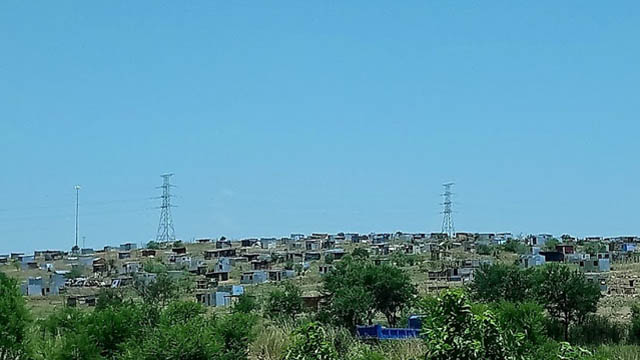
-
 Esther Kibuka-Sebitosi
Esther Kibuka-SebitosiIt is 25 years since South Africa achieved a democratically elected government in 1994. Nelson Mandela, who was imprisoned for 27 years, became the first black president after years of apartheid system governing the Republic. What is apartheid and what were some of the effects on housing? The Sustainable Development Goal 11 aims to make cities safe and sustainable; ensuring access to safe and affordable housing and building slum settlements into decent houses. It also calls for investment in roads, transport, creating green spaces and improving urban planning. This would envisage participatory planning and inclusive development. The image demonstrates the complexities of participatory planning and urban development in previously divided societies.
Historical perspectives
South African history can be divided into distinct phases: pre-colonial era, colonial era, post-colonial era, apartheid era and the post-apartheid era. During these periods, many different historic events characterised by violent clashes between the indigenous people and european settlers forcefully displacing them from their land occurred. The cultural differences were used to oppress and marginalise the people while racial tensions underlying the political oppressions were extensive. The shack is an object that symbolyses not only the oppression in living conditions, but also inequalities in economics and infrastructure.
Apartheid systems created shacks
Between 1948 and 1991, the system of administration in South Africa was apartheid. It was a National party system of racial discrimination and human rights violation. Fundamental to it was the Homeland Citizens Act of 1970, which augmented the Native Land Act of 1931 through the establishment of the so-called Homelands or reservations. The Act authorised the forceful removal of black people from urban centres to “Bantustans”. Surprisingly the apartheid perpetrators and sympathizers quoted a similar act in India where the British had done similar things without backlash from international community.
The typical Township in South Africa refers to underdeveloped segregated areas established from the 19th century until the end of the apartheid era to cater for non-whites namely Indians, “Africans” (meaning black) and people of colour. The Townships were located on the periphery of towns and cities. The Diepsloot Township in the image above therefore fits its purpose to serve the affluent towns because of its location along the highway.
The images show the shacks in Diepsloot Township. Close to 1.4 million people live in Diepsloot Township. Characteristically, such areas abound with crime, violent protests due to lack of basic services and overcrowding. The township is also full of diversity of culture, tribes, tradition and many nationalities, due to rural to urban migration. The major problems include unemployment, poverty and lack of basic services which result from lack of education and skills. Coupled with deprivation of water, sanitation and basic infrastructure, shack living environments are unsustainable and challenging sustainable cities.
In South Africa, the term “township” and “location” refers to segregated urban areas that arose from the late 19th century that were reserved for non-whites (Indians, blacks and people of colour). Built on the periphery of towns and cities, townships integrated the roots and systems of apartheid so deeply that they are almost difficult to eradicate. Despite strides made over the past twenty five years to provide decent housing for the majority of the population, Townships and shacks in particular still exist. As part of the mining industry, the black population comprising men lived in hostels and servants' accommodations. With increasing urbanization, the rapid urban expansion could not keep up with the influx of people which led to overcrowding. In the 1950s, townships in the Witwatersrand areas grew exponentially as the gold rush expanded. The shack township settlements were of poor quality but provided advantage over the hostels in more established areas as they were cheaper and not regulated by the apartheid government. With increasing eviction of black people from “white” areas, the forced removals resulted into a broad movement into segregated townships creating the designated race groups - black, coloured and Indians per the Population Registration Act of 1950 and the Group Areas Act.
With the fall of apartheid in 1994, the townships still persisted because it was a systemic problem that can only be solved in a multi-sectoral way. Typically, most towns in South Africa have a township associated with them. The New Democracy has created modern developments in townships since 1994 for example building wealthy homes and middle class income homes. In Soweto for instance there are many new developments. Hence "township" is changing its meaning and ways as it no longer means the original apartheid low income location but a home for the growing middle class. This has resulted in properties and real estate development in the townships. Although many houses were built inofficially, the government has improved the access to water, electricity and roads that impact on the quality of life. The biggest challenge is to make the progress sustainable. With plans to build the sewage system, water and electricity, townships are increasingly attract young people. As they belong to the generation of millennials, who want to stay connected globally, it is not surprising that the shacks in townships have connected to digital devices and satellite television, after all, the people have to live their life. A study in Diepsloot showed that 24% of the residents lived in brick structures, 43% in shacks and 27% in backyard shacks (additional units build on a plot of land by the landlord to get extra income (Harber, 2011).
Summary
The shacks are small constructions built on the periphery of towns and cities to provide cheap accommodation to the growing number of people working in towns or cities. The discovery of diamonds and gold in the 19th century in South Africa had a profound impact on the wealth of the region, propelling it into world stage competition for industrialisation. This was a fundamental shift from an agrarian-based economy with effects on the people and society. Not only were conflicts between the “Boer” farmers and the British Empire created, but also conflicts among the black natives as the groups fought for control over resources of the mining industry. These fights continued to define the mining industry for years and years. One sphere impacted was the human settlements. Between 1948 to 1994, the country was dominated by Afrikaner nationalism led by systems of racial segregation and a white minority rule called the apartheid, an Afrikaans word meaning “separateness”. The blacks, Indians and people of colour were forcibly removed from their land into Homelands or townships. With increasing demand for housing, shacks provided a cheaper option close to towns and cities. With no basic services, the areas continue to challenge governments as they are in need of building sustainable cities and sustainable solutions.
Shacks remind us of the lived experiences of people wanting to create sustainable livelihood in the economy. Given the opportunity of a job in a town or city, the viable option would be to live in a shack that is cheaper than brick construction. The downside is the lack of basic infrastructure and basic services for the population who want to participate in the economy. The dual economy in South Africa comprises the affluent businesses listed on the Johannesburg stock exchange and the basic township economy. People who want to participate have to choose between living in a shack or to be excluded from economy. The contradictions of the creation of jobs without viable sustainable housing options leads to the perpetuation to the segregation. An extension of two cities - two economies. Shacks on one side of the highways and the affluent middle class on the other side. The images show the contradictions and frustrations of moving towards sustainable cities in a country divided by inequalities.
This phenomenon is not only a South African one, but known worldwide: In Brazil and Mexico there are also areas divided by inequalities of social, economical and recently technological divide.
References:
- Harber, A. (2011) Diepsloot, Jeppestown: Jonathan Ball Publishers LTD, 2011. 2011. 1-226. Print.
- Tinashe, P. (2014). We have a story to tell — Diepsloot youth: A quest for safe space and opportunities to earn a living. (PDF).
- Rosa Luxemburg Stating. p. 2. Retrieved 9 November 2018.
- Foster, D. (2012): After Mandela: The Struggle for Freedom in Post-Apartheid South Africa
- https://unequalscenes.com/alexandra-sandton Retrieved 22 Jan 2019
- https://www.google.com/search?rlz=1C1EODB_enZA550ZA550&tbm=isch&q=shacks+in+Townships+near+Lanseria+Airport&chips=q:shacks+in+townships+near+lanseria+airport,online_chips:apartheid,online_chips:gauteng,online_chips:apartheid+museum&usg=AI4_-kTUvSb-CcNIqEavZu8utwO5g7HbUg&sa=X&ved=0ahUKEwislenZooLgAhXUQxUIHeIRDOYQ4lYILSgC&biw=1025&bih=587&dpr=1, Retrieved 25 January, 2019.
published April 2020
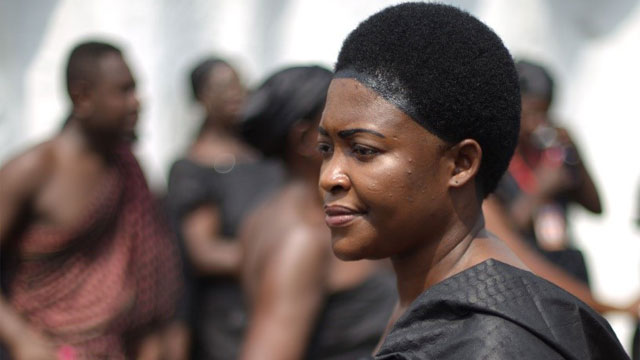
-
 Osuanyi Quaicoo Essel
Osuanyi Quaicoo EsselDifferent cultures may practise different hair beauty culture. Some of the hair beauty cultural practise could be unisex or may distinguish between sexes. In this instance, hair becomes a tool for sexual differentiation and serves as a precursor to one’s gender. It may tell which part of the world a person hails from. That notwithstanding, one may borrow hairstyles from different cultures other than his or her own for fashionable reasons since fashion inspiration is multicultural. Based on the cultural orientation and the role of a particular hairstyle to a group, society or institution, hair aesthetic ideals may be preserved as a tool for identity construction. A typical example of a hairstyle that has remained resilient even in the face of (neo)colonial and imperial hair aesthetic regimentation of the West on Africa is kentenkye hairstyle (Akan Women’s Hairstyle, 2008), popularly renamed as dansikran. Legendary has it that, queen mother Nana Kwaadu Yiadom II, (1917 - 1945), the sister of Nana Prempeh I, of the Asante Kingdom, performed the majestic Adowa dance during the restoration of the Asante Confederacy around 1935 in her kentenkye hairstyle, which inspired the then Governor’s description of her kentenkye hairstyle as a 'dancing crown' (Akrase, 2008) due to its visual effect during the dance. The phrase ‘dancing crown’ was linguistically corrupted as dansinkran which has become the popular name of the hairstyle.
The dansinkran hairstyle is noted for its simple, yet iconic stature in purely indigenous Ghanaian cultural milieu. Its selection was informed by its historical epoch, purely indigenous natural hair beauty care and treatment and socio-political significance in Ghanaian chieftaincy. It has proven to be an unadulterated Ghanaian hair fashion practice necessary in the decolonisation of hair fashion discourse. It is important in the decolonisation of hair discourse in the sense that it is purely Afrocentric which has evolved from its symbolic status to contemporary appropriation. The use of purely natural and sustainable hair treatment cosmetics with little or no harmful effect on the body makes it worthy of handing down to youth. This is because, there has been influx of artificial hair cosmetics with detrimental dermal effects which many youth subscribe to in the name of modernity without recourse to its side effects. The historical significance and interest of this hairstyle for posterity, especially as something of Africa practise, contributes in this regard to the decolonisation process. Dansinkran polity and politics among Akan kings, queens, chiefdom and the society in general reinforced its choice.
This hairstyle is achieved by trimming down the peripheries of the crown of the head almost to the skin while the remaining portions are trimmed to define the oval shape of a wearer’s head. The haircut gives the head a calabash-like shape. A natural black pomade-like colourant mixture composed of powered charcoal, soot and sheabutter, is then applied to the hair to give it intense blackened appearance. Charcoal has been in use for hair treatment in precolonial Ghana for many centuries. Considering the intense heat coupled with dust particle in Ghana and other African countries, the use of charcoal as hair treatment helped to protect their hairs from dust build up, dirt, oil and sebum that settled on scalp and negatively affects hair quality and growth. It implies that charcoal promotes hair growth. The natural hair colourant used in this process armours the hair with lustre and protection against bacteria and fungi. It nourishes the scalp and protects it from dandruff infections and maintains the hair’s natural moisture level. The eye lashes are also darkened to complement the facial look of a wearer.
The haircut helps to focus on the facials of a wearer since the hair receives little or no elaborate ornamentation. Usually, queen mothers who wear this hairstyle are not supposed to wear earrings during possessions or durbars. Judging from the benefits of charcoal in natural hair treatment it is not surprising that it features as essential ingredient in modern cosmetics manufacturing.
The dansinkran hairstyle serves as a socio-cultural barometer, political signifier and as a religious marker. This hairstyle help to identify queen mothers and female kings from other females. It is a symbolic hairstyle that was a preserve of the Akan feminine chiefdom and royals. Some priestesses also wear this hairstyle. Politically, the hairstyle symbolises authority, royalty and power of a female king or queen mother. In this sense, the hairstyle is status-defining in terms of the social rank. It is considered as inevitable lifestyle heritage that needs to be preserved among the chiefdom. When a king or chief passes on, a queen mother who is not wearing that hairstyle is not allowed to pay homage to him/her.
In the case of queen mothers, they complement this hairstyle with a feminine Ghanaian fashion classic named queen mothers’ style. This classic consists of a wraparound fashion of a six-yard fabric that stretches from the chest regions to beyond the knee, which is accentuated by another six-yard fabric draped in toga style. The wearing of this classic in addition to the hairstyle has bestowed onto it, the name dansinkran, hence, both the hairstyle and the classic are named as such. Despite the symbolism of the hairstyle, it now worn by the youth in contemporary times. It has acquired the name sweat. The only difference is that the youth who wear the hairstyle do not apply the charcoal mixture on their hairs. It has become unisex hairstyle among the youth.
The Western hair superiority politics could not erode the many centuries old hair identity visual code and marker that characterised the majority of the chieftaincy institutions in Ghana. As a traditional lifestyle culture that has proved unyielding despite black hair discrimination and politics, it is an important tool in the decolonisation of Afrocentric hair beauty culture practice and education.
References
- Akan Women’s Hairstyle. (2008). Retrieved from https://www.abibitumi.com/community/culture/akan-womens-hairstyles/
- Akrase, N. (2008). Pomp, power and majesty. Retrieved from http://akrase.blogspot.com/2008_01_01_archive.html
published March 2020



